How

THE KNOWLEDGE / THE PRACTICE / THE BUSINESS / THE EVIDENCE MARCH/APRIL 2023 THE KNOWLEDGE It’s time to Activate 2028, says IOSH THE PRACTICE Zero harm and undesired behaviours THE BUSINESS Is ‘OSH-washing’ the new greenwashing? THE EVIDENCE Safeguarding MSK health in young people
moral injury and distress are bubbling up to cause burnout







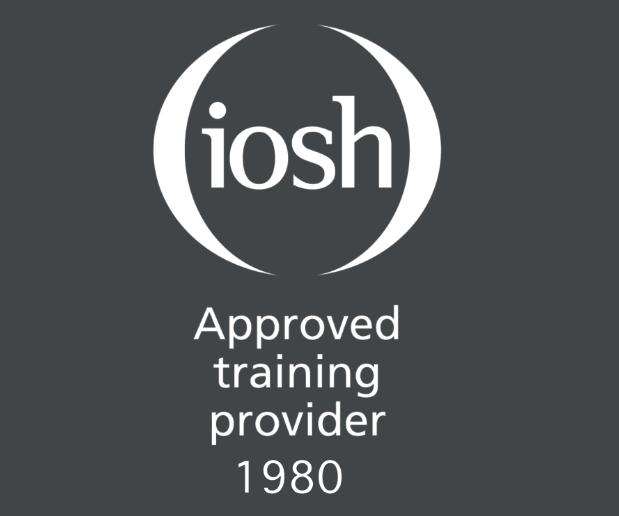



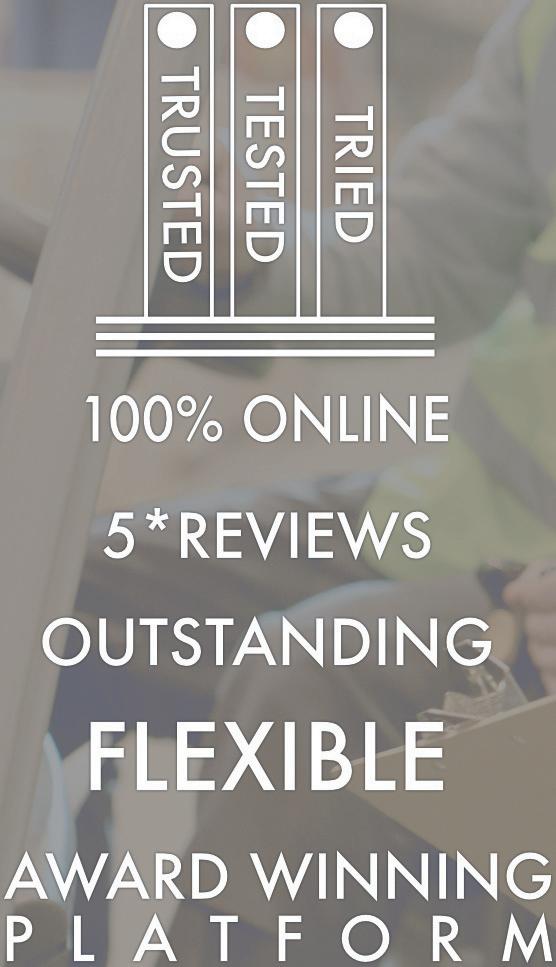
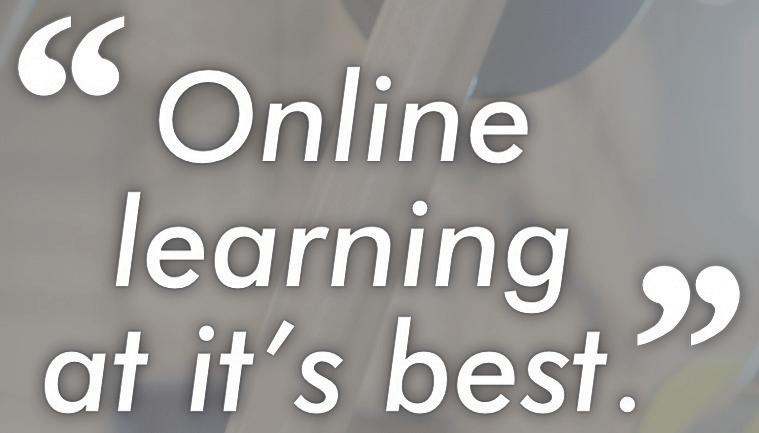
Refresher Timefora TheIOSHOnlineExperts Proudtobean'Outstanding'TrainingProvider www.first4safety.co.uk
Published by Redactive Publishing Ltd
9 Dallington Street, London, EC1V 0LN
EDITOR
Emma Godfrey emma.godfrey@ioshmagazine.com

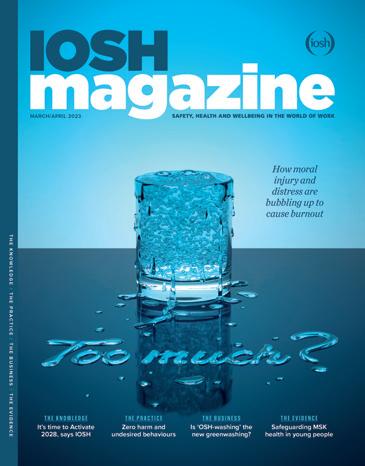
DEPUTY EDITOR
Sally Hales

CONTENT SUB-EDITORS

James Hundleby, Amy Beveridge
DIGITAL EDITOR
Kellie Mundell kellie.mundell@ioshmagazine.com
DESIGNER
Craig Bowyer
PICTURERESEARCHER

Claire Echavarry
ADVERTISING
Display sales +44 (0) 20 7880 7613 ioshdisplay@redactive.co.uk
Recruitment sales +44 (0) 20 7880 7662 ioshjobs@redactive.co.uk
PRODUCTION
Rachel Young +44 (0) 20 7880 6209 rachel.young@redactive.co.uk
PUBLISHINGDIRECTOR
Aaron Nicholls
Redactive aims to provide authoritative and accurate information at all times. Its publications are, however, for guidance only and are not an official information source.
The inclusion of advertisements and inserts within IOSH magazine and ioshmagazine.com does not constitute an endorsement of the organisation or its products/ services by IOSH or Redactive. All advertisements must adhere to the British Code of Advertising Practice.
All rights reserved. No part of this publication may be reproduced, stored in a retrieval system or transmitted in any form or by any means, electronic, mechanical or otherwise, without the prior written consent of the publisher and editor.
For changes to your address,
Leading from the front
Our profession has come a long way. Since we launched our previous strategy, WORK 2022, significant global developments have thrust OSH into the limelight like never before. And it is crucial that we build on this to ensure we are at the front and centre of building sustainable organisations and protecting their most important asset – their people.
It is with this in mind that the IOSH Board of Trustees, Council, staff, members and volunteers have been working together to develop our strategy, which will set out our ambition and delivery for the next five years. We are incredibly excited to be launching this in the coming weeks. We have been keen for it to be a process of evolution, enabling us to build on our collective successes.
As a charity and a Chartered professional body, IOSH exists for the public good. This has led to the development of three public benefit statements, each linked to our charitable objects, which I’m delighted to share here.
• • We champion and support the right to a safe and healthy world of work. We shine a light on best practice through strategic partnerships with NGOs, as well as campaigns, educational resources and case studies, which are freely available to guide businesses, governments,
regulators and investors applying OSH at an organisational or policy level. As a result, workers’ lives are protected, their families supported and communities strengthened.
• • We create inclusive physical and virtual communities, connecting members and partners so knowledge, tools and techniques are shared, and a culture of support and positive peer-to-peer interaction is nurtured. To ensure these communities thrive, we invest in research and outreach to further professional standards and knowledge. This has influence beyond our membership, and so can have positive impacts on workforces across the world.
• • We set world-class professional standards for the profession through the IOSH competency framework. We provide and accredit training and education that supports professionals to develop and be recognised and trusted for their expertise through IOSH membership. When employers and the public see an IOSH member, they know they have the best person to enable a safe and healthy world of work.
By showing how we’ll deliver public benefit through these statements, we’ll showcase how IOSH’s work, along with the power of our extraordinary members, can improve everyone’s working lives and help us realise our vision, which remains clear: a safe and healthy world of work.
Vanessa Harwood-Whitcher CHIEF EXECUTIVE, IOSH

• Read more about our public benefit statements, how they link to charitable objects and our new values on page 23.

please contact IOSH
on membership@iosh.com or 0116 257 3198.
2396-7447 © IOSH 2023 OFFICIAL MAGAZINE OF The Institution of Occupational Safety and Health (IOSH) is the world’s leading professional body for people responsible for safety and health in the workplace. IOSH magazine is printed by ISO 14001 certified printers. Printed by Warners Midlands plc, The Maltings, Manor Lane, Bourne, PE10 9PH
membership team
ISSN
WELCOME IOSH MAGAZINE 3
WHEN EMPLOYERS SEE AN IOSH MEMBER AT WORK, THEY KNOW THEY HAVE THE BEST PERSON
HIGH HOPES
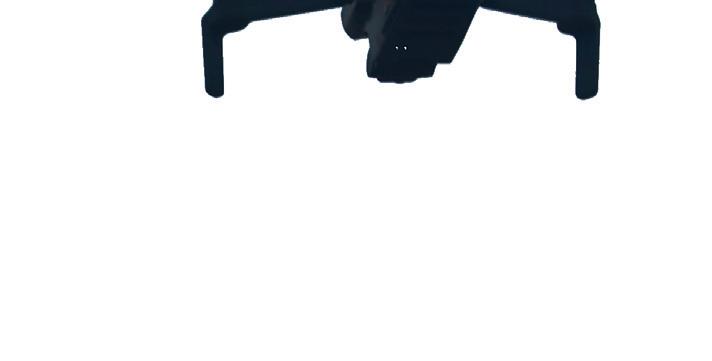

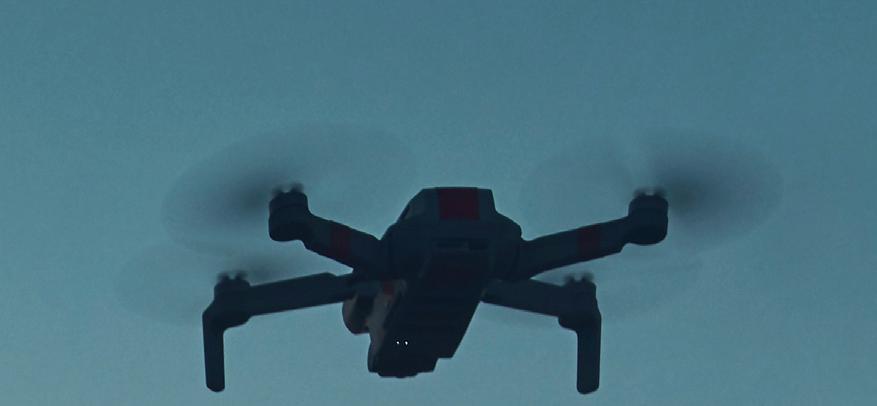











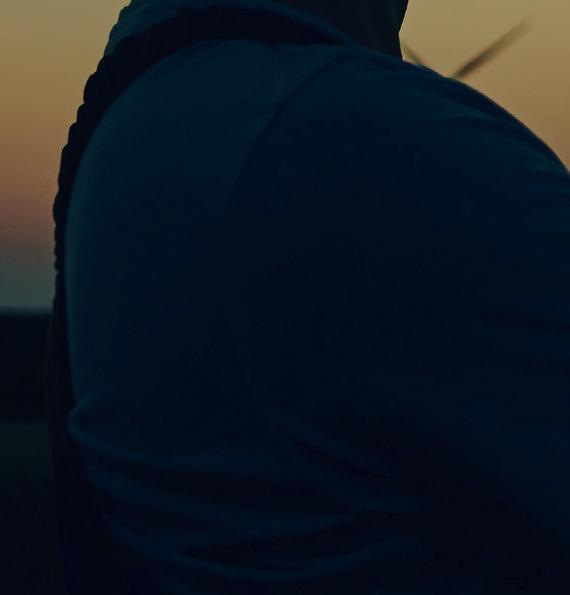





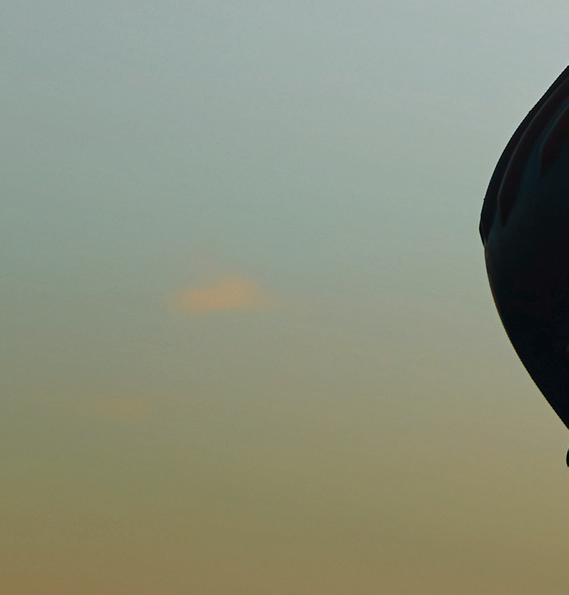








Contents SAFETY, HEALTH AND WELLBEING IN THE WORLD OF WORK CONTENTS MARCH/APRIL 2023 THE KNOWLEDGE 6 THINGS YOU NEED TO KNOW The latest stats and facts, news and views 10 BEHIND THE HEADLINES A look at OSH evidence and terminally ill workers 12 INTERVIEW HSE inspector Ian Whittles on construction and MSDs 14 LEGAL The latest law updates 16 PROSECUTIONS Recent judgments 20 THE WIDER VIEW Online highlights, including webinars and videos 23 IOSH STRATEGY The Institution introduces its public benefits statements 26 OPINION Jane Hartman-Jemmett CFIOSH on the menopause
47 Drones: annoying toys or helpful safety tools? MARCH/APRIL 2023 | IOSHMAGAZINE.COM 4
THE EVIDENCE
70ROUNDUP
Up to speed
An overview of recent research and reports


71DEEP DIVE Research: in depth

A closer look at three new papers and their findings


THE LAST WORD
74 PROOF POSITIVE
Peat bog safety
We explore an innovative new emergency rescue plan
to the edge? The impact of moral injury and distress, and workplace burnout 30
36 SAFETY CULTURE Zeroing in We explore whether zero harm is a help or hindrance 40SKILLS How to build trust Why nuturing relationships with colleagues improves OSH 42 COMMUNICATION Body positive Nonverbal communication and its power to reveal the truth 50 CASE STUDY Knowing your people How renewables firm RES used a stand-down day to boost safety 54 CLIMATE CRISIS First and foremost The pressure extreme weather is putting on first responders
THE BIG STORY Pushed
THE PRACTICE
SUSTAINABILITY Nothing but the truth Are companies ‘OSHwashing’ their safety data? 60 CRISIS MANAGEMENT Ready to respond How to mitigate the risks of complex supply chains 64 CONSTRUCTION Digital dawn Can digitising RAMS bring benefits to the sector? 40 64
THE BUSINESS 58
50 IOSH MAGAZINE 5 COVER IMAGE: SPOOKY POOKA
T H E KNOWLEDGE
THINGS YOU NEED TO KNOW THIS ISSUE
1. GLOBAL RISKS
REPORT REVEALS
2023’S BIGGEST BUSINESS THREATS



Organisations should provide crisis management teams with the right training, investment and support to respond effectively to the major global risks in 2023, health and security services firm International SOS’s Risk outlook 2023 report says.
Amid what it describes as a ‘perma-crisis’, the report makes five risk predictions, noting that productivity could decrease as the cost of living crisis and a challenging security environment impact employees.



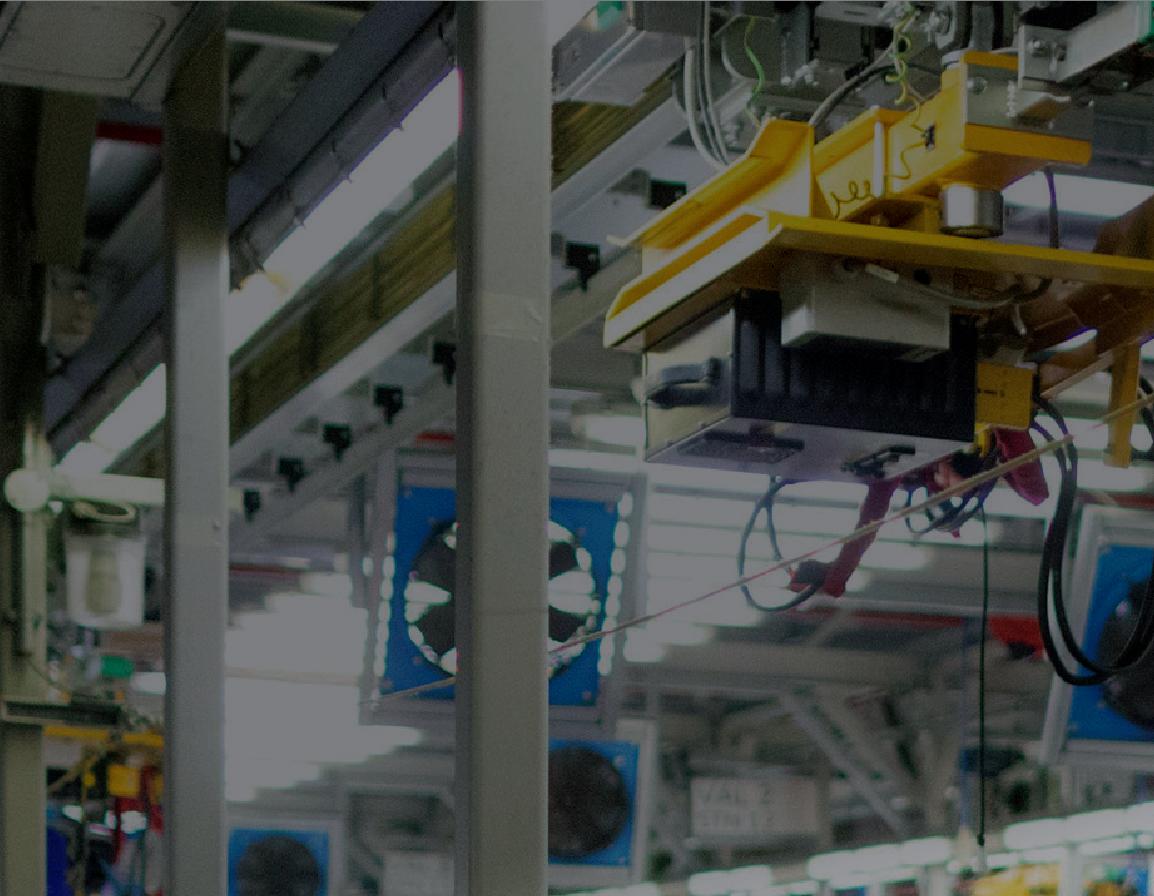
Explore the risks at ioshmagazine.com/risk-outlook




‘There’s a mood of “perma-crisis” as organisations followed from managing impacts of the COVID-19 pandemic to mounting responses to the Russia/ Ukraine conflict’
MARCH/APRIL 2023 | IOSHMAGAZINE.COM 6
SALLY LLEWELLYN, GLOBAL SECURITY DIRECTOR, INFORMATION AND ANALYSIS, INTERNATIONAL SOS
2. IN NUMBERS How the cost of living crisis is hitting jobs
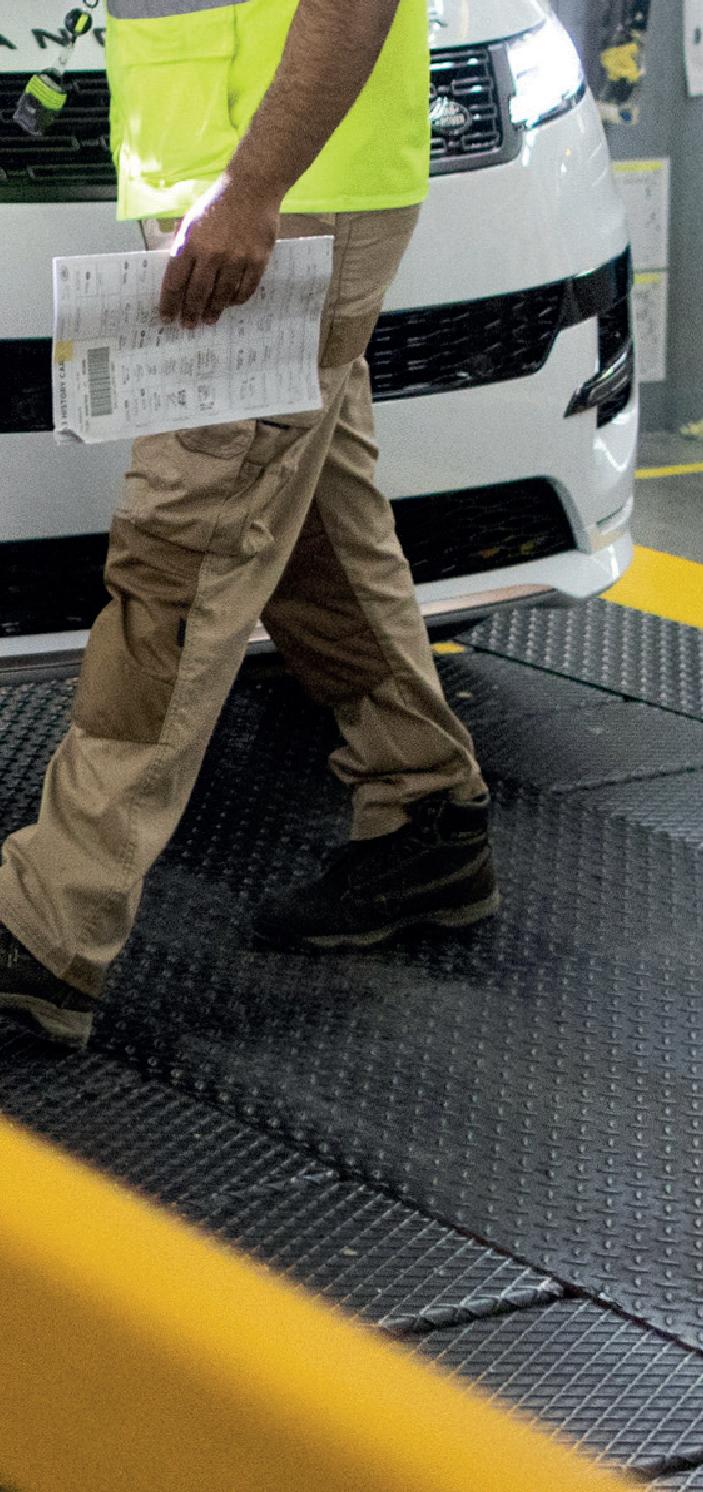
-2.6%
The amount real pay fell in 2022 in the UK after adjusting for inflation – among the largest drop since records began in 2001
17%
Around one in six UK employed adults are working more hours as the cost of living increases


75,000

Job vacancies across the UK fell by this number from October to December 2022, to 1,161,000
4%

Percentage of UK adults who say they are working more than one job because of rising prices
(ONS, 2023)


PHOTOGRAPHY: GETTY
IOSH MAGAZINE 7
Ready
culture
beyond
values people,
IOSH Managing Sustainably


E-learning

Approved training provider 980 Scan the QR code for more information Approved training centre Approved training provider 980 IOSH, IEMA, RoSPA, IATP & CPD approved / assured courses 100% online IOSH & IEMA courses, 100% online, available for an immediate start
courses Environment for Business Managing Safely® Managing Sustainably Safety for Executives & Directors Safety Health & Environment for Construction Site Managers
Health & Environment for Construction Site Workers
Safely®
courses
Sustainability Skills for Managers
Sustainability Skills for the Workforce
IOSH
Safety
Working
IEMA
Environmental
Environmental
environment?
to move
compliance and towards a
that
their communities and the physical
•
3. REDUNDANCY TIPS
FOR GETTING BACK IN THE GAME
The global financial crisis of 200708 brought a wave of redundancies across UK industries, and another period of economic uncertainty has emerged since the beginning of the COVID-19 pandemic.
Dr Fiona Charlton CMIOSH discusses her own experience of redundancy and offers her advice on how best to respond, as well as how stakeholders can better support IOSH members.
Read the story at ioshmagazine. com/redundancy. Check out the latest jobs in OSH at ioshjobs.com
4. IOSH NEWS The Institution goes on the road
IOSH will be attending a number of major UK health and safety events and shows throughout 2023, offering members the chance to hear updates and discuss matters with colleagues.
At the time of going to press, IOSH is confirmed to be attending the following:
• • 14-15 March: Health and Wellbeing at Work Conference and Exhibition (NEC, Birmingham)
• • 25-27 April: The Health and Safety Event (NEC, Birmingham)
• • 16-18 May: The Safety and Health Expo (ExCeL, London)
• 27-28 September: Safety, Health and Wellbeing Live (Farnborough International, Hampshire).
For more information, visit iosh.com/events
5. FIREFIGHTERS
TERMINAL CANCER FEARS AFTER GRENFELL
Up to a dozen firefighters who helped to tackle the 2017 Grenfell Tower blaze in London have since developed terminal cancer, according to media reports. The firefighters, some in their 40s, have been diagnosed with rare, incurable digestive cancers and leukaemia, which are being linked to high levels of exposure to carcinogens during
the rescue effort. Around 1300 firefighters attended Grenfell on 14 June, the day of the tragedy.
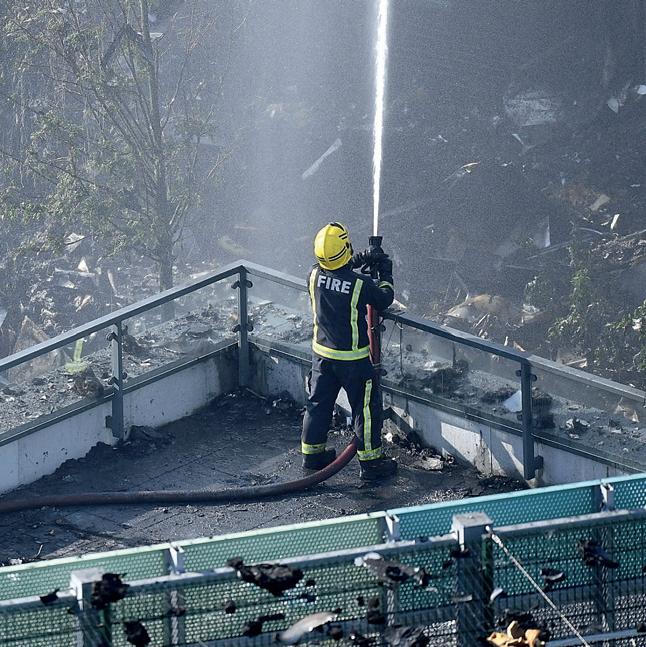
With some cancers taking decades to appear, it is feared these cases could be the early stages of more Grenfell-linked diagnoses in firefighters.
Read the full story at ioshmagazine.com/grenfell-cancer
Congress
IOSH chief executive Vanessa HarwoodWhitcher and head of strategic engagement Alan Stevens will join president Lawrence Webb at the ORP Congress in Bilbao, Spain, next month.
7. WOMEN’S HEALTH
Menopause leave veto
The UK government has vetoed parliamentary recommendations to consult on making menopause a protected characteristic over fears such a move would discriminate against men. It said it was focused on encouraging employers to implement workplace menopause policies.


• Read more on page 26.
Explore the story in more detail at ioshmagazine.com/menopause-veto
Vanessa will be taking part in the opening session as part of an international panel. IOSH will also be supporting other sessions at the event, which will be held from 26 to 28 April.
Keep up to date at fiorp.org/en/ events/orpconference-bilbao-2023
8. POLICE DISCRIMINATION CASE VICTORY FOR TRAINEE PC
A probationer police constable who wore hearing aids has won a disability discrimination case against London’s Metropolitan Police after being dismissed in July 2021. He had been on probation for five years. It was found the force had indirectly discriminated against him by failing to make reasonable adjustments.
Read more at ioshmagazine. com/hearing-Met
THE KNOWLEDGE THINGS YOU NEED TO KNOW THIS ISSUE
6. IOSH NEWS ORP
PHOTOGRAPHY: GETTY ISTOCK
IOSH MAGAZINE 9
Behind the headlines
We delve into the OSH issues making the news.
grapple with the aftermath of the COVID-19 pandemic and its impact on employee health, safety and wellbeing – as well as growing concerns over a potential downturn in the global economy – the report’s recommendations are timely.
The recommendation that researchers should undertake cost/ benefit analyses of evidence-based practice to provide empirical evidence will reassure businesses that OSH investment pays off

There is no single definition of OSH ‘evidence’, a report by RAND Europe concludes. The research – commissioned by the Lloyd’s Register Foundation in partnership with the National Safety Council – explores OSH evidence and how it is used to inform decisions, guidelines and regulations.
The report, published in November 2022, finds that a range of information and research sources, and several actors, shape the ‘lifecycle of evidence’.
After conducting a rapid evidence assessment of OSH literature and completing stakeholder surveys and interviews, researchers developed two conceptual models that led to four influencing factors on how OSH evidence is used to inform decisions being identified: the legal basis and regulations; the business case; the organisation’s culture; and the existence, accessibility and relevance of the evidence. The researchers add that the organisation’s size and location can also impact these areas.
The report makes recommendations aimed at evidence sharers, workplaces and researchers to improve how OSH evidence is applied. As employers
The suggestion that evidence sharers should invest more in ‘knowledge translation’ so data is tailored towards its intended audiences is valid. Translating academic literature into infographics, for example, can have a real impact on the ground. And producing videos for non-OSH audiences reinforces the message that everyone must contribute to the safety culture. This taps into the
report’s recommendation that all workers, including organisational leaders, should be educated about the benefits of promoting a positive safety culture.
What are the challenges?
Businesses can be reluctant to make investments that are perceived to be costly. They want to see strong evidence the actions they are being asked to take will improve OSH before diverting resources.
Equally important is that researchers should collect data on organisation sizes. Micro- to medium-sized businesses, for example, face different OSH challenges to multinationals and more data is needed on this often-overlooked area. Horizon scanning for potential future issues requires greater research attention. If the OSH community can anticipate some of the emerging issues, it increases the speed at which evidence-based practice can be disseminated to help respond to these challenges.
MARCH/APRIL 2023 | IOSHMAGAZINE.COM 10
NO SINGLE DEFINITION OF OSH ‘EVIDENCE’
BEST PRACTICE
To read the original research, visit bit.ly/BTH-OSH-evidence
THE KNOWLEDGE ANALYSIS
PHOTOGRAPHY:
The report suggests evidence sharers should invest in ‘knowledge translation’
ISTOCK
People of working age living with a terminal illness face unique fi nancial stresses compared with older populations, according to new research.
These pressures include childcare costs and loss of family income, according to the collaborative and in-depth research project by the What Works Centre for Wellbeing with leading UK charity Marie Curie.
Characteristics such as gender, ethnicity and healthcare costs also mean that individual experiences vary, and that some employees will be worse o ff than others.
These pressures can exacerbate the individual’s poor mental health and wellbeing as they grapple with their diagnosis, the research adds.
This is not helped by the fact that terminally ill employees face a ‘lottery’ around the level of support they receive from their employer.
Designed to close a research gap that exists on the experience of individuals in this situation, the review highlights how little attention has previously been given to the mental health benefits for affected people who are able to continue their
participation in the workplace.
What are the challenges?
Signi fi cantly, the research reveals that there are no o ffi cial fi gures on the number of workingage people living with a terminal diagnosis.
However, to gain a better understanding of how employers are supporting a ff ected sta ff, the researchers surveyed more than 1000 HR professionals to fi nd out what type of policies and practices are in place.
Just over a third of the HR respondents (35%) disclosed that their company had experience supporting a terminally ill employee, citing the most common type of support as fl exible working, work adjustments and paid time o ff

Almost half (44%) said that their organisation had existing policies in place for terminally ill employees, with most forming part of a wider company policy.
Perhaps not surprisingly, larger companies (60%) were more likely to have policies than their
smaller counterparts (33%) – a re fl ection of their ability to resource sta ff support packages.

The variation between di ff erent business sectors, however, is quite revealing. While 56% of IT and telecoms businesses had policies in place, only 27% of hospitality and leisure operators did.
While the research’s sample size is not large, the fi ndings illustrate that the level of support terminally ill employees receive can be a matter of luck.
In fact, as the research notes, despite ‘pockets of great practice’, ‘too often employees are likely to fi nd
themselves unclear on the support available and unsure how to access it’.
Most illuminating is the revelation that terminally ill employees can also face compounding ‘value judgments, which could, in the absence of published procedures, lead to unjust and avoidable inequality in support’.
This welcome research brings to light an important truth: that companies need to review their policies around terminal illness so that every employee receives the level of support that they need to continue to have active participation at work.
To read the original article, visit bit.ly/ BTH-terminal-illness
IOSH MAGAZINE 11
Support for terminally ill employees varies from business to business and from sector to sector
WELLBEING
SUPPORT FOR TERMINALLY ILL PEOPLE FROM EMPLOYERS IS A ‘LOTTERY’
In the world of construction, musculoskeletal disorders (MSDs) are an age-old problem. But tackling them is gaining fresh focus – particularly amid estimates that they cost construction employers £646m per year (ARMA, 2019). In September last year, the GB Health and Safety Executive (HSE) launched its Work Right Construction campaign, which saw it carry out 1000 inspections in October and November to check how workers were moving heavy or bulky materials.

Ian Whittles (pictured, right), an HSE inspector in the construction division in Bristol, is among those on the campaign trail. ‘This first year [of the campaign] was spent trying to raise awareness around manual handling and MSDs generally so we can start embedding the fact that, no, it isn’t acceptable. This is a proper risk that is going to be with you for life,’ he says.
‘We’ve had a lot of success with the Dust Kills campaign and that has improved enormously. You can definitely see an understanding and an improvement. So with Work Right, we are trying to say that this is a serious problem, so don’t ignore it.’
The HSE estimates that around 40,000 construction workers suffer injuries to their muscles, bones, joints and nerves (HSE, 2022). ‘It is historically very unreported, unfortunately,’ Ian adds. ‘We know people have ongoing issues. Over half of ill health cases in construction are down to MSDs [HSE, 2022]. There are so many people you meet who are complaining about their backs – they’ve been lifting poorly for years.’
Window of opportunity
Early intervention is necessary to reduce and prevent MSDs, says Ian. ‘It needs to be thought about long before it gets to site.’ With a long history of inspecting and advising on window installation, he is used to seeing the impact a lack of planning can have. ‘There’s an awful lot of carrying things around manually when it could be sequenced so much better.
Lifting the load
MARCH/APRIL 2023 | IOSHMAGAZINE.COM 12
WORDS HELEN BIRD
THE KNOWLEDGE INTERVIEW
Ian Whittles, an HSE construction inspector, reveals the cultural challenges in the sector, the drive behind the Work Right campaign and the musculoskeletal benefits it hopes to achieve.
A prime example is where you have heavy pre-glazed units and people think: “I’ll put two or three people on it.” Well, you can’t physically get them around it. But if they’d planned for it, they could either mechanise it or have it dismantled by design and then it’s in sections. But you’re often faced with an immediate reaction of “Well, I’m here now.”’
It leads to safety risks as well as health risks, Ian adds. ‘With glazing you’re not always trying to lift it – you’re usually supporting it – so if it slips, very large units can land on you. So it’s a safety issue. But the current campaign is predominantly about health because of the repetition, when there are simple aids that workers could use.’

FURTHER INFORMATION
Explore the Work Right Construction campaign at workright.campaign.gov.uk/ campaigns/your-health-yourfuture. For the MAC tool, go to hse.gov.uk/pubns/indg383.pdf
A lack of collaboration and foresight at the design stage is one of two key issues in tackling MSDs on construction sites. ‘We need pre-construction planning and dealing with the designers, influencing them where we can and tracking back – challenging large weights of windows, block weights, plasterboard, steel – and making sure they’re thinking about how to install this stuff,’ he says.
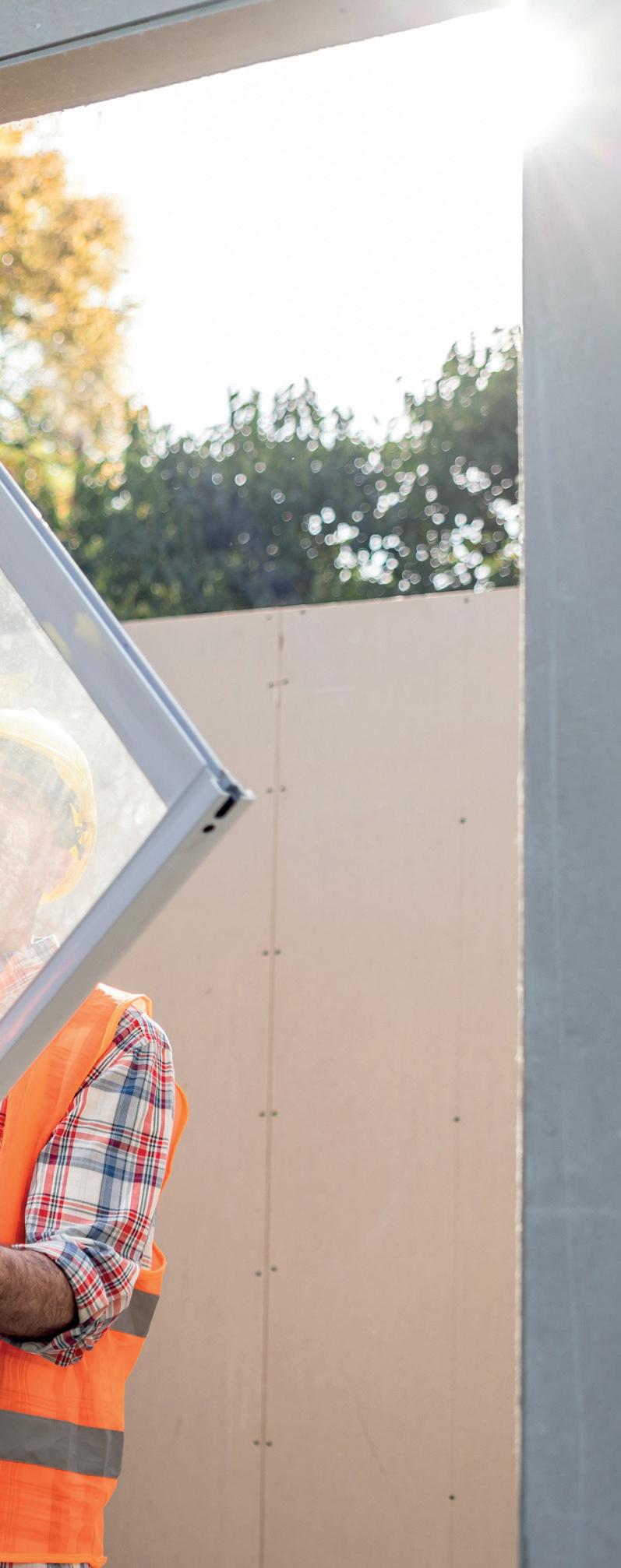
Old school
On-site there are cultural issues at play too. ‘It’s a very male-dominated industry, whereby the workers will often fall back to the “old-school” way of trying to lift things, because that’s the way it’s always been done, when there’s really no need. It’s trying to change that culture and show it isn’t acceptable to try to lug around big bags of cement.’
There are also barriers to assessing MSD risks effectively. ‘You never quite know what you’re walking into,’ Ian says. ‘You’re there at different stages of the project, so sometimes you’re faced with a situation in which poor design means something has been missed, and you’re having to deal with the immediate situation on-site.’
The use of manual handling aids has the potential to make a huge difference, Ian says. ‘We’re getting a lot of positive responses to some of the simple handling
aids that we’re promoting, such as a little inflatable pump-up door lift – it’s genius, it costs almost pennies, and it supports the door so while you’re hanging it you can just fix it in place.’
But who’s responsible for adopting and normalising risk-reducing measures? It’s a two-way street, Ian suggests. ‘The selfemployed subcontractors need to look after themselves, but the site manager needs to be requesting the appropriate RAMS [risk assessments and method statements] systems and reading them, not just filing them, then monitoring to make sure the contractors are following their own systems. There are perfectly good solutions to the obvious risks, and any decent site manager knows that.’

Best practices
Ian advises OSH professionals in the construction industry that the best way to help reduce the occurrence of MSDs is to make use of the MAC [manual handling assessment chart] tool –now an interactive online platform – to look for red flags. ‘You’ve got a red, amber and green system, so it puts it in a simple way for OSH professionals to target the risk areas of the operation,’ he says.

‘MSDs aren’t just about box-lifting. In construction especially, you’ve got weights, posture, ergonomics, carrying distance, restrictions, how you hold it and centre of gravity,’ Ian adds. ‘Look at some of the manual handling RAMS when you see them on-site and challenge them. Because an awful lot say nobody will lift more than 25kg – and that isn’t a sufficient assessment. It needs to be much wider and explore all the factors.’
The Work Right campaign should equip the sector to make positive changes.





For references, see ioshmagazine.com/ HSE-MSDs-construction

IOSH MAGAZINE 13
PHOTOGRAPHY: ISTOCK
Ian has seen the results of a lack of planning while inspecting glazing installations
Negligence claim over mesothelioma death is dismissed
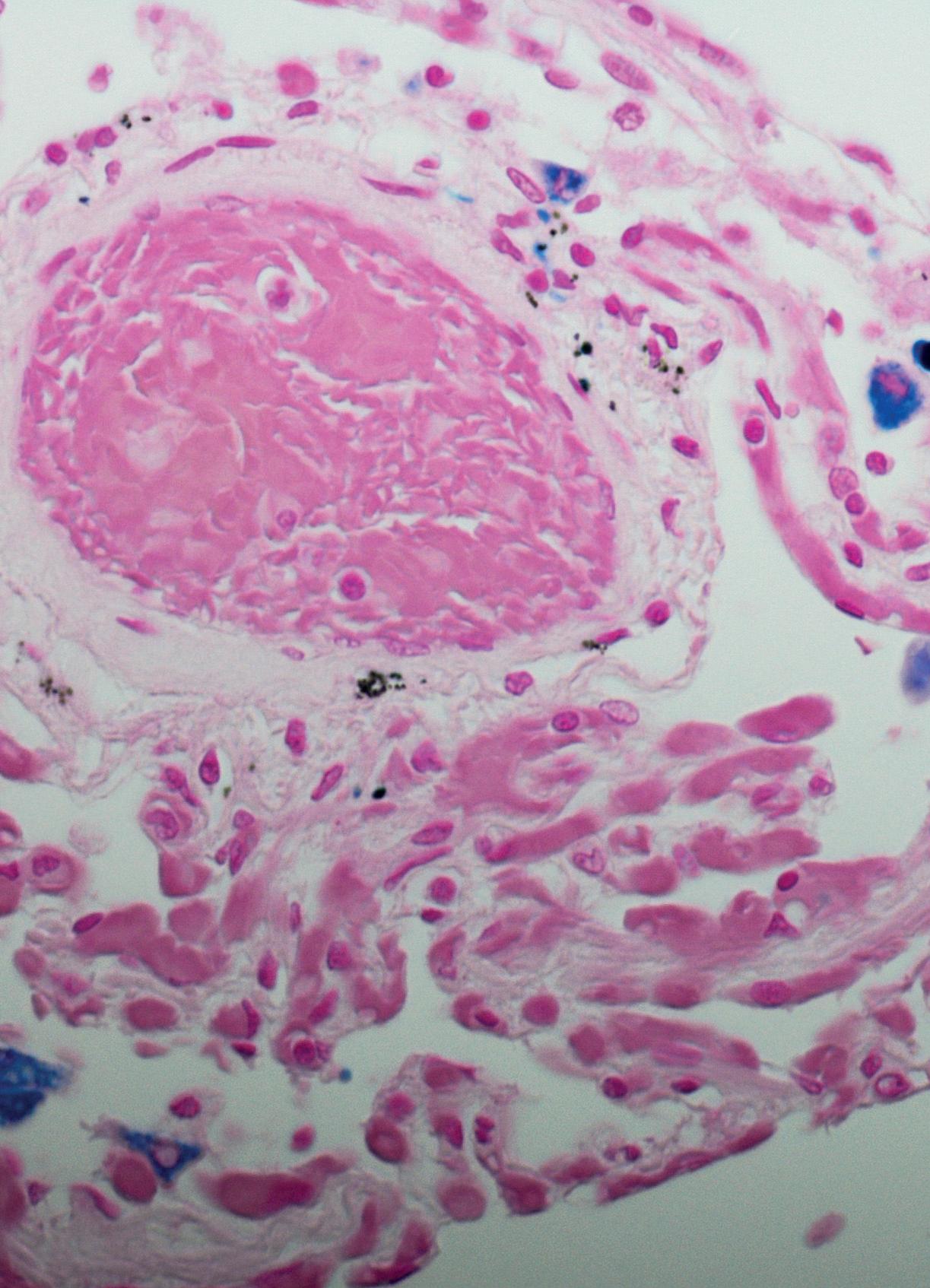
Aconstruction worker’s wife brought a negligence claim against his former employer after his death from mesothelioma in 2022.
Derek Cuthbert worked for Taylor Woodrow Construction Holdings between 1956 and 1959, undertaking work at a school. His widow claimed that during this period he was exposed to asbestos dust and fibres, which led to mesothelioma.
Following his diagnosis, Mr Cuthbert stated that he had worked as a trainee supervisor for the defendant. His job entailed overseeing carpenters cutting asbestos sheets for a few hours every day and sweeping up after them. He said he would get covered in dust and was not provided with PPE.
At the time the negligence claim was brought, Taylor Woodrow Construction Holdings was no longer in business and had no records of work in the 1950s to determine the deceased’s role.
Mrs Cuthbert claimed that the company had breached its duty of care to her late husband. The judge had to decide on two key issues: the extent, degree and frequency of the deceased’s exposure to asbestos dust, and whether this amounted to a breach of duty by the defendant, considering what was then known about health risks posed by asbestos.
When all factors were considered, the judge said they could not accept the
deceased’s statement about the level of asbestos dust he was exposed to while working for the defendant.
Mr Cuthbert was acutely unwell when he made his statements, had failing memory and was trying to recall events from 60 years before. There were questions as to whether at the time of the alleged exposure he had been supervising the carpenters. If he was a supervisor, it was ruled to be unlikely that he spent a few hours a day standing around them. It was also believed to be unlikely that the carpenters would have spent two or three years cutting asbestos sheets for the project.
Sweeping up afterwards was likely to have been one of his tasks, but it would only have occupied a small portion of his day. Building sites were dusty environments and just because his clothing was covered in it every day did not mean it would all have been asbestos dust. The judge ruled that, objectively, it was likely that Mr Cuthbert had only sporadic contact with the asbestos cutters and his exposure while employed
by the defendant was low and intermittent, and as a bystander. This conclusion was consistent with speculative measurements provided by occupational hygienists representing both sides.
The defendant’s knowledge of the risks was considered. The company had to be able to foresee the injury in reference to the standards and knowledge of the time, not with the benefit of hindsight. It was known in the mid-to-late 1950s that asbestos dust was dangerous, but this was only in the context of exposure to significant amounts.
A reasonable employer could not have foreseen that there was a significant risk of injury from exposure at the level to which Mr Cuthbert was subjected. There was then no ‘safe’ level but, even in 1970, the set permissible level far exceeded those to which he was exposed.
The judge ruled that the defendant had not breached its duty of care, and dismissed the claim.
PHOTOGRAPHY: ISTOCK CUTHBERT VTAYLOR WOODROW CONSTRUCTION HOLDINGS [2022] CASE LAW
The judge said they could not accept the deceased’s statement about the level of asbestos dust
THE KNOWLEDGE LEGAL MARCH/APRIL 2023 | IOSHMAGAZINE.COM 14
Defendant found not to have breached duty of care over asbestos exposure in the 1950s.
This sponsored content has been provided by Information Systems, available at cedrec.com
NEW LEGISLATION, GUIDANCE AND CONSULTATION
materials and products used in external walls.
MERCHANT SHIPPING Changes to regulations for high-speed craft
The Merchant Shipping (High Speed Craft) Regulations 2022 revoke and replace the 2004 regulations. The regulations implement the latest version of Chapter X of the International Convention for the Safety of Life at Sea, adopted in 1974. They set out safety requirements for high-speed craft, as well as enforcement measures.
cedr.ec/8pk
FIRE SAFETY
Proposed updates to building rules
A consultation to inform updates to Building Regulations (England)
Approved Document
B – Volume 1: Fire Safety (Dwellings) has been published. Updates include:
• Recommending sprinklers in new care homes, regardless of building height
• Removing the national classification system for products (BS 476 series)
– including class 0 – and requiring relevant products to be tested to British standards
• Introducing a threshold whereby residential buildings above 30 metres should be built with two staircases
• A call for evidence on revisions to areas of Approved Document B covering
cedr.ec/8pm
BUILDINGS Consultation on
safety levy
A consultation on the design and implementation of the Building Safety Levy in England has been completed. Under proposals, developers of residential buildings, regardless of height, will have to pay the levy contribution as part of the building control process. The aim is to remove the burden from leaseholders and taxpayers.
cedr.ec/8pq
PRODUCT SAFETY Deadline for UKCA marking extended
The Product Safety and Metrology (Amendment and Transitional Provisions) Regulations 2022 amend key product legislation to extend the deadline for the full introduction of the UKCA mark until 31 December 2024.
cedr.ec/8pl
REGULATORS
HSA publishes 2023 work programme
Ireland’s Health and Safety Authority (HSA)
has published its Programme of Work for 2023. It seeks to continue its work from 2022 and to drive awareness of the role played by safety representatives, as well as:
• • Enhancing HSA engagement with sectors including health and social care
• Increased focus on occupational health hazards such as those from exposure to chemical and biological agents and from psychosocial and ergonomic risk
• Increasing inspection
• Increasing engagement with clients and building awareness of the role accreditation can play
• Participation in joint EU enforcement activities and contribution to developments in relation to the EU Chemicals Strategy for Sustainability towards a Toxic-Free Environment.
cedr.ec/8pp
DRIVING Changes to hours and tachograph regulations

The Drivers’ Hours, Tachographs, International Road Haulage and Licensing of Operators (Amendment) Regulations 2022 amend retained regulations to fully implement some international road transport provisions in
the Trade and Cooperation Agreement between the EU and UK.
cedr.ec/8pn

HAZARDS
Amends to ammonium nitrate materials rules
The Ammonium Nitrate Materials (High Nitrogen Content) Safety (Amendment) (No 2) Regulations 2022 amend the Ammonium Nitrate Materials (High Nitrogen Content) Safety Regulations
2003 to extend a transitional provision. Ammonium nitrate imports must be accompanied by a detonation resistance certificate issued by a laboratory with an accreditation number. There is usually a 60-day limit on the validity of the test.
cedr.ec/8pr
PPE
New information sheet on hi-vis clothing
The HSA in Ireland has published an information sheet on high-visibility clothing for use around moving vehicles. This information sheet details legal requirements; information on EN ISO 20471; classes of and choosing the correct clothing; maintenance and care; biomotion cues; and driver blind spots.
cedr.ec/8po
IOSH MAGAZINE 15
Baking firm fined £858k after worker’s arm amputated
possibly as early as 2018 when the food mixer was first installed. This meant that all employees working with the machinery had been put at risk. The HSE told IOSH magazine that its investigation discovered that at least 10 factory staff worked with the food mixer. However, closed-circuit TV footage revealed that many employees, including managers and supervisors, had used or seen the machine over the six weeks prior to the incident when the guard was not in place to prevent access. No one had taken any action or raised it as an issue.
The HSE said the guard was designed to allow the machine to operate only when a tote bin was placed beneath it. David Wood Baking Ltd should have ensured that the interlocking system was maintained and remained in working order, the HSE reported. Had this been done, it would have been impossible to use the mixer without the guard in place.
What happened?
The right arm of an employee at David Wood Baking Ltd was surgically removed following an incident at a site in Sheerness in Kent, UK. Lee Simpson, 26, was removing filling ingredients from a paddle mixer in September 2021 when his arm became entangled in the unguarded machinery.

Breaches for prosecution
The GB Health and Safety Executive (HSE) found that control measures to prevent contact with moving parts were
ineffective. Specifically, the guard on the paddle mixer, which is used to make sausage rolls, quiches and other food products, was not routinely replaced after cleaning.
The worker had been removing filling ingredients from the front of the unguarded machinery when his right hand and arm were drawn in. Significantly, the ‘interlocking’ system had been defeated, which meant the mixer could operate without the front guard in place.
The HSE concluded that this system had been defeated since January 2019, but
Sentencing
The firm pleaded guilty to breaching regulation 11(1)(b) under the Provision and Use of Work Equipment Regulations 1998 at Folkestone Magistrates Court in December 2022. In addition to an £858,000 fine, the business must also pay £8000 in costs.
Lessons learned
Find out the lessons that can be taken from this case from HSE inspector Joanne Williams at ioshmagazine.com/DavidWood-amputation

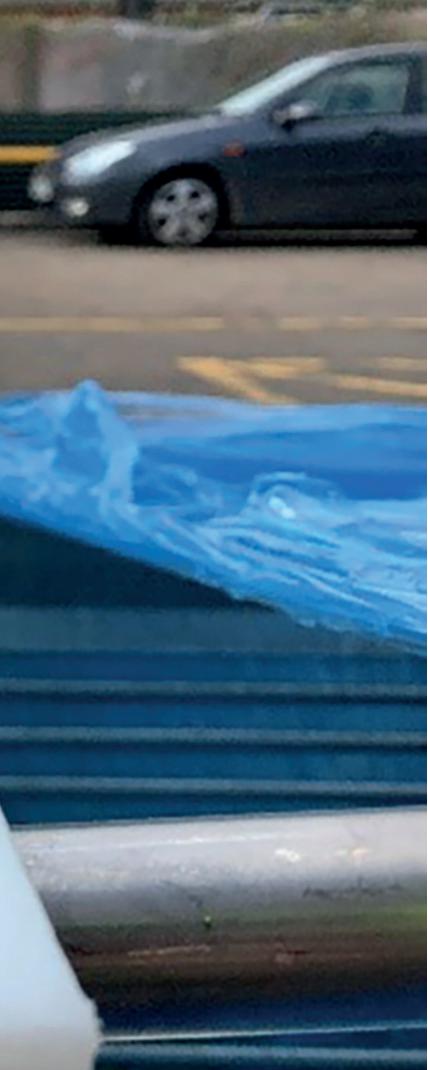
FOOD PRODUCTION
THE KNOWLEDGE PROSECUTIONS
MARCH/APRIL 2023 | IOSHMAGAZINE.COM 16 PHOTOGRAPHY: HSE
One of the paddle mixer’s two interlocks
FARMING
11,000-VOLT SHOCK LEADS TO THREE PROSECUTIONS
The incident
Concrete contractor Connop and Son, a farm owner and a pump driver were all sentenced at Oxford Magistrates Court after a worker was left in a coma for six days. In September 2019, the employee received an 11,000-volt shock when the arm of a mobile concrete pump came into contact with an overhead power line at Worton Grounds Farm near Banbury in Oxfordshire, UK.
The case Inspectors from the GB Health and Safety Executive (HSE) took the rare decision to prosecute three parties: farm owner Alexander Maddan, contractor Connop and Son, and vehicle driver Shaun Walker.
The investigation found that the farm owner had not appointed a principal contractor. Therefore, as the farm owner and the client, he had taken on the role under the Construction (Design and Management) Regulations 2015.
When Connop and Son was appointed as contractor, documentation highlighted the power lines, where they were and the precautions needed. Therefore, the firm could not argue that it did not know about the power lines.
And although there is no legally required training for operating a concrete pump, operators should
attend a training course. The pump driver had taken this course and was experienced, showing that he knew looking out for overhead power lines was a top priority.
During the investigation, the pump driver and Connop and Son said different things about the placement of the pump and its boom in the lead-up to the accident.
In court
In October 2022, Connop and Son Ltd pleaded guilty to breaching regulation 14 of the Electricity at Work Regulations 1989. The company was fined £50,000 and ordered to pay costs of £5425, plus a victim surcharge of £181.
Alexander Maddan pleaded guilty to breaching regulation 13(1) of the Construction (Design and Management) Regulations 2015. He was fined £3000 and ordered to pay costs of £525, plus a victim surcharge of £181.
Shaun Walker pleaded guilty to breaching section 7 of the Health and Safety at Work Act. He was handed a 12-month community order and ordered to pay costs of £2000, plus a victim surcharge of £90.
More information
Find out more from principal inspector Steve Hull about why the HSE decided to instigate three prosecutions and the lessons learned at ioshmagazine.com/ Connop-electrocution
IN BRIEF SCHOOLS Tree collapse kills girl, 6
An English council has accepted responsibility for failing to manage the risk of a decayed willow tree that collapsed and struck several children at Gosforth Park First School in Newcastle, killing a six-year-old girl.

Newcastle City Council pleaded guilty to breaching section 3(1) of the Health and Safety at Work Act. It was fined £280,000 and ordered to pay costs of £8020 by South Tyneside Magistrates Court in January 2023.
Read more of the GB Health and Safety Executive inspector’s remarks at ioshmagazine.com/Newcastle-tree
AEROSPACE Worker left in coma after fall
An aircraft maintenance company has been fined £230,000 after a worker fell from height in Cardiff. The injuries to Iain Mawson, a British Airways Maintenance Cardiff Ltd employee, were so severe that he was put in an induced coma for three weeks.
Cardiff Magistrates Court heard how the father of two fell while inspecting wings through a gap in the guardrail of the docking platform where safety barriers had been removed.
A GB Health and Safety Executive investigation found the firm had failed to adequately analyse the risks.
British Airways Maintenance Cardiff Ltd pleaded guilty to breaching section 2(1) of the Health and Safety at Work Act. It was fined £230,000 and ordered to pay costs of £21,623.
IOSH MAGAZINE 17
CONSTRUCTION
HSE discovers workers sleeping on building site

The incident
A proactive inspection by the GB Health and Safety Executive (HSE) that investigated health and safety failings at a construction site at Regent House in Brentwood in Essex, UK, found people sleeping on-site. The inspection was undertaken after a concern was raised.
The findings
With assistance from Essex Fire and Rescue Service, the investigation identified failings in fire management at the site, which created risks for workers and the public
visiting show flats outside business hours.
The HSE found the environment at Regent House was poorly managed by S&S Quality Building Contractors Ltd, and construction was being carried out in an unsafe manner that risked a fire starting. Evidence gathered during the investigation indicated that company director Shlomo Pines regularly attended the site but failed to implement improvements from previous HSE interventions.
Other risks
S&S had previously been subject to interventions by the regulator after fire risks had been identified across a number of sites over several years.
MANUFACTURING £800K FINE AFTER EXPLOSION IN PAINT FACTORY
THE CASE
A paint manufacturer owned by chemicals giant Akzonobel has been fined £800,000 after a worker suffered life-changing injuries in an explosion.

The employee of International Paint Ltd spent eight days in intensive care on life support and was left with all-over body scarring, partial blindness to one eye, hearing damage and damage to a knee and shoulder.
In August 2020, the
The prosecution
S&S was fined £600,000 and ordered to pay costs of £36,894 after pleading guilty at Basildon Crown Court to breaching section 3(1) of the Health and Safety at Work Act. In addition, Shlomo Pines received a community order to complete 100 hours of unpaid work and was fined £4200 after pleading guilty to contravening section 37 of the Health and Safety at Work Act.
More information
IOSH magazine has been provided with a copy of the sentencing remarks at Basildon Crown Court, courtesy of the HSE. See our summary of the steps that the court had to take in determining sentencing at ioshmagazine.com/S&S-Quality-failings
THE KNOWLEDGE PROSECUTIONS
PHOTOGRAPHY: GETTY / ISTOCK
MARCH/APRIL 2023 | IOSHMAGAZINE.COM 18
employee, 49, was making paint in a large mixing vessel at the firm’s plant in Gateshead in Tyne and Wear, UK. As he was emptying resin pellets from a large bulk bag into the vessel, an electrostatic spark was generated, igniting flammable vapour within the vessel and causing a large explosion.
Akzonobel said it has been supporting the injured worker through its on-site occupational health provision and he has now returned to work.
THE INVESTIGATION
HSE investigators identified that the company had failed
to put sufficient measures in place to control the risk. This included a failure to use a correctly working extraction system to remove the flammable vapours and a lack of effective electrical earthing of the bulk bag to prevent the build-up of electrostatic charge.
THE PROSECUTION
International Paint Ltd pleaded guilty to breaching section 2(1) of the Health and Safety at Work Act at Newcastle upon Tyne Magistrates Court. As well as an £800,000 fine, it was ordered to pay prosecution costs of £14,032.
More at ioshmagazine.com/ Akzonobel-explosion
POWER FIRM ADMITS FAILING TO PROVIDE SAFE ENVIRONMENT
Power company Energy Australia pleaded guilty to three charges relating to failure to provide a safe working environment after a worker died.
Graeme Edwards was severely burned when an electrical short circuit caused an explosion at the Yallourn Power Station, in November 2018. He died the next day.
In December 2022, WorkSafe, Victoria’s workplace safety watchdog, charged the company following a two-year investigation, alleging that it had failed to provide a safe workplace, or proper instructions and training, and failed to provide and maintain safe work procedures such as offering adequate PPE. Energy Australia was fined A$1.5m (£860,000).
PLASTICS FIRM MUST PAY £242K AFTER WORKER’S DEATH
A US plastics company pleaded guilty to a wilful violation of an Occupational Safety and Health Administration (OSHA) standard that resulted in a death. A worker was pulled into moving rollers in August 2017 at a plant in Helena, Alabama, owned by ABC Polymer Industries.
Court documents state ABC Polymer operated extrusion lines, which moulded raw materials into flat rectangular sheets. The machine was equipped with a barrier guard that could have been pulled over an exposed side but was not, contrary to standards. The firm must pay $242,000 (£197,000) to the victim’s estate, $167,928 (£136,370) in penalties and serve two years of probation.

AROUND THE GLOBE
IOSH MAGAZINE 19
The wider

Video

MAINTAINING SAFETY STANDARDS FOR THE GIG ECONOMY






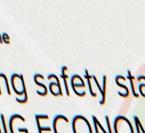

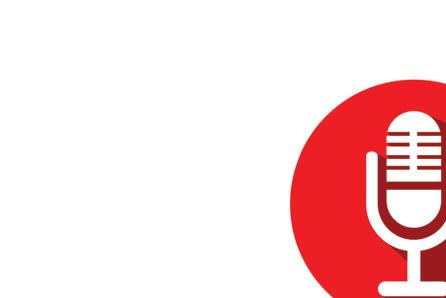
8,000+
downloads





























7.25 million






73 million gig workers in the UK globally

How can OSH practitioners protect non-standard workers? Find out by watching our video at ioshmagazine.com/videos



















A BOLD APPROACH TO PRESIDENCY
Newly elected IOSH president Lawrence Webb joins the podcast to discuss the emboldened approach for his term.
CELEBRATING A YEAR OF SUCCESS
Louise Hosking, immediate past president of IOSH, reflects on her year at the helm.


HOW LEADERS CAN OVERCOME IMPOSTOR SYNDROME

We spoke to two Future Leaders about taking on big responsibilities and learning how to adapt.
Listen to all our podcasts at ioshmagazine.com/podcast









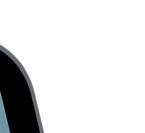


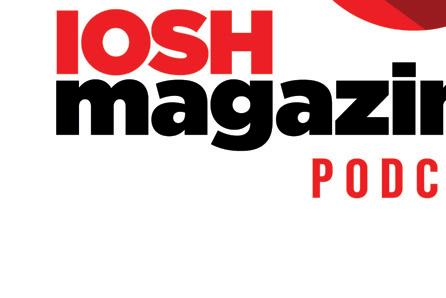


MARCH/APRIL 2023 | IOSHMAGAZINE.COM 20 THE
KNOWLEDGE ON THE WEB
view
Opinion
STICK OR TWIST?
Younger employees expect their employer to respect and even share their values, particularly on mental and physical wellbeing. What can organisations do to retain staff and get the best out of them?

DETRIMENTAL TO HEALTH
Webinars



4 MISSING INGREDIENTS IN SAFETY CULTURE
Like a thousand-piece puzzle, safety culture takes time and focus to put together. Join the conversation as our expert panel explores what is required to slot those pieces into place and see the picture take shape at ioshmagazine.com/webinars/ideagen/culture

5 WAYS TO TRANSFORM WORKER SAFETY WITH ARTIFICIAL INTELLIGENCE
Why watch?
To find out how organisations apply artificial intelligence to predict and prevent accidents and near misses, improving worker safety, productivity and satisfaction.
What will I
learn?
You’ll discover how to deploy technology in days, not months, to provide real-time actionable insights and reduce costs.
Where to view
3200 registrations

































ioshmagazine.com/webinars/sparkcognition-AI


Employees are often under pressure go to ‘over and above’ their normal working hours, but could businesses be doing themselves harm by expecting staff to work long hours? Is it time for a rethink?
Read the debate at ioshmagazine.com/opinion/burnout
Don’t miss out
Sign up to receive our awardwinning twice-weekly eNewsletter at ioshmagazine.com/enewsletter


Issue archive

You can access all the previous editions of IOSH magazine at ioshmagazine.com/issues



IOSH MAGAZINE 21
A R W To ar pr im an W Yo in ac W io

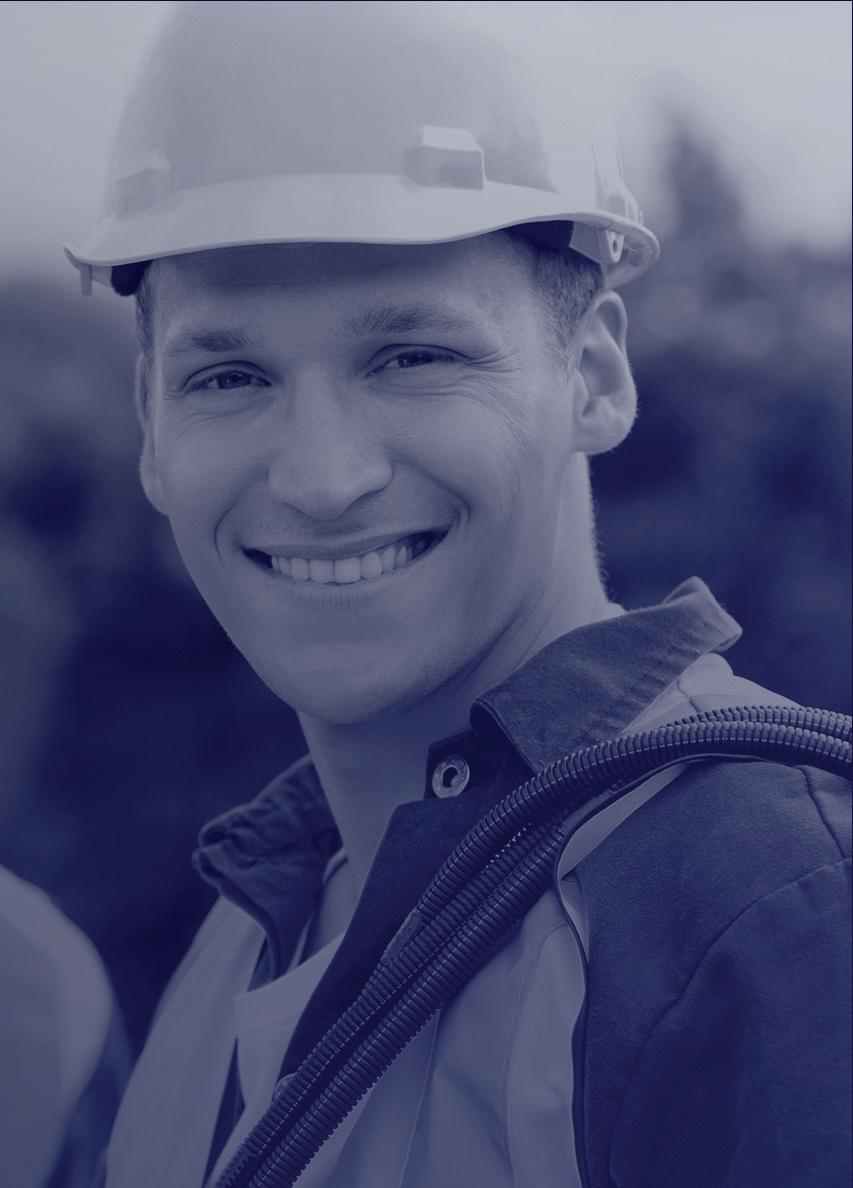



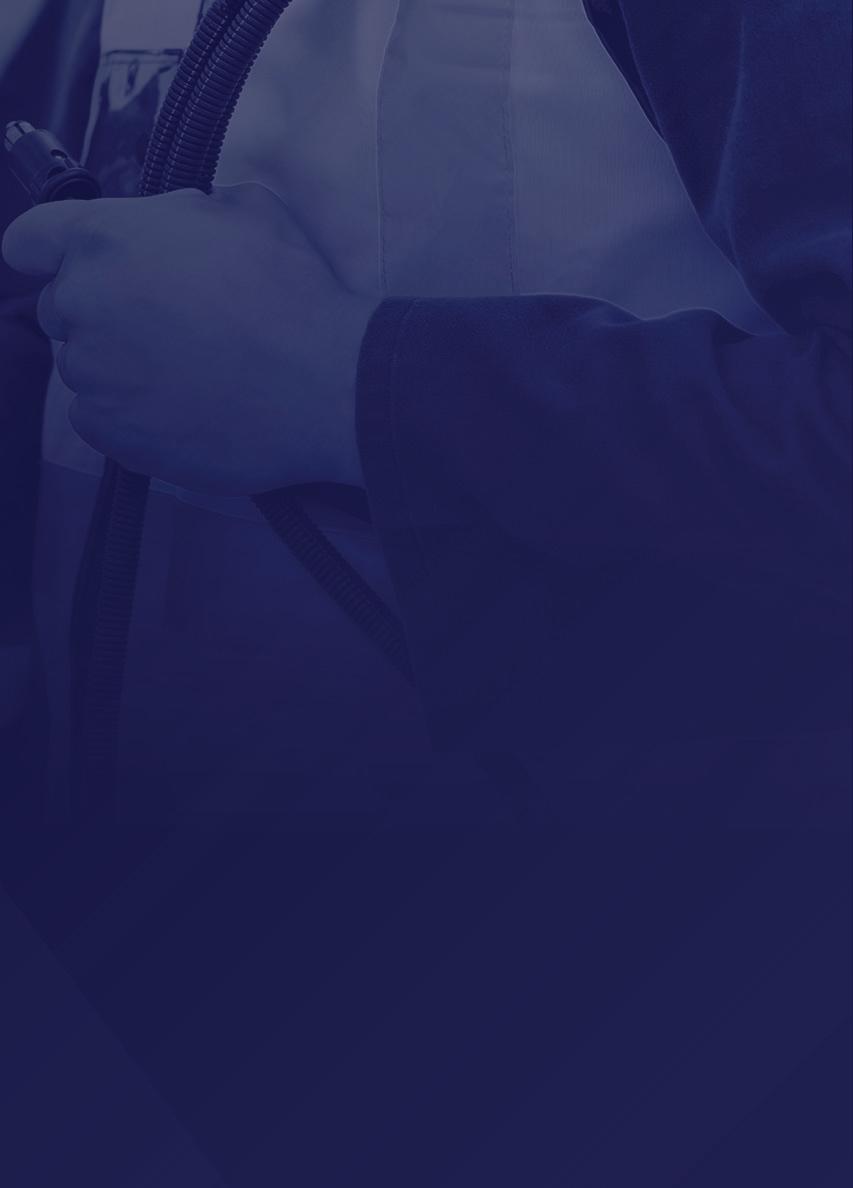





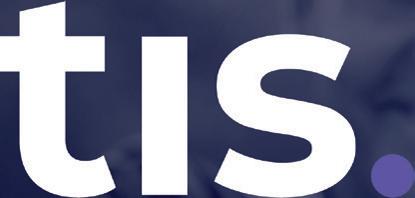













Over 4,000 organisations have trusted us with their health and safety and environmental staff development plans, and on average, 170 new learners enroll with us each week. www.astutis.com Phone: +44 (0)345 241 3685 Email: enquiries@astutis.com Choose your preferred learning method: IEMA Pathways to Net Zero Scan to browse IEMA courses at: www.astutis.com/iema-courses OnlineVirtualClassroom
•
Staying true to the IOSH vision and mission
‘At the core of IOSH’s vision, mission and ambition is the commitment to protect workers’ lives and protect people from harm at work every day. What could be more important?’ says Dr Peter Bonfield, chair of the IOSH Board of Trustees. ‘Our new strategy has the broadest possible relevance and potential for application across the Institution’s activities and its membership but also beyond, through our partners and supply chains the world over.’
Our mission statement continues to pursue our vision of a safe and healthy world of work:
•
• We build excellence in a profession dedicated to the protection of all workers, everywhere.




• We drive action from everyone that can influence and prioritise OSH standards, globally.


•
• We put people at the heart of social sustainability.

‘We’re launching this new strategy at a vital time for the OSH profession and the world of work. We’re working hard to make real the agreement last year by

IOSH launches its new five-year strategy this spring. It will build and act on the reshaped purpose and ambition gained during WORK 2022, which ran from 2017 to 2022.




the International Labour Organization to establish a safe and healthy working environment as a fundamental principle and right at work,’ says IOSH president Lawrence Webb. ‘I’m convinced this strategy will serve members and OSH professionals well in the years to come.’
New elements explain how we’re committed to doing this and what we aspire to achieve for our members and the OSH profession.
‘We’re at the start of a new chapter for IOSH, but one that builds seamlessly upon what we’ve achieved during the life of our previous strategy,’ says IOSH chief executive Vanessa HarwoodWhitcher. ‘Our next strategy, Activate 2028, is already inspiring a renewed sense of purpose, reprioritising our work and informing business planning. I’m looking forward to sharing what this means for IOSH and for the profession.’
You will see more from our next strategy and its objectives at the official launch in April. It will inform everything we do and how we do it.
Right now, we can share two underpinning elements from the next IOSH strategy. One explains how we will deliver public benefit through our stated charitable objects, the other offers values that characterise the occupational safety and health profession worldwide.

Public benefit statements
IOSH’s charitable objects guide our core purpose. We’ll remain dedicated to each one throughout the next five-year strategy. As we launch IOSH’s new strategy, we wanted to create public benefit statements to clearly outline what we aim to achieve, showcasing how, along with the power of its members, IOSH can improve everyone’s working lives.

PHOTOGRAPHY: SAMSUNG UK ON UNSPLASH / ISTOCK
THE KNOWLEDGE IOSH STRATEGY
IOSH MAGAZINE 23
Charitable object 1
To promote systematic and organised methods of improving occupational safety and health and to advocate, advise on, disseminate, explain and advance the principles, methods and systems of their application in work generally.
Charitable object 2
To facilitate the exchange of information and ideas among the members of the Institution and of other professional bodies in the field of occupational safety and health and to work together with other professional bodies in pursuit of mutual objectives.
Charitable object 3



To do all such other things as may be necessary or desirable for maintaining and improving the professional status of members of the Institution and of people engaged in professions requiring a knowledge of the matters mentioned in the first charitable object.
We report on these public benefits in our annual reports. Outlining responses to the charitable objects as actionable statements will enable the Board to hold IOSH, the charity, to account for delivery of its public benefit requirements.



Values for the OSH profession












Our values are the collective guiding principles for uniting our profession. They give us a foundation from which to act and evolve the world of work for the better.
Act with integrity
We stay true to our beliefs, our dedication to workers’ safety and our commitment to
Public benefit statement

We champion the right to a safe and healthy world of work. We shine a light on best practice through partnerships with NGOs, campaigns, educational resources and case studies, all freely available to guide businesses, governments and investors on how to apply OSH at organisational or policy level. Workers’ lives are protected, their families supported and communities strengthened.
BUILDING A STRATEGY
How we make a difference together
We create inclusive physical and virtual communities, connecting members and partners so knowledge, tools and techniques are shared and a culture of support and positive peer-to-peer interaction is nurtured. To keep communities thriving, we invest in research and outreach to further professional standards and knowledge. This has influence beyond our membership, and so can have positive impacts on workforces across the world.
At the core of everything we do are our charitable objects. They define what we want to achieve for the public good. One of the key roles of Council in developing this strategy was to check and validate that it was demonstrating delivery of our charitable objects.
IOSH worked collaboratively to develop its new strategy. Throughout, Council engaged with and listened to feedback from members everywhere, bringing these insights into the strategydevelopment process.
We set world-class professional standards for the OSH profession through our competency framework. We provide and accredit training and education programmes that support professionals to continuously develop themselves and be recognised and trusted for their expertise through IOSH membership.


continuously champion workers’ safety and health.
Always be inclusive
We champion a world of work where everyone can be their authentic self, and we are utterly committed to protecting the right for everyone to feel safe and empowered in the world of work.
Together we innovate
We empower organisations to face an ever-changing and pressurised world through collaboration and communication. We’re committed to developing dynamic and innovative solutions.
With our vision and mission, charitable objects, our global partnerships and, most of all, our members across sectors and territories, through our new strategy we’re in a strong position to fulfil our objectives worldwide.
We hope these public benefit statements and values for the profession inspire you to support how the Institution, and your membership of IOSH, can make a collective difference to realising a safe and healthy world of work.
Public benefit statement
clusive world of
he
of
nnovate ganisations g ollaboration and namic and ns. PHOTOGRAPHY: GETTY THE KNOWLEDGE IOSH STRATEGY MARCH/APRIL 2023 | IOSHMAGAZINE.COM 24
Public benefit statement
work where their authentic self, and mmitted yone
world
work














































































Our health, safety and wellbeing services help organisations seize new opportunities to thrive. Find out more: T. +44 (0)20 3510 3510 www.britsafe.org Registered Charity No. 1097271 and OSHCR No. SC037998. MC231
THE FORGOTTEN RISK
Jane Hartman-Jemmett CFIOSH argues that there’s a blind spot around menopause in the workplace.
Much has been said in the media of late about menopause, finally allowing what some women feel is the last taboo to be openly discussed.
Women make up more than half of the UK population, yet continue to live and work in a world designed for men. The exposing of gender bias (as described so well by Caroline Criado Perez in her book Invisible Women) needs to extend into menopause.
Since the Management of Health and Safety at Work Regulations were introduced in 1999, employers have been required to assess risk. One group, new and expectant mothers, even has its own regulations. Why doesn’t menopause have the same?
Women aged 45 to 54 make up 11% of all people in employment and 23% of all women in employment in the UK (TUC, 2021).
Add to this those women in perimenopause, which can start as early as the 30s, and we have a significant proportion of the UK workforce who cannot – and should not – be ignored.
Symptoms of menopause and perimenopause include everything from low mood,
brain fog and anxiety to hot flushes, muscle aches, changes in body shape and weight gain.


What would you do?
Consider this: you are a line manager in a domestic electrical installation company and one of your electricians starts to demonstrate mood swings and forgetfulness. Their PPE no longer fits, plus they have repeated absences with vague reasons. Ask yourself what you would think. You may wonder if an addiction has got out of hand. What would you do? Tackling the issue would hopefully start with an exploratory chat, but if the employee can’t explain the symptoms, it could lead to –in the worst-case scenario –a verbal warning.

Nearly a million UK women have left the workforce due to menopausal symptoms and the lack of support to help manage them (TUC, 2021).
The UK government recently rejected MPs’ call to introduce menopause leave over fears it could discriminate against men with long-term health conditions. The TUC is calling on the UK government to adopt a strategic role in raising awareness of menopause in workplaces and make flexible working a legal right. I would argue this doesn’t go far enough.

Raising awareness needs to extend to a requirement for the GB Health and Safety Executive (HSE) guidance on risk assessment to apply to
perimenopausal and menopausal workers in the same way that it does to pregnant workers and new mothers (HSE, 2022).
So, with our new knowledge about menopause, let’s revisit our electrician. The company

THE KNOWLEDGE OPINION
MARCH/APRIL 2023 | IOSHMAGAZINE.COM 26 g r ar a g
What GB HSE says about OSH and menopause...
Health and safety law protects all workers from the risks arising from the work activity or workplace. There are no specific legal requirements under health and safety law for those experiencing menopausal symptoms; however, we would expect employers to engage with workers and review risk assessments when there is a change, such as the impact of menopause symptoms, that could mean the current risk assessment is no longer valid.
The HSE launched new, strengthened guidance in November 2022 that gives a set of clear and simple principles that employers would be expected to apply to support disabled people and those with long-term health conditions in the work environment. The principles and guidance could also apply to other
health conditions or where workers are experiencing symptoms, such as those that occur during menopause. The new guidance contains talking toolkits that can help employers to start simple and practical conversations with workers. Starting a conversation is an important first step towards supporting a worker. The new guidance can be found on the HSE’s website: bit.ly/HSE-principles
Further information
• Acas guidance on managing the effects of menopause: menopause at work: bit.ly/ ACAS-menopause
• HSE overview of managing risks and risk assessment at work: bit.ly/HSE-risks
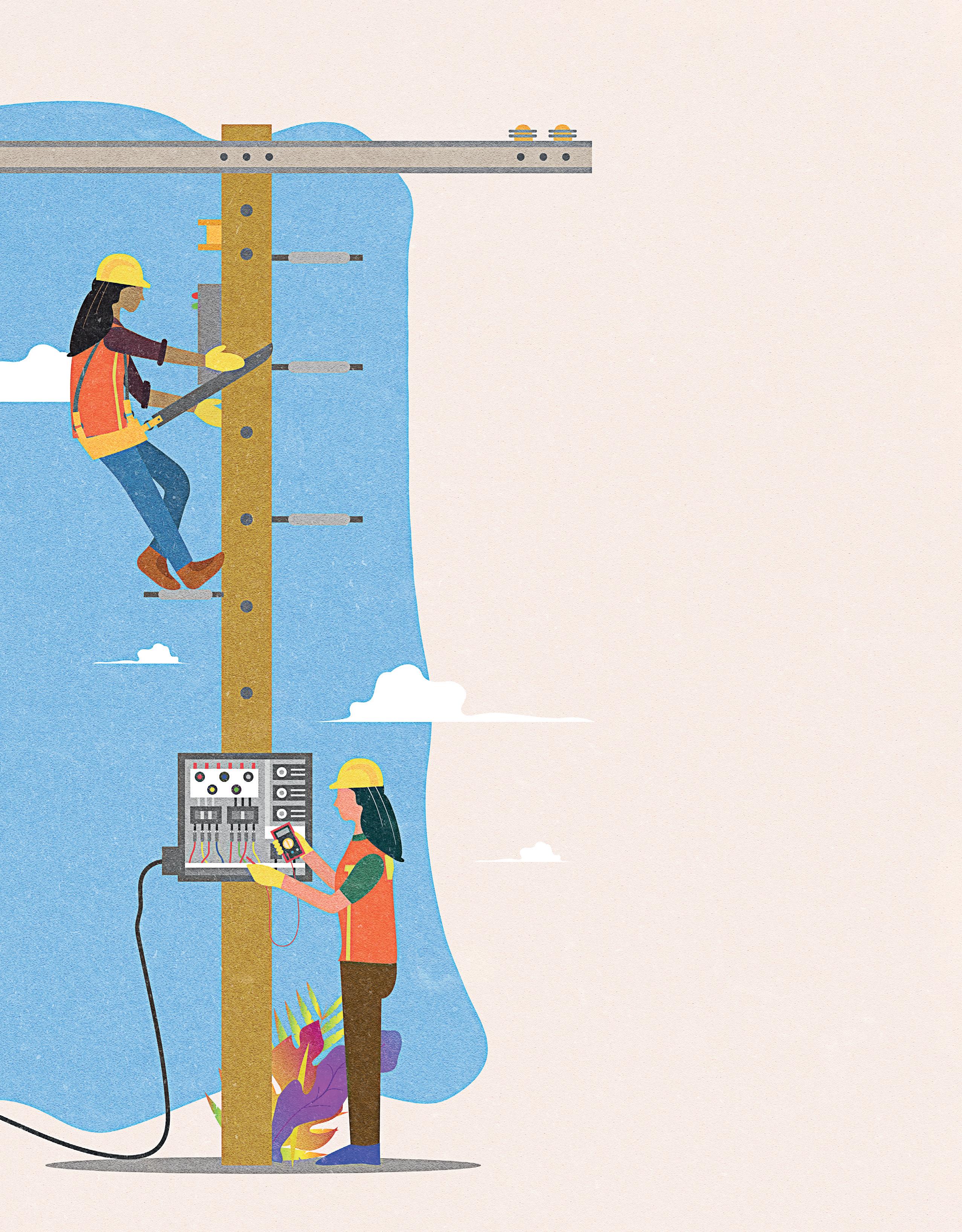
• New talking toolkits on supporting disabled workers and workers with long-term health conditions: bit.ly/HSE-talking
has a menopause policy, formal management training and a process on the issue, including health and safety campaigns. How do you think the conversation would go?
The employee and manager could identify symptoms and have a constructive discussion about how they are affecting performance. Tasks, flexible working or redeployment (until the brain fog has passed) can then be reassessed considering the risks and
additional controls put in place. Policies, processes and formal guidance from HSE to help managers assess the risk of the employees’ symptoms would mean that not only are more women likely to remain in the workplace, but they would do so safely.
• Read Jane's response to the UK government's rejection of menopause leave at ioshmagazine. com/opinion-menopause-leave
See references at ioshmagazine. com/OSH-menopause
ILLUSTRATION: SHUTTERSTOCK
IOSH MAGAZINE 27
It’s all about you







It can feel like a big responsibility making sure everyone gets home safely at the end of the day. But, when we’re standing side by side with 49,000 members, across 180 countries, we can progress our profession further together.







Your membership benefits
As an IOSH member, you receive the support of your global network as well as:

post-nominals that highlight your professional commitment, competence and credibility access to CPD resources, webinars and the technical advice helpline


support for your professional journey by creating your personalised professional development plan
our award-winning IOSH magazine with the latest news and updates delivered to your door tools and resources to help you get ahead with access to the Career Hub
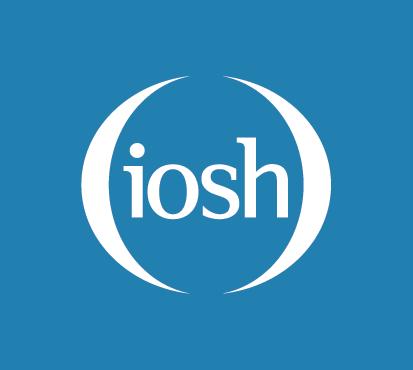
a Future Leaders Community dedicated to new and aspiring professionals
Make the most of your member benefits and together we can make work life better, for everyone.
THE





TO EDGE?
THE BIG STORY BURNOUT MARCH/APRIL 2023 | IOSHMAGAZINE.COM 30
PUSHED IMAGE: SPOOKY POOKA
The concept of burnout was not new to OSH professionals and employees when the World Health Organization (WHO) defined it as an occupational phenomenon in the 11th Revision of the International Classification of Diseases (WHO, 2019), but the concepts of moral injury and moral distress may be much less familiar.
Research on these ideas has typically only been undertaken into the experiences of people working in the military and healthcare – those who are required to make decisions with life-or-death implications. But now the impact of moral injury and moral distress is beginning to be explored in the wider workforce.
The term ‘moral injury’ was coined by psychiatrist Jonathan Shay in 1994 following his work with traumatised Vietnam War veterans. Defined as ‘a strong cognitive and emotional response that can occur following events that violate a person’s moral or ethical code’ (Williamson et al, 2021), moral distress is seen as the precursor to moral injury – which is when it is experienced repeatedly and with longlasting effects (Lewis et al, 2022).
‘Moral injury happens when somebody has witnessed or failed to prevent an action or situation at work that goes against their own values or beliefs,’ says Cara de Lange, CEO of mental health and wellbeing consultancy Softer Success. ‘This hasn’t really been looked at in a business setting. We came across more and more clients in situations like this and



PSYCHOLOGICAL SAFETY
The role of OSH professionals





In terms of ‘moral-injury-induced burnout’, this feels like it aligns more with safety culture and climate, and is no different to psychological safety. As with any potential health and safety risk, understanding the causes and potential mitigation is important. However, this isn’t any different in terms of management – it’s about stress risk management, enabling effective communication and engagement with staff, and promoting psychological safety. Jennie Armstrong, head of OSH and wellbeing at construction firm Tideway

You need to address the organisational nature of the problem if you want to help the individual. OSH professionals need:
• Self-awareness, as they may often be the victim
• Knowledge of the causes of moral injury and burnout and interventions/treatment
• Access to psychological support for at-risk workers


• Good communication skills so they are able to have conversations with both management and workers to address the underlying cause
• The ability to work with others to identify and manage the problems
• The ability to be fair and compassionate. Dr Karen Michell, IOSH research programme lead, occupational health


Burnout, moral injury and moral distress are bubbling up in the workplace. But how are these concepts connected?
IOSH MAGAZINE 31
WORDS ANNA SCOTT
decided that we needed to do some research into it. There seems to be more traumainfused burnout that is linked to moral injury as an effect of things that have been happening over the last couple of years.’
Dr Rachel Lewis, co-author of the report and reader and programme director at Birkbeck, University of London, says it’s clear that moral injury at work is a global issue and is not restricted to war zones or hospital wards. ‘Given that it is linked to a range of outcomes, including turnover and burnout, it is something organisations need to understand and take action to avoid.’
Definitions in health and safety
Dr Karen Michell, IOSH research programme lead, occupational health, has seen examples in OSH settings when contractors and subcontractors are paid bonuses if they have injury-free projects.
‘So, in some cases where an injury then happens, the employer fails to disclose it to the client in an effort to secure the bonus,’ she says. ‘The worker is then left in an unfavourable situation and the OSH practitioner feels helpless to do anything.’
Moral distress was traditionally explained as the ‘injurious impact on a healthcare worker who saw a person die because they did not have the resources to assist them’, Karen says. ‘We now understand that where an employee witnesses or prevents an action that goes against their morals – such as nepotism or corruption – over which they have no control or ability to intervene, they are experiencing moral distress.’ This could mean discriminatory behaviour, a failure to respond to complaints or whistleblowing, or a failure to comply with legislation.
Lewis et al (2022) found that moral stress and injury in business settings led
TOP TIPS
How OSH practitioners can help to drive change
• Make whistleblowing services and fraud hotlines for anonymous reporting available
• Check in with staff to find out how they are feeling
• Ensure that policies apply to all, protect the vulnerable and are enforced
• Ensure rules and procedures are clear, concise and enforced fairly
• Ensure there is clear communication that includes allowing staff to raise concerns knowing these reports will be taken seriously
• Discuss the topic openly so workers understand it is a reality and can contextualise their emotions and feelings
• Ensure the supply of resources including PPE and anything else that is needed to create a safe and healthy workplace

• Ensure workers are well trained on processes and procedures. Planned observation will help verify their understanding of their role and responsibilities
• Train managers to identify and cope with scenarios that may lead to moral distress or burnout.
Moral distress has been increasing over the last six to nine months and will increase even more
THE BIG STORY BURNOUT Moral distress is often undiagnosed and untreated PHOTOGRAPHY: SHUTTERSTOCK
MARCH/APRIL 2023 | IOSHMAGAZINE.COM 32
to stress and burnout, and physical health repercussions. Many sufferers left the organisation, either immediately or after a period of reflection.
Tackling moral injury
Cara uses the analogy of a glass of water on the verge of overflowing. ‘We start off with the pandemic, then the Ukraine war and the cost of living crisis and uncertainty. Not only are people scared, but there’s also a feeling of change and a shift in what they want from life and their values. If this goes on for too long, and it’s not responded to, it turns to moral injury and we see burnout happening.
‘Moral stress and moral injury have been increasing over the last six to nine months and will increase even more. Hence the need for workplaces to change.’
But unlike the burnout that comes with overwork, moral stress and moral injury are
more complex to tackle. This means that they are not given the same focus, often going undiagnosed and untreated, according to Karen.
‘The events experienced and witnessed are often beyond the control of the individual, but still cause internal moral conflict,’ she says. ‘For example, victims will often not share their experiences because they feel guilty and ashamed for letting the situation happen.’
Ann Diment CFIOSH, health and wellbeing officer at Somerset Association of Local Councils in the UK, points out that OSH professionals are probably more at risk of this kind of stress and injury than others. ‘I’d had so many experiences previously of being a target of harassment or bullying, or being ignored completely for trying to get people to adhere to the organisation’s principles,’ she says.
OSH’s role
Knowing the difference between burnout and moral injury is the first step for OSH professionals to take to tackle these issues, Karen says. ‘They need to understand what the risk factors are for each of the problems, noting there may well be overlap in some areas.’
For example, moral injury may stem from the consequences of a lack of human and physical resources needed to protect workers; failure to apply policy consistently; performing normal activities in challenging circumstances; loss of life through a workplace accident; or a lack of social support, Karen says. ‘However, burnout may be the result of a lack of autonomy, poor working conditions, poor organisational culture, bullying or long working hours.’
Building a positive safety culture, and improving sustainability and equality,
IN NUMBERS
Europe
50% 46%
Australia, France, Germany, Japan, Singapore, UK and US
UK
of 3599 UK workers surveyed have experienced at least one characteristic of burnout, including emotional exhaustion, lack of energy, loss of satisfaction with work, difficulty in concentrating, frustration and irritability with co-workers (Deloitte, 2022)
48%
Amount burnout increased by in the 12 months to July 2022 in a survey of 382,000 UK workers (Cotton, 2022)
of 27,000 workers say they are exposed to severe time pressure or work overload. Other factors causing stress include poor communication or cooperation within the organisation
(EU-OSHA, 2022)
70% 67% 59% 84% 74% 63%
of 10,624 knowledge workers surveyed experienced burnout in the last year of surveyed women reported burnout of men surveyed reported burnout of Generation Z workers are at an above-average risk of burnout, according to the survey
of millennials are at an above-average risk of burnout, the survey says of average employees surveyed are at an aboveaverage risk of burnout
(Asana, 2022)
IOSH MAGAZINE 33
diversity and inclusion is a key part of OSH professionals’ role in tackling the issue. IOSH’s Catch the Wave programme aims to help businesses put OSH at the heart of their sustainability efforts through tools, learning and guidance, as well as its new ethical practice module in Blueprint.
Karen says that OSH professionals should understand the circumstances workers find themselves in – for example, low-income and vulnerable workers often must choose between the financial consequences of losing their job and the moral imperative of doing the right thing by raising a complaint.
‘Include an assessment of these risks in the risk assessment and report to the powers that be,’ she says. ‘These less tangible risks are seldom included in risk assessments, and this may well be because we are unsure how to manage them and have no solution. Or there may be organisational pressure not to include them.’
At an organisational level, Cara suggests looking at policies and systems to see if they could cause moral distress and burnout. This includes measuring levels of wellbeing, developing a binding mission statement from the top of the organisation that commits to addressing any issues that impede wellbeing, and having wellbeing as a business goal.
Tools and skills
Ann says that a trauma-informed approach is crucial to any treatment of stress and burnout. ‘Your own moral beliefs or expectations are formed by family and cultural influences and past experiences, and that can vary between individual workers,’ she says.
‘When we talk about stress risk assessments they tend to be very generalised so they need to take a more individual approach, as responses to the same stressors will differ according to our beliefs and expectations.’
She says listening, collaboration and coproduction skills are crucial. ‘If you really
GLOBAL VIEW
Big picture on burnout
The rise in stress caused by moral injury has global relevance.
‘People who go off to war are exposed to moral injury,’ Karen Michell says. ‘Healthcare workers in low- and middle-income countries are very likely to be presented with situations where they lack resources to render the level of care they would like to.
‘Based on reports of poor governance, corruption and lack of resources in low- and middleincome countries, there is the potential for moral injury across the globe.’
EU-OSHA works to prevent psychosocial risks at work, including stress, third-party violence and harassment. ‘The latter two can be contributory factors to work-related stress,’ says Tim Tregenza, senior network manager. ‘The worker need not be the direct target of such violence or harassment, as they can be a witness.’
Sarah Copsey, senior project manager at EU-OSHA, says the response must start with recognition of the issue and commitment to addressing it. ‘Moral injury is no different,’ she adds. ‘Although it is only recently getting more recognition, it should not be news, for example, that frontline workers find it stressful if they can’t deliver the services they believe they should be providing.’
understand the individual worker on the team, how they connect with their emotions and how they communicate, you can actually see where there might be risks of them experiencing a moral injury or being at risk of burnout. We need to treat them as whole people and not just their role.’
Construction company Tideway works with the Mates in Mind charity, which focuses on recognising the causes of mental ill health and addressing them, rather than just training more mental health first aiders. ‘While there has been increased focus over the last five years on improving mental health within construction, the actions taken are not impacting the outcomes,’ says Steve Hails CMIOSH, business services and health, safety and wellbeing director. ‘Yes, we are on the journey to addressing the stigma associated with poor mental health, but there continues to be a concentration on reactive measures.
‘Without proactive action on the actual causes of poor mental health – and, in this case, burnout – we will never create the environments that allow individuals to thrive while at work.’
Some of the tools and skills needed for companies to manage moral injury, such as incident management, risk management, building a strong safety culture and improving sustainability, sit within IOSH’s competency framework.
‘It is now a case of having a better understanding and an increased focus on sustainability and good governance as part of the business process, which has led us to question the impact these negative behaviours have on workers. It is important to remember the condition stems from the workplace,’ Karen says. ‘If you do not sort out the workplace, the issues will continue to perpetuate.’
And OSH professionals, given their skills, knowledge and experiences, are perfectly placed to play a leading role in addressing these systemic issues.
To see references for this article, visit ioshmagazine/moral-burnout
THE BIG STORY
BURNOUT
MARCH/APRIL 2023 | IOSHMAGAZINE.COM 34
Invest in your career and your organisation at Cromwell Live 2023
NEC, Birmingham
14th – 15th June 2023
Cromwell Live is set to be the trade show of 2023 with a plethora of knowledge and skills, a vast showcase of the latest products, technology, and innovation from Cromwell, many of their supply partners, and a host of leading manufacturers along with a hub of knowledge and expertise all coming together under one roof.
Expect all this and more…
• Find out how to reduce production costs and stay up to date with the latest innovations.
• Take the chance to experience Cromwell’s excellent quality products and services first-hand.
• Find out how to increase your productivity and reduce operating costs with help from the experts.
• Learn about new strategies, technology, products, and powerful workplace solutions.
• Understand how you can gain access to specialist advice and technical resources.
• Learn more about operating in a sustainable way.
• See the latest advancements across Cromwell’s ‘Famous For’ product categories of Cutting Tools, PPE, Safety, Hand Tools and Storage, Power Tools, Abrasives and more besides.
• Meet their new PPE brand, Halo.
Exclusive seminars just announced!
What’s the connection between sustainability and safety? – a seminar with Ken Smith CFIOSH
Ken Smith CFIOSH discusses the connections between safety and sustainability. Join this enlightening seminar to discover the compelling reasons why safety needs to be an organisational priority in order to achieve sustainability, in every sense.
Leading by example – a safety seminar with Jon Coneybeare CFIOSH
As a leader, you shape the culture within your organisation and influence your people to join you on that path. But how do you get them to share your ambitions? Jon Coneybeare CFIOSH delivers this masterclass which will give you the techniques to drive your safety agenda forward with determination, and with your people beside you.
Follow us on
Book now – www.cromwell.co.uk/info/cromwell-live-23
Book today!
T H E PRACTICE
EXPLORE SKILLS, IDEAS AND THEORIES
Zeroing

More companies are signing up to the zero harm concept – but is it achievable, or could its pursuit lead to undesired behaviours? Peter Crush investigates.
It’s enshrined in law, but the belief that employees should expect to go to work and leave again without being harmed is one that is deeply held by safety professionals. ‘No one should be hurt at work,’ says Angela Gray, senior OSH specialist at IOSH.
Zero harm has been gaining currency – adopted as it is by the likes of the global manufacturer Siemens and infrastructure firm Balfour Beatty (see Safety strategy, overleaf). ‘We’ve had the concept of “zero defects” in quality management since the 1960s, and momentum for zero harm in OSH has grown as corporate social
responsibility and health and safety have become ever more linked,’ says Gerard Zwetsloot, a member of the Vision Zero network, a global campaign for zero accidents, diseases and harm at work.
Zero harm is the pursuit of a no harm or fatalities at work policy. Some say it is a noble ambition, but it also has its critics. ‘It’s a gimmick. It’s unachievable and we should all acknowledge this,’ says John McNamee CMIOSH, co-founder and principal consultant of Ravensdale Health, Safety and Wellbeing.
Chief among the criticisms of the term is the extent to which it is regarded as
merely an ambition or something that is genuinely thought to be possible. ‘To me, it’s not achievable. Companies are 100% fooling themselves. And, if they’re pursuing it, they know it really isn’t possible,’ explains John. ‘I know why they have it – it sounds better than having a policy called “Hurting fewer people” – but being incident-free just isn’t achievable.’
Some say that they support zero harm as an aspiration because with it comes change. ‘The language companies use and the attitudes and behaviours they want employees to aspire to matter,’ says Angela. ‘It can be an acknowledgement by companies that they have a journey to go on, and their mantra is to drive towards zero harm.’
However, ‘firms need to be careful that they are not striving for something that staff themselves don’t think is possible,’ she adds.
MARCH/APRIL 2023 | IOSHMAGAZINE.COM 36

IMAGE: ISTOCK IOSH MAGAZINE 37
Wayne Turner CMIOSH, managing director of WT Consultancy, likes the idea of striving for zero harm, but believes that, by and large, it may not be possible. ‘We are expected to reduce risk to a level as low as is reasonably practicable, not necessarily remove it altogether,’ he says. ‘Simply implementing a policy doesn’t change the culture around risk. You need to fully engage with competent colleagues and, together, sufficiently manage hazards.’


A deterrent?
Perhaps the worse criticism is that zero harm could create negative behaviours, such as under-reporting of minor incidents in the name of target-chasing. ‘We run a real risk of under-reporting if zero harm is not properly supervised,’ says Wayne.

Some have observed this happening. ‘I know that, in organisations I’ve worked for, there’s been a glossing over of some incidents,’ says Nigel Wilkinson, senior UK and international health and safety consultant specialist at health and safety consultancy Arinite. He recalls posters proudly listing the ‘number of days without accidents’, but that’s something he says could deter reporting.
‘I’ve always avoided putting metrics against zero harm,’ says Angela, ‘because, if you’re pursuing zero harm properly, you should actually see a rise in accidents due to a change in culture around reporting.’ Where there is consensus is on the need
IOSH resources
Explore the sections of the IOSH competency framework relevant to this article:
• • Core: leadership and management
•
• Technical: culture, risk management
•
to be clear about what zero harm means.
‘When you say zero harm, you think of a KPI [key performance indicator] for “no accidents”,’ says Ruth Wilkinson, IOSH head of policy. ‘So it would be useful for organisations to clarify their meaning and use of “zero harm”.’
She adds: ‘What organisations need is good OSH leadership and practice, which includes a good management system. Initiatives such as the International Social Security Association’s Vision Zero believe all accidents, diseases and harm at work are preventable, but when you look at the narrative, the action to be taken is much more than having a KPI for zero accidents.’
Better communication
Ruth argues that any communication needs to link back to the values and beliefs of the organisation, ‘which should be about protecting workers and preventing harm and the action that is being taken’. It’s a view widely supported. ‘You can’t manage outcomes; you can only manage processes,’ says Gerard. He believes companies should not set targets – or even bonuses linked to zero targets. ‘This would be an implementation failure of zero harm. It’s why I like the idea of Vision Zero in the first place. A vision can never be a target.’
Nigel says communication is again key: ‘Zero harm should be more about educating employees on safe ways to work,’ he says. ‘This would also contextualise it better for SMEs [small- to medium-sized enterprises]. These are the dominant employers and, while big companies can create a slogan, smaller companies need something they can work with.’ He says aiming for fewer injuries under an umbrella of training and learning is a better way for SMEs to implement fewer, not zero, accidents.
•
SAFETY STRATEGY Balfour Beatty: ‘Zero incidents is absolutely possible’
Zero harm has been a part of Balfour Beatty’s Build to Last strategy for continuous improvement since 2014. ‘Safe is one of the strategic five pillars (the others being Lean, Expert, Trusted and Sustainable),’ says Lee Hewitt, the firm’s UK health, safety and environment director, ‘and it is our guiding principle for keeping our people safe and well.’
‘We’ve set our bar at this,’ he explains. ‘Is it a target? No. Is it a vision? Yes. But is it also an ambition we feel is possible to achieve? Absolutely. We feel that if you can achieve zero harm on one project, you can do it on another. Over time and on a project-by-project basis, zero harm is eminently possible. It’s a journey we’re on and one where we strive to be incrementally better each time.’
• Behavioural: communication, working with others
• Culture: communication, working with others.
You can find the framework at iosh.com/my-iosh/competency-framework
‘Effort should be targeted at getting employees to report what’s going on,’ says Angela. She thinks a management system approach that says it is aspiring to zero harm is what is needed. ‘Good management is generally what brings accidents down, and people must believe it can be achieved.’
Lee does not worry about under-reporting. ‘We don’t set any zero LTI [lost time injury] targets, and we make it clear we want to learn.’ He accepts others may not agree. ‘We all want our people to go home safely, but we believe we hold a different viewpoint on how we implement it,’ he says.
Lee argues the policy works: ‘Since we formalised zero harm, group-wide LTI rates have fallen from 0.29% in 2014 to 0.13%.’
THE PRACTICE SAFETY CULTURE MARCH/APRIL 2023 | IOSHMAGAZINE.COM 38
Join IOSH
at The Health and Safety Event
25–27 April, NEC Birmingham
See us on stage at the Keynote Theatre
Catch our sessions and be a part of the conversations shaping the future of safety and health at work.
Day 1 – 25 April
Day 2 – 26 April
Theatre hosted by IOSH President Lawrence Webb
A rights issue: Creating safe and healthy workplaces –Ruth Wilkinson, Head of Policy at IOSH facilitates a roundtable that explores and connects the principles and standards across stakeholders.

Protecting people in volatile times – Dr Ivan Williams Jimenez, Policy Development Manager at IOSH leads a panel of practitioners and academics.

Theatre hosted by IOSH President-Elect Stuart Hughes

Code of honour: Maintaining ethical standards – Stuart Hughes, President Elect at IOSH explores this important topic with IBE, CIEH and CIPD.
Everybody wins: Making a success of mentoring –Angela Abbs explores the stories of IOSH mentors and their mentees.
Come and see the IOSH team on stand 3/G50 for:

• support with your CPD, IPD and category transfer advice
• insights to IOSH Mentoring and the new and enhanced IOSH Blueprint.
• advice on IOSH training products and support to become a trainer
• accelerate your OSH strategy with the IOSH for Business team

• conversations with the IOSH Presidential team, the Future Leaders Community Steering Group and the IOSH Networks team
• an interactive game, including a prize for the top scorer.
Scan the QR code to book your complimentary pass
Hear from our speakers and get regular updates via social channels – #HSE2023
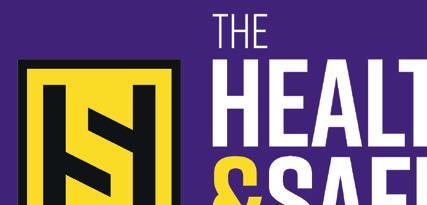
B S 2001.2 / 090223 / I M
HOW TO… BUILD TRUST

























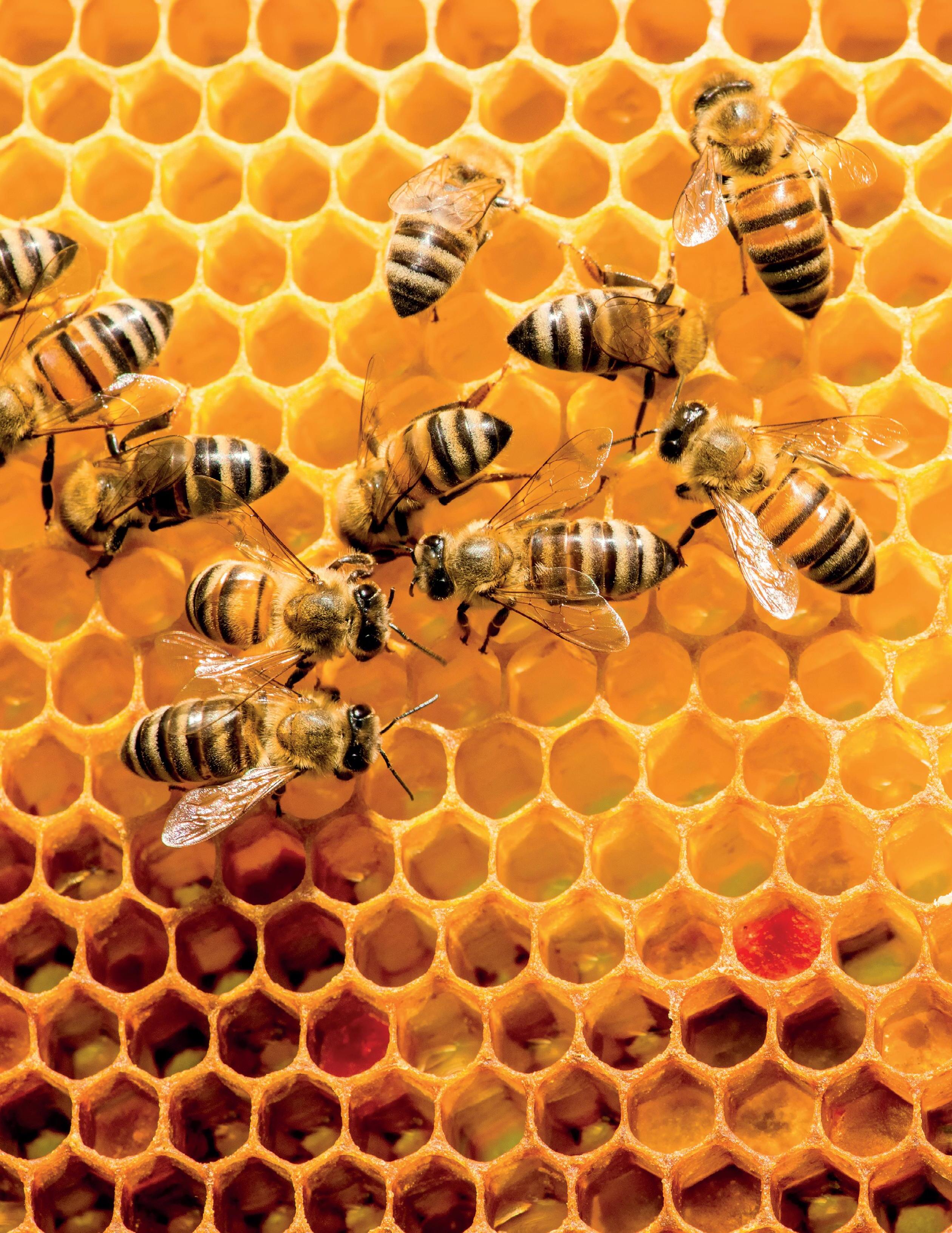
IOSH’s Angela Gray and Daniel Gray of the University of Sheffield on how OSH professionals can nurture trusting relationships with colleagues.


WORDS HELEN BIRD

THE PRACTICE SKILLS
MARCH/APRIL 2023 | IOSHMAGAZINE.COM 40
To manage safety in the workplace, people from all levels of an organisation need to listen to advice and information from OSH professionals. Trust is important in opening the door to change in order to improve health and safety, says Angela Gray CMIOSH (pictured, right), senior OSH specialist at IOSH. ‘You cannot put a process in place that doesn’t fit with the operation. If you’re asking employees to work differently – and often it’s additional processes you’re asking them to do – it has to fit in and suit them,’ she says. Being trusted helps create the conditions for improvement.
Daniel Gray (pictured, below), a lecturer in economics at the University of Sheffield, believes building trust brings positive spillovers, which can influence a range of employee behaviours. ‘For example, trust in management is likely to influence the behaviour of employees, including behaviour or actions that have a broader benefit to the organisation, which in turn affect its performance,’ he says. ‘As a result, trust, and more broadly the relationship between managers and employees, can have important implications for a firm’s performance.’ Here’s their advice on how to develop this essential skill.


Be genuine
Angela: The main thing is to bring your most authentic self to work. Be natural, be normal. It’s about showing that you’re a person: ‘I’m interested in you. Tell me about the highs and lows of the job you do. I’m not trying to be a smart-ass health and safety person. I’m not going to spout legislation. I want to be supportive; I want to understand what you do.’


Communicate well
Daniel: Good communication mechanisms are positively related to trust: if management keeps employees informed about job changes, staffing changes and organisational changes, this
Bui N N G
IT


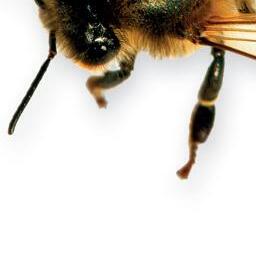
will promote trust. Our findings suggest factors that restricted pay and training opportunities and resulted in changes to the job role had negative impacts on trust; these could have been mitigated by adopting clear communication with employees (Brown et al, 2015).
Use mirroring

Angela: Speak to colleagues in the same language they talk to you. If they address you formally, you need to respond formally. Or, if they speak to you casually, be more casual with them. Mirror their style, their stance, their body language, their language and their tone. But you’ve got to be yourself, otherwise people can see through you. If you’re not being real, people know that.
Don’t use jargon
Angela: What I’ve found over the years is that professionals who come in and spout the technical stuff are the ones that people you’re trying to influence will back away from. They’ll just think: ‘You’re not listening to me; you’re not from the same planet.’ The worst thing an adviser can do is spout legislation but not understand how to interpret it in that workplace. That just annoys people and they will shut you down.
Invest in people
Daniel: Our analysis reveals that the amount of training received by employees and wages earned above the average in the industry are positively associated with employee trust (Brown
SK IL LS B





































Building behaviours
Angela explains how creating trust links to IOSH’s competency framework.
If you look at the technical aspects [of the framework], we should all know there’s nothing you wouldn’t learn when you’re doing your qualifications. The core elements – strategy, planning and leadership and management – are secondary to technical, but are always there in terms of managing change, conflict management, planning, data analysis and decision-making.
Behavioural competencies bring the technical and core elements to life.
















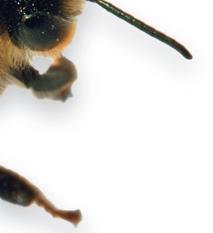
i –y’re een line


ortant talk to sten to u and .











Communication is important because you can’t just talk to people – you have to listen to what they’re telling you and read between the lines.
et al, 2015). Generally, our results suggest that if the organisation can promote initiatives that are focused on the employee – such as offering training programmes, protecting wages and job security, managing workloads and maintaining job roles – and these actions are well communicated, this can help maintain trust between employees and managers.

For the article references, visit ioshmagazine.com/build-trust

THE WORST THING AN ADVISER CAN DO IS SPOUT LEGISLATION BUT NOT UNDERSTAND HOW TO INTERPRET
IOSH MAGAZINE 41 PHOTOGRAPHY: SHUTERSTOCK
Nonverbal communication. We all know a large part of communication is not what we say, but how our bodies move when we are silent or even when talking.

I have been delivering nonverbal communication training to organisations for more than 15 years, yet most organisations have never thought about offering their staff this type of training.



This question is asked on almost every leadership course: ‘Out of all communication, what ratio is nonverbal compared with verbal?’ Most people will usually answer about 80% nonverbal compared with 20% verbal.
Presentation skills, public speaking and effective communication – training for the smaller ‘speaking at’ part is well covered. But when asked about training for the 80% nonverbal part, there is silence.







How can understanding nonverbal communication help us as safety professionals? It’s important to note body language comes from the limbic system, which is known as the ‘honest’ part of the brain. It’s an autonomous process. When someone is feeling something, they will present this in how their body reacts.






It’s summed up by a phrase: ‘People will not always tell you how they feel, but they will



always show you.’ This creates an opportunity to connect with each other on a deeper level by noticing what is not being said.
Everyone has a lightbulb moment when they start learning about body language. It’s a way of being human that connects us all, regardless of culture, age, location, industry or job role. We can use it to help deliver better health and safety performance because the real value of nonverbal communication comes from it being a powerful tool for creating a feeling of safety.
What do you think the person pictured in the panel on the right is feeling? Most people, when primed by a question, will
BODY POSITIVE

THE PRACTICE COMMUNICATION MARCH/APRIL 2023 | IOSHMAGAZINE.COM 42
Bruce Durham CMIOSH explains why understanding what is not being said is such a powerful tool.
p
start to notice body language. The problem is that, most of the time, we are too busy trying to have our voice heard (talking ‘at’ or responding) to observe others.
What we have with this man is a triple negative behavioural cluster. Note that the arms are not crossed but trying to cover more of the thoracic area – one arm for the lower part, the other for the upper. The observable difference between an armcross and this example is subtle, but the difference in feelings that has generated the change is huge. And add the nose touch to these two movements: it is one of the most powerful indicators of being uncomfortable, deceitful or exaggerating.

If they are feeling guarded, defensive or threatened, they will not connect or feel as supported as they could. As a leader, when you notice people are feeling uncomfortable, you can ask what we call empathic supportive questions (ESQs) to create a more supportive and trusting emotional platform. If you can ask the right questions, you will see a person’s whole body change and you will have a much better conversation.



This brings us to an important question for the OSH community: do you believe you get the truth from an accident investigation? Let’s be honest, not many of us do. The fact is that organisations waste huge amounts of money each year fixing things that didn’t need it because we didn’t get to the truth of what happened. This is where body language analysis can help.
If you know what ESQs to ask, you can create more psychological safety. If people feel safer, you are going to develop more trust If there is more trust, they are going to share more truthful information. If there is more information, you are more likely to be able to explore what really occurred. And if you can discover more of what really happened, you have a much more effective investigation.
Real-life power
In my last corporate role, I was the lead safety and performance coach for Siemens Gamesa, a large global renewable energy company. It had spent a fortune on ‘stop the drop’ working from

Spotting negative body language
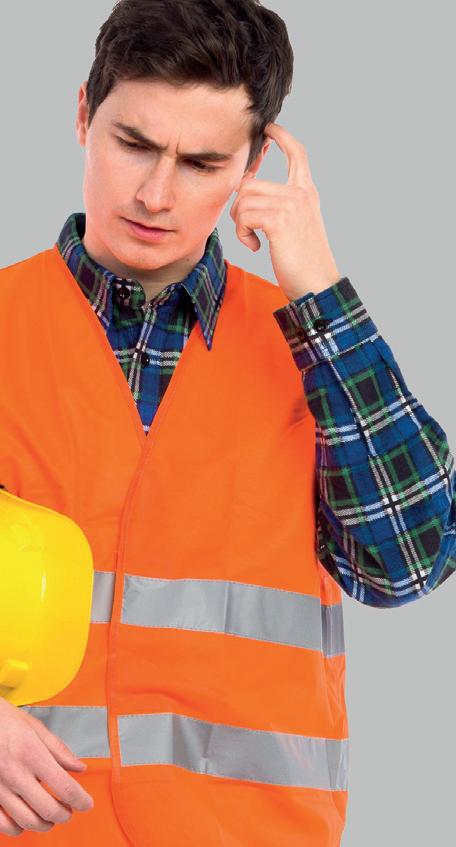
• Arms folded or held in front of the body
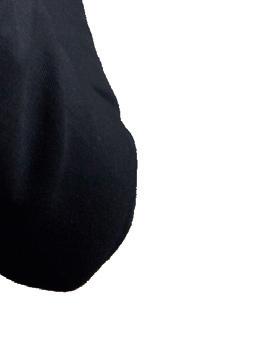
• Minimal or tense facial expressions




• Body turned away from you
• Lack of eye contact
• Nose touching
• Slumping
• Furrowed brows



IOSH MAGAZINE 43 convers PHOTOGRAPHY: ISTOCK SHUTTERSTOCK
height activities. One day I was ‘on turbine’. We were collecting teams from different turbines on our vessel when a radio dropped onto the deck of the boat. I would love to say that dropped objects are very rare, but they are not as rare as we would like. An investigation team was formed, involved parties were interviewed in line with the correct policies and a conclusion was arrived at. However, I did not fully agree with it.
I met with an involved party in the canteen. I got us both a hot drink and a bacon sandwich, and asked him to talk me through his thoughts on the conclusion. He said he had been interviewed, gave them everything they had asked for and was open and honest. I fully believed that he felt he was. Then I asked him an ESQ – but remember, we were both drinking and eating, and telling and listening to stories.
I have used this ‘campfire approach’ to great effect hundreds of times to create a safe emotional platform. No interview room, report or ‘sign here to confirm these words are exactly what you said’ requests in sight. My ESQ was based on his own situation: ‘If your kids were to ask you, “Dad, can you look me in the eyes and tell
WHAT IS THE CAMPFIRE APPROACH?
People have been telling stories around campfires for thousands of years as a way to impart information and build a community. In the workplace, a campfire approach uses less structured and formal locations and communication methods in order to improve employee engagement. A ‘campfire’ should take place outside of traditional business spaces – for example, in a cafe – using less formal seating arrangements.
How to overcome negative signals Ask empathetic support questions
Once you’ve spotted problematic body language, it’s important to seek clarity about what the negative signals mean, rather than jump to conclusions. Emotional support questions are open-ended questions that aim to learn about the individual and promote a safe space for thoughtful reflection. They show you are listening, care about what is being said and want
to understand opinions and feelings. They should be asked neutrally, for example, ‘what do you think would be the ideal outcome?’
Use empathy statements
These are short phrases that help establish a connection and create trust and understanding. They show that the other person is your focus. For example, ‘if I am understanding correctly…’ or ‘I would feel X too in that situation.’
me you are happy with the conclusion and they know everything about it?”, could you honestly tell them yes?’
This is where we had a connection that was brought about by the campfire approach, the ESQ and his limbic system. That honest part of the brain reacts automatically. He did several things at that moment: he leaned back (moving away, increasing the space between them and you, means they are uncomfortable); he crossed his arms; and he touched his nose when he said yes.
It wasn’t about him lying or concealing information. Sometimes it’s subconscious. This gave me the opportunity to know that there was more to be said, allowing me to ask better ESQs.
Benefits for all
Regardless of role, industry, culture, orientation or age, every person and every team can benefit hugely from enhancing our nonverbal communication skill-set.
Use positive body language
An important aspect of asking questions neutrally and getting a person to open up to you is your own body language. Check you’re not giving off any negative signals and think about maintaining long periods of eye contact, moving or leaning closer, keeping limbs relaxed and uncrossed and using a genuine smile to create ease.
Benefits of better conversations
• • Increased psychological safety
•
• Higher levels of trust
•
• Enhanced information accuracy
• • Lower levels of stress
• • Better mental health across the workforce
• • Happier and higher-performing employees
• • Higher-performing organisations.
Be open to the power of enhancing your skill-set around nonverbal communication because the benefits of helping people to feel safer, more connected and listened to are vast.
Bruce Durham CMIOSH is a performance psychology coach who delivers employee performance enhancement and engagement programmes for Huddle Culture. For more details, visit huddleculture.com
THE PRACTICE COMMUNICATION
MARCH/APRIL 2023 | IOSHMAGAZINE.COM 44












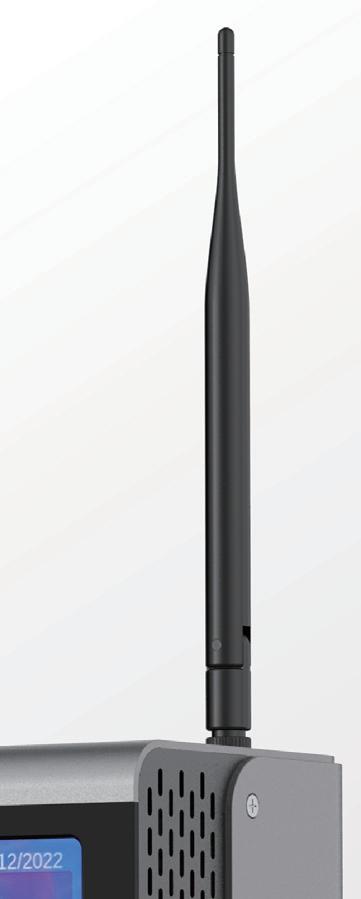










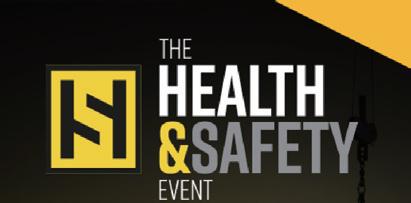
H ow we can help • Information at a glance • Keep track of current and up and coming projects easily • Improve your departments performance • Manage resources more efficiently • Standard or tailor made tel 01732 871 417 web www.tcardsdirect.com PERSON TAKING RESPONSIBILITY FORACTION NEAR MISS / ACTIONHAZARD ESTIMATED COMPLETION DATE DETAILOFACTION TAKEN A proven management tool to help keep track, allocate and improve efficiency Special Offer System only £95.00 inc 200 T Cards + P&P and VAT • Maintenance Requests • Continuous Improvement • Staff In/out • Weekly Planners PLANT NAME REF. LOCATION BRIEF DESCRIPTION OF NEAR MISS HAZARD DATE REPORTED BY SUGGESTIONS FOR IMPROVEMENT TIME SHIFT A = CRITICAL (LIKELIHOODOFFAT NEAR MISS / REPORTHAZARD ABC 0003 PLANT NAMEREF. LOCATION BRIEF DESCRIPTION OF NEAR MISS HAZARD DATE REPORTED BY SUGGESTIONS FOR IMPROVEMENT TIME SHIFT YLOSSOFBODY PART OR SIGNIFICANT L NEAR MISS / HAZARD REPORT ABC 0002 PLANTNAMEREF. LOCATION BRIEFDESCRIPTIONOFNEARMISS/HAZARD DATE REPORTEDBYSUGGESTIONSFORIMPROVEMENT TIME SHIFT ORSIGNIFICANT NEAR MISS / HAZARD REPORT ABC 0001 Other Standard boards include: Compliance made easy with the ASYS dBELL Indoor Air Quality & Noise monitoring system Flexible tools for workplace monitoring, environmental studies ASYS dBELL 110 (IAQ) & 108 (noise) ASYS dBELL 100 24/7 area monitoring of workplace dust, fume and noise +44 1463 711890 Stand 2/F4







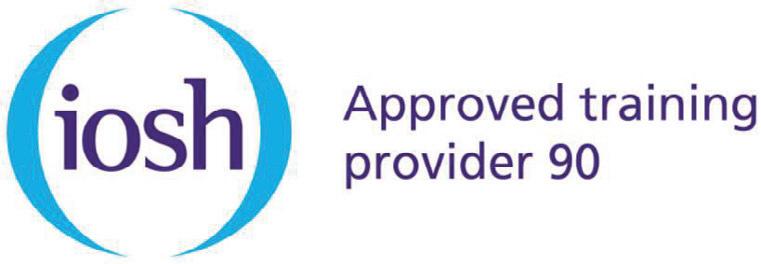
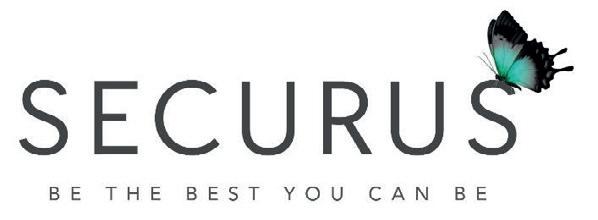

What do you think when you hear the word ‘drone’?
Annoying ‘toys’ that invade privacy and shut down airports? Or a tool to enable safer working at height? Over the past five years their global use across a host of industries, including oil and gas, agriculture, construction and manufacturing, has gone through the roof. They are so ubiquitous you can pick up a camera-enabled drone for as little as £20 online. This raises the question: why do we not use them more to help manage safety at work and, more specifically, to complete work at height?
In the UK, the Work at Height Regulations 2005 – specifically, regulation 6(2) – state ‘every employer shall ensure that work is not carried out at height where it is reasonably practicable to carry out
the work safely otherwise than at height’. Other countries have a version of this rule. It is arguable that with the requirements to prevent hazards – and drones’ relatively low cost and ease of use – they would be a practical solution to working at height. But are they? Yes – and no.

We should always consider drone use in the first instance. Falls are a global problem accounting for an estimated 684,000 deaths
(WHO, 2021). In the UK, according to the GB Health and Safety Executive (HSE), 123 workers died in 2021-22, with the largest cause being falls from height, accounting for 29 fatalities (HSE, 2022). The US National Safety Council analysed data from the US Department of Labor and reported that 645 workers died and 49,250 were injured in 2020 alone (NSC, 2021). Across the EU, slipping, stumbling or falling account for 15.3% of fatal accidents – the second highest cause of fatalities (Eurostat, 2019).
If drones can help reduce injuries and fatalities, I believe we must consider using them. However, airspace regulation creates the largest barrier to integration and casts doubt on whether drone use is reasonably practical or not. Due to the technology’s rapid acceleration, regulation around the world has been playing catch-up. Western countries have tightened their regulations
THE PRACTICE OPINION
PHOTOGRAPHY: ISTOCK IOSH MAGAZINE 47
Neil Blacklock CMIOSH, SHEQ adviser at Rainham Industrial Services, explains why companies should consider whether drone use is right for them.
significantly: CAP 722 in the UK, EU Aviation Safety Agency Easy Access Rules for Unmanned Aircraft Systems (Regulation (EU) 2019/947 and Regulation (EU) 2019/945) in Europe, and Federal Aviation Authority part 107 of title 14 in the US. All have been updated in the last few years to mixed approval.

The wild west days when drones could fly almost anywhere are over, mainly because of congested airspace around dense urban centres. Although all workplaces in a defined jurisdiction such as the UK will be subject to the same rules, the term ‘reasonably practical’ is the major driver in whether drone inspection is adopted as regulatory and administrative requirements have become a bigger barrier.
Barriers to use
To operate a drone in line with EU and UK regulations you need to be trained to a level relative to the complexity of the operation. Drone operations are split into three categories: open, certified and specified.
The ‘open’ category is the lowest risk: flying in a field in open airspace with no dangers and the drone in sight at all times. ‘Certified’ is for more complex operations with objects in the way – again, the drone must remain in sight. ‘Specified’ is for the highest-risk operations: a training course is required. These qualifications add a technical barrier to drone operations.
The administrative side of managing a drone system is also a hurdle, but one that should lend itself to OSH professionals. Every flight conducted for work purposes should include a risk assessment if operating in the certified or specific categories. An operations manual will also be required in the UK. Although the Civil Aviation Authority helps with pre-defined risk assessments, the paperwork can mount up and be complex. There are also requirements for insurance.
Why should we be using drones?
The reality of creating an in-house drone programme for most small- to mediumsized enterprises wouldn’t be practical. However, an external drone service provider (DSP) is an alternative. The drone services market has been growing, with PwC estimating it will be worth £45bn to the UK economy by 2030 (PwC, 2022). Many DSPs take on the administrative burden, removing that barrier. For a one-off cost, any task can be completed. For example, the oil and gas industry uses drones extensively to reduce the costs of inspecting pipelines, rather than hiring a helicopter crew.
Drones are also not subject to airspace regulation if they are operating inside
an enclosed space such as a building. Warehouses, for example, have high ceilings and shelves. Drones are being used to stocktake, giving real-time feedback.
This technology is being used effectively to solve numerous problems and remove humans from hazardous situations. The sooner we adapt and adopt drones into everyday practices, the sooner we could reap the safety benefits.
To view references for this article, visit ioshmagazine.com/drones-height
Driving drone superhighways
Coordinated standards and regulations for drone use are needed if the technology is to be used to its full benefit, worldleading experts recently told the UK government. The autonomous or remotely piloted drone market is likely to flourish and form an integral part of the world economy (Future Market Insights, 2022).
Commercialising the use of drones could save businesses £22bn by 2030 (PwC, 2022), but the Drone Delivery Group (DDG), the UK’s top authority on the technology, made up of more than 400
industry experts, said the government must lay regulatory foundations.
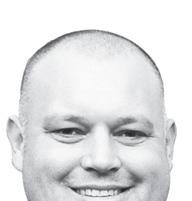

Robert Garbett, chairman of the DDG, said the UK needs ‘a harmonised and coordinated approach to standards and regulations, across land, sea and air, in order to realise the benefit for generations to come’.

In January, the group delivered a white paper, A national strategy for drones across land, sea and air, to the UK government, presenting a national strategy for commercialisation,
with the aim of safely accelerating growth.
John Haffenden, CEO of the DDG, said: ‘Without a solid strategy, operational chaos, reduced safety and data security will be the result in what will continue to be a predominantly manned transport environment.’
As well as delivering new jobs, PwC (2022) estimates that a bestcase scenario for 2030 of 900,000 drones in the UK’s skies would take hundreds of thousands of vehicles off the roads and reduce carbon emissions by 2.4 million tonnes.
Neil Blacklock CMIOSH
£45BN
The estimated worth of the growing drone services market to the UK economy by 2030
THE
MARCH/APRIL 2023 | IOSHMAGAZINE.COM 48
Source: PwC, 2022
PRACTICE OPINION
Havsco developed the first personal Hand Arm Vibration dosimeter, which measures and records the actual vibration exposure at the point where the vibrations enter the hand, when using power tools. No reliance on inconsistent data, irrespective of which tools are used, how they are used or what they are used for, the HAVSense dosimeter measures real exposure with no programming or changing data when swapping between tools. No guesswork, calculations or time recording, just simple HAV exposure measurements.


Measure personal exposure from tools, tasks, processes or even products, empowering you with real exposure data entirely to suit your operations and requirements.
Contact us for a free, no obligation demonstration at your location.
IOSH MANAGING SAFELY IN LOGISTICS

Examples of some of the additional subjects covered in this new course include:

•Safe use of racking
•Safe use of forklift trucks and recharging
•Coupling & uncoupling

•Preventing drive offs
•Use of compactors and bailers
•Use of knives
• Shift work
Feedback from attendees on previous courses include:
“ Excellent course , good warehouse examples and good workbook”
“ Very job relevant and good range of specific subjects”
“ Dynamic and knowledgeable trainer, good workshops and discussion”
“DCT are currently presenting this course for managers and supervisors at NISBETS national catering supplier”
Contact Dave Coggrave or one of his team at DC Training & Consultancy

T: 01788 561123 or 07879 620917
E: david@dctraining.com or dctraining@btconnect.com
www.dctraining.com
N.B. In company courses only
•Parcel handling
•ADR
•Final mile/fulfilment
New approved IOSH course
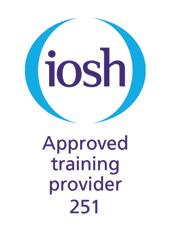

Ltd - 01692 400635 - tech@havsco.co.uk - www.havsco.co.uk
HAVSco
PEOPLE Knowing your
WORDS MATT LAMY
The renewable energy sector is an exciting place to be. But its rapid growth, the sheer breadth of its operations and its need for expertise in a wide range of areas mean that keeping health and safety in full focus is a constant challenge. To tackle these issues, RES (Renewable Energy Systems) held a face-to-face
global company stand-down in 2022 with the aim of understanding and changing safety behaviours through psychology.
The company feels the effects of safety challenges acutely. As the world’s largest independent renewable energy company, it has been at the forefront of the


We explore how world-leading renewable energy group RES staged a global company-wide stand-down day to understand and improve safety behaviours.
THE PRACTICE CASE STUDY RES is active in 11 countries MARCH/APRIL 2023 | IOSHMAGAZINE.COM 50
industry for over 40 years, delivering more than 23 gigawatts (GW) of projects and supporting an operational asset portfolio exceeding 10GW across onshore and offshore wind, solar and energy storage, transmission and distribution. It is active in 11 countries, which makes creating a unified, company-wide safety culture difficult.
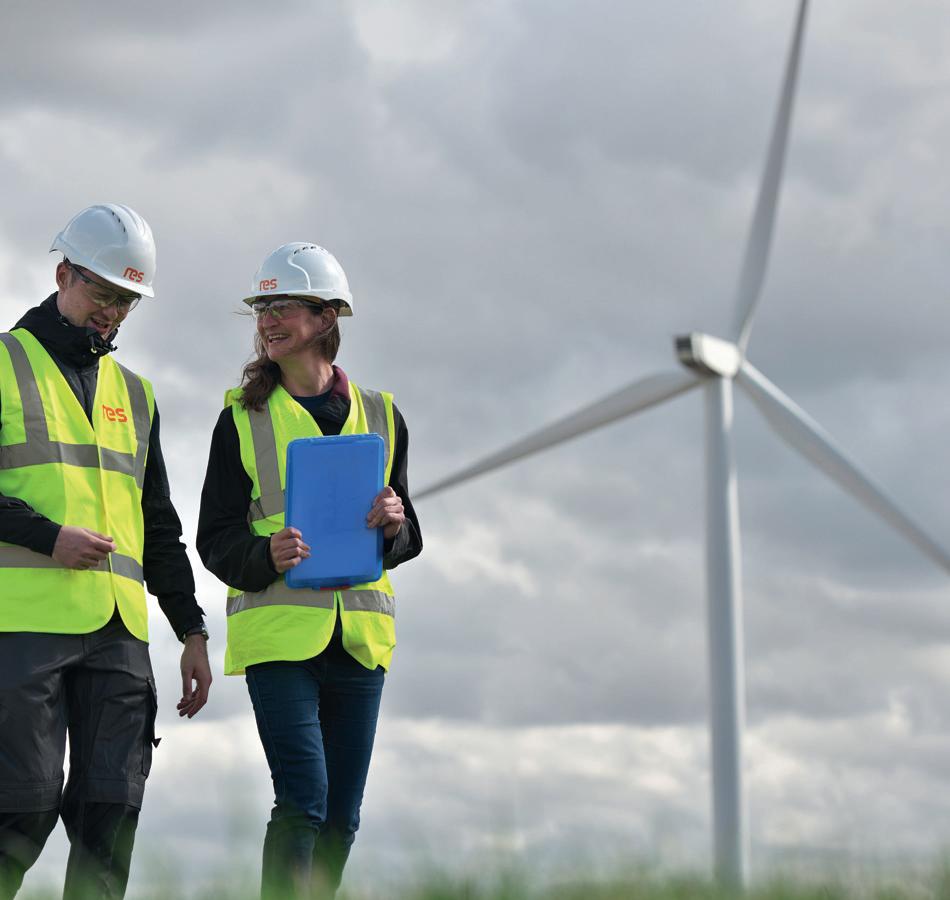
But the greater challenge, RES group HSQE director Dr Michael SinclairWilliams (pictured, right) says, is that its operations are active across such a wide range of areas and disciplines. ‘In renewables, we bring together quite a large collection of different people from different industries. In each of these areas, there is a very different safety culture,’ he says.
‘Just to compound matters, the different renewable sectors themselves – wind, solar, battery storage and green hydrogen – are very different and are all experiencing significant technological change. So we are working in quite a complex environment with microcosms of lots of different safety cultures.’

The project
Inspired by the book The Fearless Organization by Amy C Edmondson, Michael felt it was important to foster a company-wide safety culture in which people felt empowered to speak up. This idea was enthusiastically supported by RES’s senior leadership, who implemented a safety culture survey in 2019 using the UK’s HSE Safety Climate tool (books.hse.gov.uk/ safety-climate-tool).
‘The survey brought out three key areas
Objectives
of interest. One was procedures, so we’ve been looking at making them easier for people to understand.
‘The second was near-miss reporting. We’ve just finished our year-end and we’ve seen a 20% improvement in near-miss reporting.
‘But the most important area the survey highlighted was risk-taking behaviours,’ Michael says.

To understand why risk-taking behaviours were happening, RES organised a group-wide
standdown day for safety – the first Safety Focus Event – held remotely during the lockdown period of 2020. That event brought up further important points of interest, not least the need to influence behaviour and make sure people understood why they need to work safely. These learnings then fed into the goals for a second, face-to-face global Safety Focus Event in 2022.
The stated objectives for RES’s 2022 Safety Focus Event were for people to:
• Identify their own appetite for risk and the consequences of their behaviours
• Recognise the hazards that can lead to dangerous situations
• Think before putting themselves and others at risk and feel confident to support each other to make the right choices.
For the safety culture survey and the two events, RES worked closely with the GB HSE’s Health and Safety Laboratory in Buxton, UK, and especially with its human factors technical lead Phoebe Smith. Phoebe and Eric Michrowski, a US-based psychologist from Propulo Consulting, a safety culture advisory and training firm, designed sessions for RES’s 2022 event.
The aim was that, through psychology, RES would be able to understand and change behaviour crucial to improving safety performance in the workplace.
‘We recognise that it’s part of human nature for people to feel the urge to take risks, even though employees know RES is completely committed to making sure everybody goes home safely.
‘We identified that RES staff do everything with passion, but that means they might work extra hours or do something that exposes them to risks that we wouldn’t want them to take,’ Michael says.
‘We concluded that what we really wanted with the Safety Focus Event in 2022 was to create a nice smooth handover in terms of safety from the developers and the commercial teams to the construction teams, and then onwards to asset management and operations and maintenance teams. And the only way we could achieve that is to get under the skin of why people take risks.’
PHOTOGRAPHY: RES KEITH ARKINS
IOSH MAGAZINE 51
EXECUTION
The second RES Safety Focus Event was held in May 2022, with staff meeting physically at their own in-country events across 60 global locations. ‘We staggered events to fit in with local time zones, but they were synchronised in a lot of ways. We had a steering committee which was chaired by our chairman but, importantly, we asked the operating business rather than the HSQE leaders to run the events in their respective countries,’ Michael says.
‘The day was generally broken up into two parts. The first part was very much led by the group agenda, while the second was led by country-specific issues. For example, in Australia, mental health and wellbeing were really important. In Turkey, dealing with earthquakes was equally critical. This ability for country teams to focus on their own interests in the afternoon helped to make it more real for them. The other thing we did was set the leadership tone. Our chairman and our group CEO, plus the CEOs of our three business units, opened and closed the sessions in every country.’
The Safety Focus Event’s activities were designed to be interactive, offering people the opportunity to talk openly with one another. A key part of the day was a session during which participants were asked to bring a photograph to represent who or what they want to keep themselves safe for.
In the UK and Ireland region, organisers invited Gary Gallagher, a UK health and safety motivational speaker, to share his story of falling from height. They also issued a series
OVERSIGHT
Beyond reality
The idea to run Safety Focus Events is one of a number of measures RES is taking to improve safety across its business.
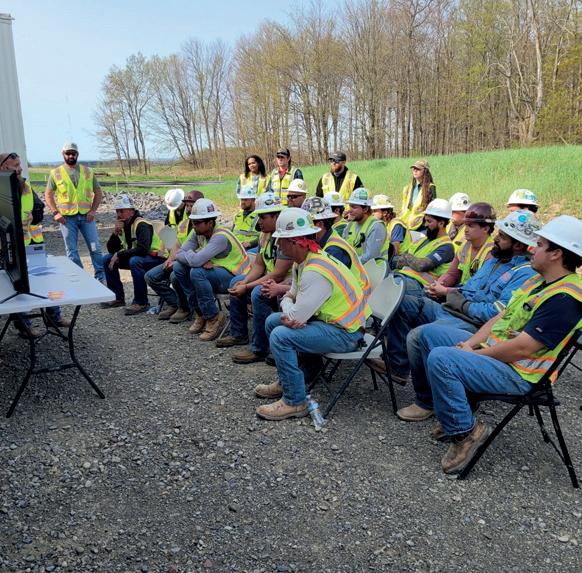
‘Our next step is to look at mixed reality. A lot of people use virtual reality or augmented reality, but
mixed reality is where the two are brought together,’ Michael says.
‘We are piloting Microsoft HoloLens, and we’ll use that to see how we can provide better levels of oversight and training and improved
of tips about keeping safe based on RES’s organisational message on safety: ‘Don’t Risk It.’ These tips described the positive behaviours expected of RES employees onsite to prevent accidents and near misses.
‘The other concept of the stand-down day was to get people who didn’t normally have site experience out to site. In Scandinavia, for example, our developers and our finance people in Stockholm had never been out to a site, so we took them,’ Michael says.
‘We copied that elsewhere. It summed up the notion that we are one company, and we should have one safety philosophy.’
RESULTS
A feedback survey after the 2022 Safety Focus Event found that most participants said they now felt confident or very confident to act on their concerns about safety. Many comments also showed that participants were able to identify
7,913.05TWH
awareness. We put a business case forward for that last year, and that has been approved.
‘We’ll be testing HoloLens this year with senior authorised persons working in highvoltage electricity.’
the consequences of their behaviours and think before putting themselves and others at risk.
Such has been the success of the Safety Focus Events, the psychological basis behind them is now being used every day – with leaders using open questions at team meetings and using behaviour change techniques to keep safety front and centre.
‘In terms of future Safety Focus Events, the global events will probably be every two years, with a smaller event in between. We will be supporting each country to do its own event in 2023, albeit on a smaller scale, then in 2024 we are going to do another global event. To me, it’s very difficult trying to capture raw facts from events like this,’ Michael says. ‘However, our safety performance in terms of lost time started in 2018 with a lost time accident frequency rate of around 0.27, and we’ve just closed our year-end at 0.05 accidents per 100,000 hours worked. We’ve seen a year-on-year reduction of 81% over four years. So I think the metrics are all going in the right direction.
Source: Ritchie et al, 2022
‘We’re changing our KPI this year to adopt total recordable incidents rates instead, which is a more granular level. And we’re looking forward to finding ways to continue to make improvements on our performance year-on-year.’
Is
THE PRACTICE CASE STUDY
your company or organisation running a project to improve OSH? Get in touch at editorial@ioshmagazine.com to tell us about it.
Global energy provision supplied by renewables
Iceland has the greatest proportion of energy supplied by renewables
86.87%
FAST FACTS
Energy in focus
6.45% in 1965
13.47% in 2021
MARCH/APRIL 2023 | IOSHMAGAZINE.COM 52
Global primary energy from renewables


























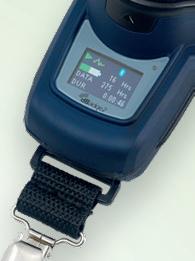












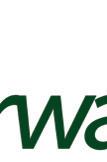







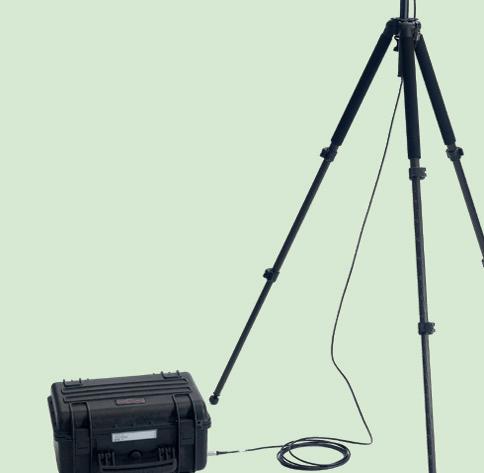










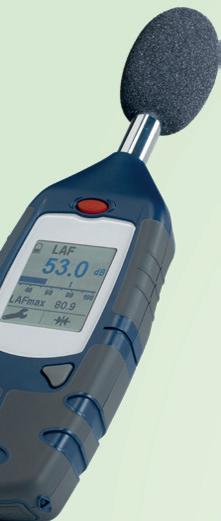































Regent House, Wolseley Road, Kempston, Bedford, MK42 7JY UK T:+44 (0)1234 844100 E:info@casellasolutions.com casellasolutions.com Sound Level MetersNoise Dosimeters Noise Monitoring Solutions • Portable system to enclose the 630 series instrument • Simple operation with audio recording • Lockable IP65 case for protection • Frequency analysis • Time history storage with large memory Environmental Monitoring Dedicated software for data analysis, monitoring & reporting • Simultaneously measures all workplace parameters • Intrinsically safe • Motion sensor to validate measurements • Models for all requirements • Easy data download & analysis • Simple to operate • Sound Level Meter kits available • Workplace & Environmental options available o or r nts nt De D diicat y anaalysis l si S Si lt t ementts & anaalysis General Use Workplace Environmental & Workplace
OSH AND THE CLIMATE CRISIS

FIRST AND

FOREMOST
We explore the OSH role in managing growing pressure on first responders from climate change-related extreme weather events and disasters.
 WORDS KIMI CHADDAH
WORDS KIMI CHADDAH
THE PRACTICE CLIMATE CRISIS
MARCH/APRIL 2023 | IOSHMAGAZINE.COM 54
The impact of the changing climate became devastatingly clear last year. In the UK, 2022 was the warmest year on record (Met Office, 2022). In Pakistan, record-breaking monsoon rainfall culminated in flash floods and landslides, killing at least 1265 and affecting 33 million people (Reliefweb, 2022). In Portugal, France and Italy, intense heat, dry conditions and strong winds generated the optimum conditions for wildfires, which also raged across Australia and America.
While not all extreme weather events and disasters can be directly attributed to climate change, they are becoming more frequent, deadly and destructive under its influence (US Environmental Protection Agency, 2022). A recent study suggested the summer heatwave in India – where temperatures reached 50°C – had been made 30 times more likely by the climate crisis (World Weather Attribution, 2022).

Changing risks
Climate change-linked extreme weather and disasters are exacerbating the risks for emergency responders, who have been identified as a population of concern exposed to climaterelated risk (Pedersen et al, 2021).
The increase in wildfires (UN Environment Programme, 2022), for example, creates more risks for firefighters, such as being exposed to more smoke or becoming trapped. ‘There’s a particular focus at the moment on the carcinogenic effect of fire contaminants – any product that breaks down chemically under combustion – and these by-products are deposited on PPE and firefighters’ skin,’ says Dave Walton, deputy chief fire officer at the Yorkshire Fire and Rescue Service. This is leading services to change regimes around the wearing and storing of PPE and postincident procedures.
‘Every firefighter is trained in the wearing of self-contained breathing apparatus,’ explains Dave. ‘While this is usually worn when firefighting internal compartment fires, it is increasingly being worn in outdoor incidents.’
Meanwhile, attending devastating events and the clean-up activities that follow, such as recovering bodies, can culminate in traumatic injuries and psychological stress. Dave is particularly worried about the ‘cumulative effect of numerous smaller incidents rather than the one high-impact, high-trauma event’.
This concern is shared by Dr Barry Levy, co-editor of Climate Change and Public Health and adjunct professor of public health at Tufts University School of Medicine in the US, who notes that first responders may be witnessing different and greater tragedies than they have seen before. For that reason, ‘preparedness planning also needs to consider the aftermath of extreme events – when victims and emergency responders may be suffering from psychosocial problems’. The heightened level of OSH risk speaks to a wider problem for the emergency services. ‘Whether from [the risks posed by] climate change or other independent, compounding factors, the fire service is having trouble attracting qualified applicants and retaining skilled firefighters,’ says Ryan Heffernan of the International Association of Fire Fighters, a union representing paid fulltime firefighters and emergency medical services personnel in the US and Canada.
events
Recruitment challenges were also identified as some of the most significant issues for the sector at the 2022 US Fire Administrator’s Summit. ‘As long as this challenge remains, understaffing will increase the risks to firefighters and victims due to the suboptimal numbers
PHOTOGRAPHY: GETTY
IOSH MAGAZINE 55
Preparedness planning also needs to consider the aftermath of extreme
of human resources to protect life and property,’ says Ryan.
‘Disaster response is labour- and emotion-intensive: therefore, there is an increased risk of injury, both physical and behavioural,’ he continues. ‘These factors negatively affect the existing workforce and, if not addressed, could lead to people electing for a career change.’
Changing OSH priorities
The role of OSH professionals in keeping first responders safe is gaining importance in light of the climate crisis. ‘The important part for OSH professionals is understanding the environments in which they either work themselves or their organisations cover – they could cover multiple sites,’ says Mark Parsons, chair of the IOSH Health and Social Care Group and assistant director of health and safety at Swansea Bay University Health Board.
‘If industries are mainly outside, it might cover looking at what clothing they have on – whether there’s a kind of PPE they should be looking at, or any assistance they may require,’ he adds.
Working through action cards – which clearly detail the responses needed in critical situations to mimic a disaster – will strengthen an organisation’s capacity to respond, Mark suggests. It’s also important to ensure staff are kept safe, informed and prepared for severe weather events. ‘Having robust up-to-date risk assessments and business continuity plans that are communicated regularly – as well as disaster drills based on scenarios – are important,’ he adds.
Actively engaging with the issues presented by the climate crisis – and equipping first responders with the skills to respond to them – is key for OSH professionals. It’s important to ‘undertake SWOT [strengths, weaknesses, opportunities and threats] analyses to understand their knowledge and skills – it’s not a blanket “you need to do X”,’ says Mark. Finding these gaps enables professionals to identify the training required.
OSH AND THE CLIMATE CRISIS
New responders
As extreme weather events and disasters become increasingly common, more professions could be forced to take on the role of first responder.
Teachers
Following climate disasters, teachers need to attend to students’ needs as well as convey information. This can affect the mental health of the teacher and place them in unsafe conditions. Following Hurricane Katrina, research indicates around a quarter of teachers struggled with post-traumatic stress disorder (24%) and depression (25%) (Costa et al, 2015).
Care workers and nurses
The second Lancet Countdown report (Watts et al, 2018) found that risks created by climate change could add to the threat of a ‘systemic failure’ of the world’s hospitals. In climate-driven disasters, older people are most at risk (National Council on Aging, 2022). In-home care workers in California are being trained for disasters (Center for Caregiver Advancement, 2022).
According to Pedersen (2021), communication skills – which are covered by the IOSH competency framework – are a crucial means of conveying the evolving risks to industries and workers, as well as engaging with representatives for stronger OSH protections.
Developing knowledge around hazard and target populations, surveillance of occupational hazards and development of new adaptation strategies have been identified as three prime focuses (AdamPoupart et al, 2013).
Facing the future
Do we need new paradigms or models for addressing the increasing pressures the climate crisis is creating for first responders? Not necessarily, says Barry. ‘We can reasonably anticipate the nature of most of these infrequent events, but we often do not know when they are going to occur or how frequently.’ Mark agrees, adding that there are ‘plenty of policies and guidance already in place – the UK Health and Safety at Work Act and the aim to transition to zero carbon by 2050 are some examples (UN, 2022). The important part is embedding and adhering to what’s already out there.’
‘What we’ve got at the moment is not fundamentally broken,’ says Dave, ‘but it needs adapting to reflect the changing nature and frequency of the risk,’ including building active partnerships with local authorities. Barry also highlights the need for multiagency working. ‘Preparedness planning needs to involve multiple sectors of society, not just medical care, public health and public safety.’
‘All systems need to have surge capacity,’ he continues. ‘They must respond not only to day-to-day occurrences, but also to extreme weather events, heatwaves and other occurrences that require additional competent people, appropriate equipment and advance preparedness planning.’
The climate crisis is exposing emergency responders to heightened short- and longterm health risks, including psychological stress. However, OSH professionals can use preparedness planning, communication and surveillance to develop a proactive approach to tackling the challenges of a changing climate.
To see references for this article, visit ioshmagazine.com/climate-emergency
THE PRACTICE CLIMATE CRISIS
MARCH/APRIL 2023 | IOSHMAGAZINE.COM 56
Continue your professional development with the IEMA Foundation Certificate in Environmental Management

Improve your environmental sustainability knowledge, understand the risks of climate change and be part of the solution with IEMA’s five day course. Covering a wide range of environmental, sustainability and governance principles, this course will give you an understanding of the breadth of the sustainability agenda and the management tools and skills you will need to act.

iema.net/training
now
Book
T H E BUSINESS
ELEVATE OSH IN YOUR ORGANISATION
the truth Nothing but
As greenwashing continues to undermine progress on sustainability, we explore whether ‘OSH-washing’ is an equally concerning issue.
WORDS CLAIRE MOULDS
The practice of greenwashing – where an organisation inflates its environmental credentials by misrepresenting facts or withholding information – is in the spotlight as consumers seek out companies committed to sustainability.
Is there a growing danger of ‘OSHwashing’ too – cherry-picking or manipulating safety data such as accident figures – as companies try to paint themselves in a positive light? ‘OSHwashing is already very prevalent,’ says Kate
Field CMIOSH, global head, health, safety and wellbeing at BSI. ‘The reality is it’s easy for organisations to manipulate figures and, as these are based on lagging indicators, they also fail to reflect how proactive a company is in terms of OSH.’
It’s a sentiment echoed by Tom Powdrill, head of stewardship at Pensions and Investment Research Consultants (PIRC).
‘Based on our analysis of annual reports, it’s clear that selective presentation of safety data is widespread because companies can choose their own metrics.’

Worse still are those companies that do not record vital data in the first place. Debbie Berkowitz, practitioner fellow at the Kalmanovitz Initiative for Labor and the Working Poor at Georgetown University in the US, says: ‘In meat and poultry plants in the US, government agencies, unions and community organisations have all found that companies actively endanger injured workers by delaying and denying care, because if they don’t send them to a doctor, they don’t have to record it in their official injury log.’
Trust is everything
Organisations around the world have never before come under such scrutiny, thanks to social media, public interest in social issues and increased activism. And while positive employee word of mouth can make employers desirable, negative word of mouth can spread far and wide.
If it directly contradicts how organisations have promoted themselves, this may damage reputations, shake investor confidence and undermine trust. It’s not just about being open about OSH but also about being honest.
IMAGE: GETTY
MARCH/APRIL 2023 | IOSHMAGAZINE.COM 58
‘I think the move to ESG [environmental, social and governance] reporting is helping, although it’s far from flawless,’ Kate says. ‘Many stakeholders don’t understand OSH and therefore don’t know what metrics are genuinely meaningful. Plus there’s a lack of consistency, so different companies use different formats and data.’
Tom agrees: ‘A lack of standardisation makes it hard for stakeholders to assess performance, which is particularly frustrating as investor interest in OSH issues has risen noticeably. However, interest doesn’t equate to understanding, so OSH professionals need to educate investors on what really matters.’
Kate says that to really make a difference, the OSH sector should follow the example of financial reporting, which is subject to an independent audit. ‘That’s the sort of rigour we need to see implemented,’ she says.
Consistency is key
In a bid to eradicate greenwashing in the UK, the Competition and Markets Authority introduced its Green Claims Code in 2021 to protect consumers from misleading environmental information, while the Financial Conduct Authority opened a consultation in 2022 on new rules to ensure consumers and firms can trust a product’s
sustainability claims. Is greater regulation, standardisation and oversight required in the OSH arena too?
‘Current international standards, such as GRI 403, don’t go far enough. To raise the bar, we need a global consensus on meaningful OSH reporting,’ says Kate.


‘The new IS0 45004 will provide guidance on how to monitor, measure, analyse and evaluate OSH performance, with a focus on leading, as opposed to lagging, indicators. This will enable an organisation to show it’s genuinely taking its health and safety responsibilities seriously.’
Kathy A Seabrook CFIOSH, CEO and founder of consultancy Global Solutions Inc, agrees an international standard for OSH could be on the cards: ‘As government legislation, litigation and voluntary standards have all come into play to counteract greenwashing, it’s reasonable to anticipate that using these same control measures would incentivise companies to focus on reporting and disclosing accurate, globally recognised OSH metrics to deter potential future OSH-washing.’
Be the conscience
OSH professionals have a duty to highlight OSH-washing in their organisation and are also perfectly positioned to act as a catalyst for change. Executives say that the two biggest barriers preventing their company from progressing on ESG issues are balancing them with growth targets and a lack of reporting standards and regulations/ complexity (PwC, 2021).
As trusted advisers, OSH professionals can educate management on why focusing on human capital is fundamental to value creation and not a trade-off between ESG and growth. Until reporting is standardised, they can also help the company to navigate pitfalls by presenting examples of best practice and benchmarking against competitors.

Crucially, they can also ensure that OSH is embedded in a company’s culture. Because, ultimately, transparency needs to start from within.
compmpan a y re ets and a egulati t ons/ ssiona n ls l y tice c and rs s that cul u tuure r y ne n eds s to t













MEASURING AND REPORTING
Tips to avoid OSH-washing
• Are you trying to present the best picture, or an accurate one, to stakeholders?
• Think about what you’re recording and why – are you focusing on the right indicators?
• Are you presenting a combination of leading and lagging indicators?
• Have you included an analysis of leadership and culture, which are critical to the management of human capital?
• Do you have robust evidence for every claim you’re making?
• Are comparisons fair and meaningful?
To see references for this article, visit ioshmagazine.com/OSH-washing
cle, e, washing
• Just because something is difficult to measure doesn’t mean it shouldn’t be measured.

• Don’t just focus on the good – be honest about challenges with stakeholders and where you need to improve.
• Are your systems able to collect the data you need?
• How can you continually improve the process?
• Catch the Wave: a report on effective OSH metrics will be published later this year.
IOSH MAGAZINE 59
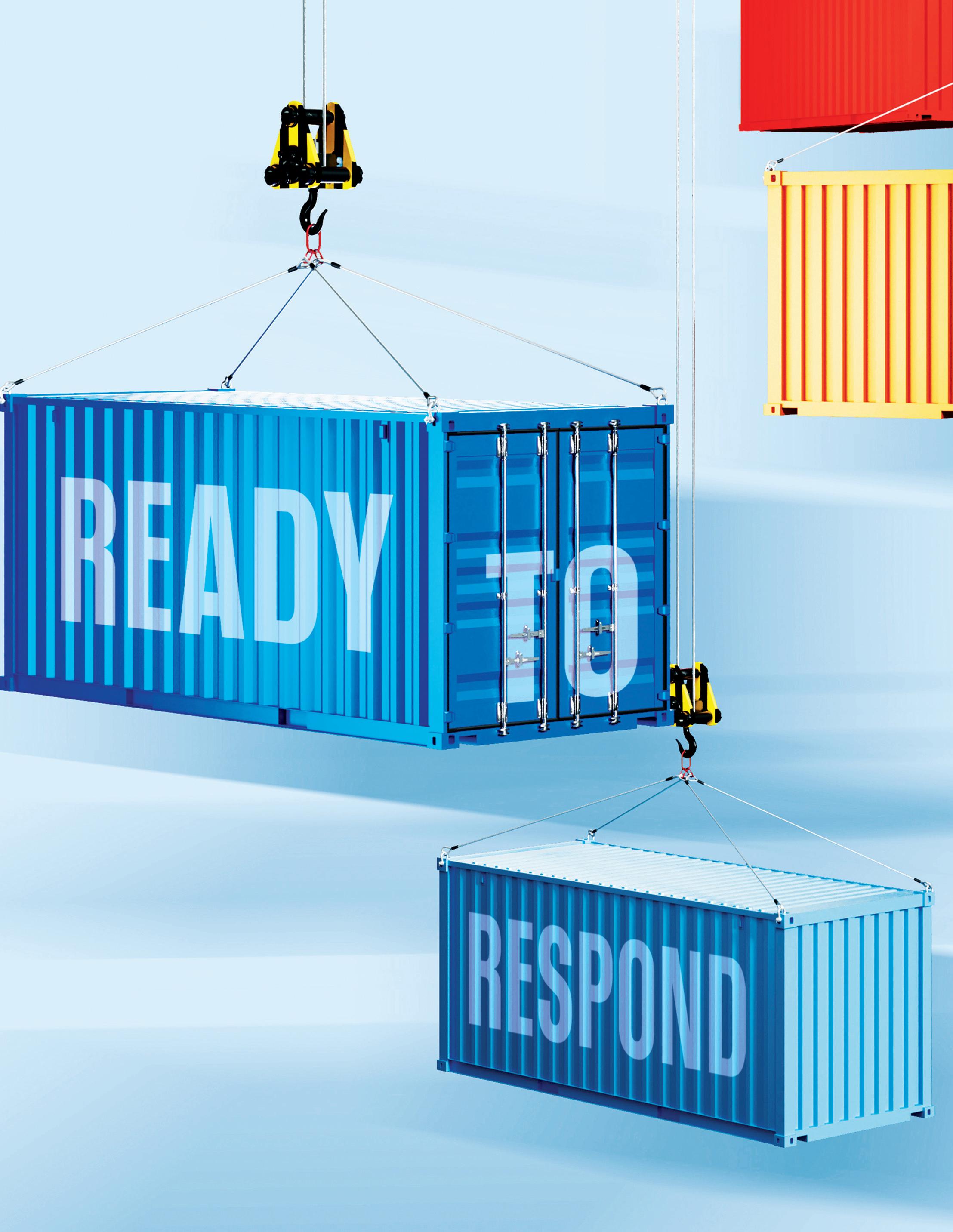
Businesses are often reliant on complex supply chains, which can make them vulnerable to crises. Here’s how OSH professionals can support business continuity.
THE BUSINESS CRISIS
MARCH/APRIL 2023 | IOSHMAGAZINE.COM 60
WORDS NICK WARBURTON
MANAGEMENT
In 2015, PECB Insights magazine published the findings from a survey of 500 risk managers and experts from 40 countries who were asked to identify the top 10 business risks in the Europe, Middle East and Africa (EMEA) region (PECB, 2018): 44% placed the risk of supply chain interruption at the top of their list.

Fast-forward five years, and most were caught off guard by the COVID-19 pandemic and the disruption it brought to the network of products and services provision that characterises the global supply chain.

As Brexit, the container ship blocking the Suez Canal and the war in Ukraine further illustrate, businesses that are reliant on extensive supply chains must maintain the complicated logistics that enable the just-in-time economy. However, businesses will remain vulnerable to changing circumstances, particularly if they are dependent on a single or a few suppliers (see panel The case of semi-conductors in Taiwan).
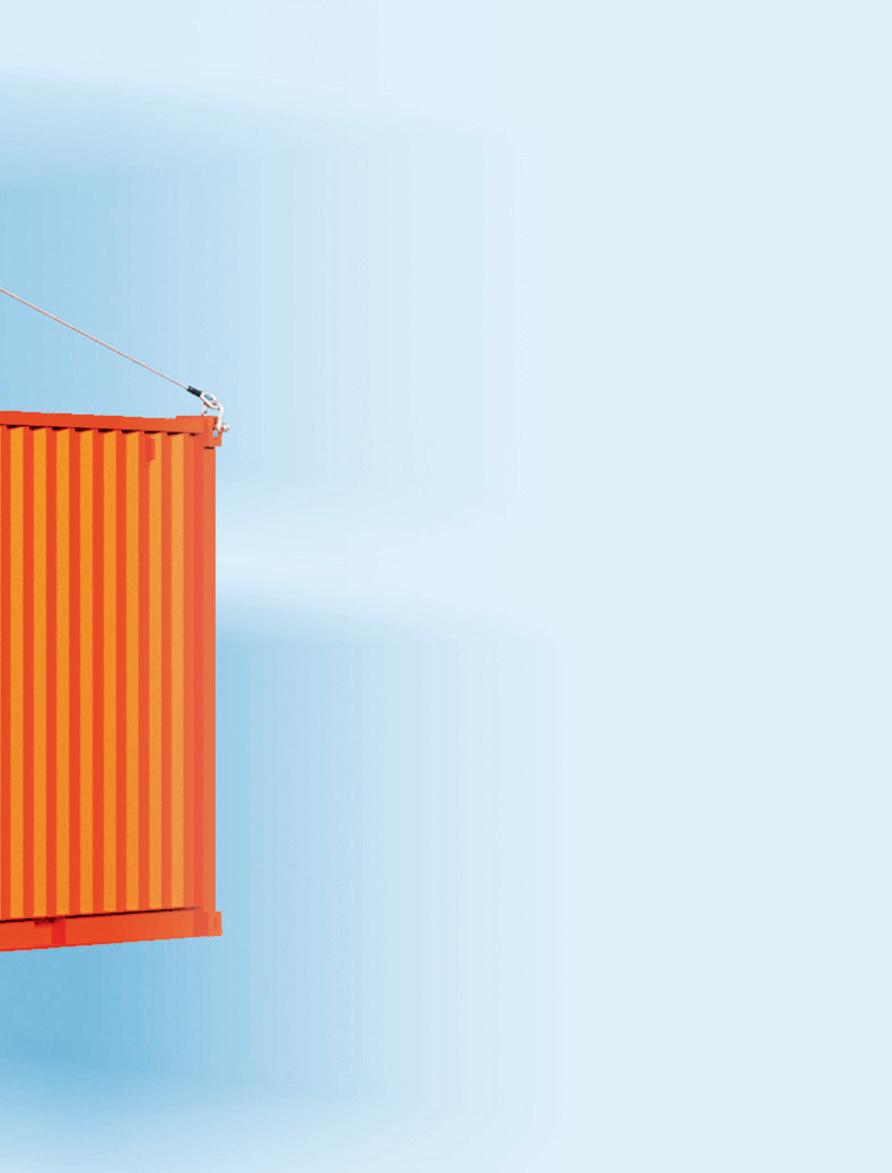

Russell Clark (pictured), vice-president, operational risk, DHL Supply Chain UK&I, observes from the perspective of a global logistics provider: ‘Business continuity has a vital role to play amid supply chain disruption as companies try to maintain operations and critical functions despite ongoing challenges.’
Jason Johnson CMIOSH, crisis and continuity manager at Inverroy Crisis
Management, concurs. He believes the pandemic has been a huge wake-up call for businesses, leading many to reassess their supply chain management with a renewed focus on business objectives and how they can be sustained in the event of a disruption.
Robust auditing


However, he warns many still don’t pursue a proactive approach to managing risk in their supply chains, and advises businesses to undertake a robust top-to-bottom audit.
‘When you complete your contracts, especially in relation to your supply chain, you haven’t just got to go to your main contractor – you’ve got to speak to their subcontractors, just to make sure you have got that robust A-Z supply,’ he explains.
An important point to consider when planning for – and responding to – any crisis is that supply chains are typically sector-specific. This will significantly influence the level of disruption and, as a consequence, the requirements of any business continuity plans.
Angela Gray, a senior OSH specialist at IOSH, has gained significant experience working in manufacturing, a sector that has an extensive supply chain for raw materials and finished products. Not only did the business for which she worked have its own continuity plans, but so did its critical suppliers. She says partnership dialogue was critical to finding resolutions when there were disruptions and alternative suppliers needed to be sourced.
Any discussion also needs to consider that disruption will impact businesses in different ways – depending on their size and whether they are a supplier, an end-user or, in some cases, both.
Professor David Walters from Cardiff Work Environment Research Centre at Cardiff University, who has co-written several IOSH reports, was part of a team

CRISIS ALERT The case of semiconductors in Taiwan
While the war in Ukraine has dominated the headlines, another potential conflict in south-east Asia could cause huge disruption to the global economy. The Taiwan Semiconductor Manufacturing Company (TSMC) produces advanced chips critical to high-tech industries.
According to the European Institute for Asian Studies, TSMC accounts for more than half of the global foundry revenue (Trendforce, 2021), while in the manufacturing of advanced chips below 10 nanometres, it controls nearly 85% of the global market (European Institute for Asian Studies, 2021).
In a worst-case scenario, an invasion or blockade of Taiwan by China would result in a severe disruption to the global supply chain, forcing end-users to consider their options.
(Asia Financial, 2022)


IMAGE: GETTY
IOSH MAGAZINE 61
that published a large review of OSH practices in micro and small firms for EU-OSHA in 2016 and how likely they are to respect OSH in the supply chain (EU-OSHA, 2016).
‘Decisions are often taken based on price and delivery considerations. If a company is promising to deliver and produce things as cheaply as possible then it’s likely they are going to cut corners and they are not going to do OSH properly,’ he warns.
‘The challenge for the OSH professional working with micro and small firms is how you can ensure that you are in the right place at the right time to contribute OSH advice and ensure that advice is adhered to by the micro and small firm?’
Challenging considerations
Angela notes that large operators face a growing list of upstream and downstream considerations. Those that sell on a product from a supplier have a duty of care to consumers and that means making sure they are safe and of a high standard. She adds: ‘There is such a diverse level of risk in your downstream supply chain that you really need to think it through at a top level.’
This means OSH professionals need to undertake a huge amount of due diligence to provide assurance businesses are working with the right partner, especially if the product falls into the high-risk category. She stresses that ‘picking your supply chain partners is critical to your business reputation’.
In addition to quality and safety, other ethical considerations can do real damage to a business if they fail
to properly audit suppliers. The list is extensive, but includes modern slavery and poor work practices down the supply chain and sustainability issues such as guaranteeing products, and their component parts, are from legitimate sources.
This is where IOSH’s socially sustainable OSH model Catch the Wave comes in, encouraging businesses to understand the value of their human capital and set high standards for their workforce, communities and supply chains.
Angela says the importance of having strong strategic partnerships with critical suppliers is that these considerations can all be worked through together. Good procurement teams will also understand the frameworks behind the products being sourced.
Even so, these teams will also be under immense pressure to secure the lowest price, and in this respect the relationship with the supplier must be mutually beneficial to avoid creating additional risks further downstream.
OSH’s role in supply chains
OSH professionals can have an important role in supply chains by ensuring practicable and thoroughly tested emergency plans are in place, says DHL’s Russell Clark. However, this does not translate into business continuity and resilience when a business faces an incident.
‘In reality, OSH professionals must thoroughly assess points of exposure, understanding a business in its entirety, including upstream and downstream supply chain interactions,’ he argues.
IOSH RESOURCES

• Catch the Wave: iosh.com/catchthewave
• IOSH competency framework: iosh.com/ media/6715/competencyframework-allcompetencies-v2.pdf
A growing number of OSH professionals in businesses are either taking on dual responsibility for emergency response and crisis management, or moving from one role to the other.
Jason Johnson, who has done the latter, warns that some individuals can become overwhelmed by the workload in a crisis situation. Although the OSH professional has the skills to do both roles, it requires adaptation, he argues. ‘You are gathering information like in a risk assessment, but unless you speak to the expert who deals with that area every day, your business impact analysis is not going to be accurate and your continuity plans are going to fail on day one.’
Training and guidelines
OSH professionals possess a suite of technical skills that they can draw on when risks are identified in the supply chain. Angela identifies areas in IOSH’s competency framework they can bring to the fore when a crisis emerges. One of the most important is demonstrating visible leadership.
‘They are not going to hear you if they don’t trust you. One of the competencies is being the trusted adviser, so that entire stakeholder management piece is really important because that is about your collaboration and negotiation skills.’
To view references for this article, visit ioshmagazine.com/crisis-supply-chain
THE BUSINESS CRISIS MANAGEMENT
MARCH/APRIL 2023 | IOSHMAGAZINE.COM 62 ILLUSTRATION: ISTOCK
Large operators face a growing list of upstream and downstream considerations
Keep your team safe with MyTAG’s integrated RAMS and Training Academy
MyTAG RAMS is an intuitive, easy to use, cloud-based Health & Safety software that allows you to create and manage Risk Assessment and Method Statements (RAMS) digitally. It helps companies manage and mitigate the risks their employees and other people face, while ensuring
The integration between MyTAG RAMS and MyAcademy enables you to seamlessly manage risk assessments, method statements and employee training in one place. By keeping your team safe and compliant with the latest safety regulations, you can focus on the job at hand.
ENSURE COMPLIANCE
alerts when reviews are required. Integration with MyAcademy ensures that all required employee training is completed, with training records and other information accessible in minutes for auditing.
IMPROVE COMMUNICATION
Bringing all your teams together on a single platform promotes collaboration across the business. RAMS can be sent electronically to appropriate employees, who can use digital signatures to demonstrate that they have read and understood the risks and how to reduce them. All RAMS can be downloaded into a PDF with company branding, and accreditation logos, so documents can be shared with customers. Standardised training courses ensure that all employees receive the same informagained online.
and procedures.
BUILD YOUR REPUTATION
Professional RAMS and training help you to reinforce your Health & Safety performance. They enable you to stand out from your competitors, improve company image through compliance with legislation and also reduce risk to personnel and property. The MyAcademy e-learning solution, allows you to provide training for reporting suite analyses trends in training modules.

“Having researched the marketplace for dedicated Risk Assessment and Method Statement software with some disappointment, we have worked with MyTAG to develop an incredibly user-friendly solution that addresses the complexity of RAMS processes. In my view, this product is at the forefront of the Risk Management market.”

 Paul Crilly, Managing Director NJC (Not Just Cleaning Ltd)
Paul Crilly, Managing Director NJC (Not Just Cleaning Ltd)
Call: +44(0) 1752 657077 Email: help@mytag.io Visit: www.mytag.io mytag.io/rams/
DIGITAL

Transition to all-digital risk assessments and method statements (RAMS) could bring better cost and operational efficiency to the construction sector – and benefit safety. Why isn’t it happening?
WORDS JAMES HAYES
THE BUSINESS CONSTRUCTION DAWN MARCH/APRIL 2023 | IOSHMAGAZINE.COM 64
Still in recovery from the combined effects of COVID-19 and postpandemic inflation, the global construction industry can nevertheless look forward to rising prosperity in the 2020s.
Worldwide construction is forecast to grow by 3.6% a year until 2030, greater than the manufacturing and services sectors, to reach a total output of $15.2trn (Marsh and Oxford Economics, 2021).
Building booms will be driven by developed countries recovering from economic instability and emergent nations as they industrialise further.
But booms bring challenges, including heightened expectations around issues of workplace safety and health improvement.
Construction is dangerous. The question now before the industry is how much less dangerous can it be?
Lost benefits
In the UK, construction recorded the highest number of work-related fatalities of any sector in the period from April 2021 to March 2022, according to the GB Health and Safety Executive (HSE, 2022). Of the 123 workers who suffered fatal injuries in work-related accidents in the UK during that time, 30 were employed in the construction industry.

Considered relatively, the high number of deaths in construction can be partly explained by the size of the industry, which employs more workers – around 1.4 million in total – than other industries (Office for National Statistics, 2021).
But if construction is to build out its workforce to scale, keeping accident rates as low as possible will become more challenging.
As technology plays a more end-toend role in the practice and operation of construction, can digitisation also do more to improve risk management in the sector?

The construction industry has been relatively slow to embrace digitisation. This is exemplified by the difference in
approach toward the creation of risk assessments and method statements (RAMS), which are the critical construction project documents required to identify steps to be undertaken to carry out a specific activity or task safely.

Although RAMS are customarily created in a digital format, they are still often stored and shared as hard-copy documents rather than made part of an all-digital management system.
Sticking with part-digitised RAMS processes could perpetuate inefficiencies, says Rob Bullen CFIOSH, head of environment, health and safety at HandsHQ. ‘The creation and distribution of RAMS in the construction industry are too often characterised by timeconsuming, inconsistent and usually paper-based practices,’ he says.


‘Depending on a given project’s complexity, it may take a couple of days to produce a single RAMS document.’










The number of RAMS produced over the course of a year probably runs into the high tens or low hundreds for many businesses, according to Rob.
For larger firms, it may even run into thousands, with each RAMS taking hours of effort.
Rejections
The business benefits problem is compounded by clients initially rejecting many RAMS submissions, according to Jamie Carruthers, CEO at HandsHQ. ‘Poor-quality documents and lack of site-specific details are common reasons for rejection. If the RAMS is not completed to the client’s satisfaction, it may be sent back for amendment or rework,’ he explains.












RAMS rejections can have knock-on effects and introduce delays in other areas of construction safety.
‘It may be difficult to get certification for certain mandates such as Safety Schemes in Procurement and PAS 91 without well-structured method statements,’ says Nathanael Challacombe

Do RAMS deliver OSH outcomes?
An effective RAMS capability that reflects the way the job is done ‘in the real world’ is vital for safe working. The challenge comes in getting frontline colleagues and their managers to work together to ensure that all relevant risks are identified and managed on-site, without it becoming just a tick-box exercise. If technology helps to achieve this, then why wouldn’t you embrace it? RAMS digitisation simplifies best practice and provides the opportunity to accelerate continuous improvement initiatives.
Richard Byrne, group HSE and fleet director at Travis Perkins

Essentially, RAMS are the backbone of a safe system of work – so much so they arguably have a dedicated section within the Health and Safety at Work Act. Wellstructured method statements are vital for high-risk activities, as they provide planning, information and instruction – all of which are described in the Act under the general duties of employers to their employees.
Nathanael Challacombe
CMIOSH, group HSQE and IT manager at Barnwood (and chair of the IOSH Construction Group)

ILLUSTRATION: ISTOCK IOSH MAGAZINE 65
es?
CMIOSH, group HSQE (health, safety, quality and environment) and IT manager at Barnwood.
Slow to change
The construction industry’s adoption of alldigital RAMS has also been inhibited by a hesitancy to invest and an adoption lag.
‘Changing mindsets is one of the main challenges in selling [the advantages of] RAMS software, particularly in the construction sector,’ explains Alex Nichol, product director at Nutshell Apps.
‘We’ve encountered OSH professionals who feel sceptical about RAMS software, which is understandable.’
Prior to the pandemic, the high-risk ‘non-digitally native’ industries had been slower to adopt a digital-first strategy than other industries. Digitisation has since accelerated.
‘Companies within industrial sectors such as construction usually have a well-established suite of RAMS, tailored over the years for their trade or work,’ adds Nathanael.
‘Some digital RAMS solutions offer their own control measures, which may not be in line with a specific company’s established controls.’
He adds that another intrinsic drawback of most safe systems of work (SSOW) policies is that, typically, they are put together by personnel who aren’t carrying out the actual work that’s to be done.
Collaboration and communication with teams undertaking the task are therefore essential. But in practice ‘this can be difficult to achieve,’ says Nathanael.
Reinventing construction?
A line of argument exists that the construction industry’s slow-paced adoption of RAMS is introducing inefficiencies and liabilities. But it is
‘Tech stacks’: the case for several solutions







A distinguishing feature of enterprise digital transformation is its ‘tech stack’ approach to building software infrastructure, rather than relying on a single multi-featured enterprise-wide solution that promises to cover all software needs.
important that the two should not be confused, says Richard Byrne, group health, safety and environment and fleet director at Travis Perkins.
Tech stacks are an array of di ff erent applications and tools deemed best suited to a company’s speci fi c business tasks.
Along with other functions, they have become a standard model for developers to build
versatile mobile and web apps. However, tech stacks can call for extra IT management resources and expertise, and that can persuade some organisations to stick with their current approach.
mandates for those who may be regarded as sceptics.’
‘We need to be careful not to label “inefficiencies” and “liabilities” as the same thing. Paper-based RAMS are inefficient, but moving them onto a digital platform doesn’t necessarily remove liabilities.’

Given that retrograde RAMS processes seem to cause operational frustrations for the construction sector, should the greater digitisation of RAMS processes be mandated by construction industry bodies?
‘A mandated digital RAMS process is certainly something that we can see at a future point,’ says Jamie.
‘However, we are also still comparatively early in the digital tech adoption curve, and the industry needs to demonstrate success with the early adopters and pragmatists before implementing
Perhaps the current state of RAMS digitisation is an interim phase as the construction industry transitions to fuller digitisation.
According to a report from consulting firm Oliver Wyman, ‘digitisation is currently in a process of reinventing the construction industry, triggering an overall value migration from the central construction part of the value chain up to the engineering and design function, and down to facility management and operations services.’
Oliver Wyman points out that the necessity now is not simply for construction to adopt digitisation technology, but to develop a digital strategy: ‘The digital push is accelerating, and even if construction industry players are still confused and hesitant about the change and new technologies, the time has come for them to develop a real digital strategy.’
To view references for this article, visit ioshmagazine.com/construction-RAMS
THE BUSINESS CONSTRUCTION
MARCH/APRIL 2023 | IOSHMAGAZINE.COM 66
We are still comparatively early in the digital tech adoption curve
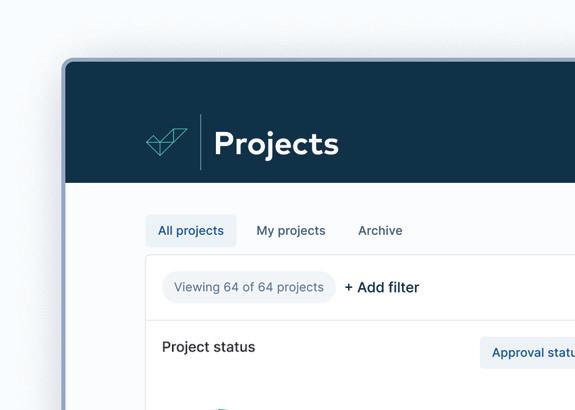

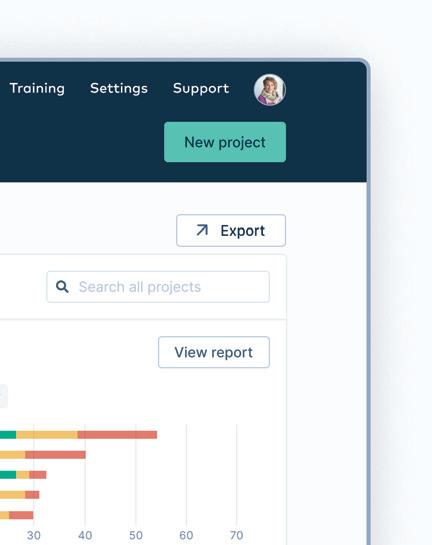





High-risk industries are facing an unprecedented combination of high material costs and a skilled labour shortage, with many order books still full from the COVID backlog. However, these industries have been slow to adopt technology that can drive considerable efficiency and optimisation.
The risk assessments and method statements (RAMS) process is one that is often overlooked. But it is one of the biggest bottlenecks in a business, with a huge hidden cost. There’s never been a better time to digitise RAMS.
Why are RAMS a hidden cost and bottleneck to businesses?
Many businesses don’t realise the amount of time spent on RAMS and the cost associated with it.
RAMS often take hours to create (we’ve even heard of days). But the costs really add up when you factor in rejections. Results from our Cost of RAMS calculator show an average RAMS rejection rate of 72%.
RAMS are constantly rejected due to them being too generic, containing out-ofdate information, not being in the correct format or myriad other common reasons. Each rejection takes precious time and resources to fix. That time could be better spent on completing work.
Frank Williamson, QHSE systems manager at Nicol of Skene, says: ‘The rejections were one of the big things we were trying to avoid, and HandsHQ eliminates that problem.
‘After we started using HandsHQ, there was a significant improvement noted across the board. Generally, the RAMS are far better and far quicker.’
What does digitising RAMS mean?
There’s a misconception that digitising RAMS simply means replacing Word templates with specialist software.
Digitisation means much more than that. Digitisation has the potential to transform
There’s never been a better time to digitise RAMS
HandsHQ explains why adopting a software solution for risk assessment method statements can save time and improve their quality, ultimately helping to deliver greater productivity and a safer workforce.
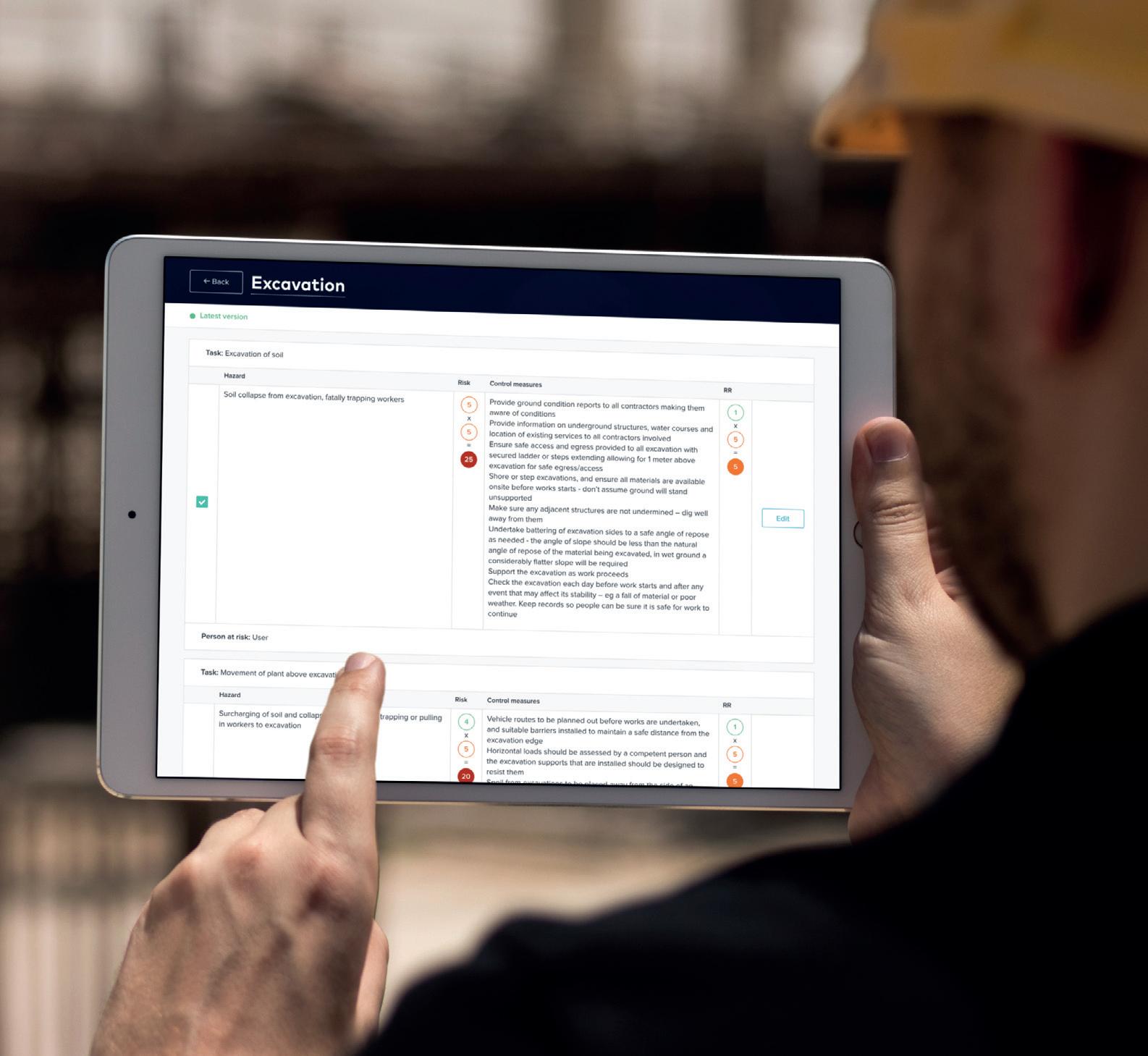
MARCH/APRIL 2023 | IOSHMAGAZINE.COM 68 ADVERTISEMENT FEATURE HANDSHQ
ABOUT OUR CEO Jamie Carruthers

Before co-founding HandsHQ in 2013, Jamie Carruthers spent more than 10 years designing web and mobile apps for major global brands, focusing on crafting an ideal user experience (UX). HandsHQ was started to fill the gap in the market for welldesigned software that makes health and safety accessible for the entire workforce. This year, HandsHQ is celebrating its 10th anniversary, and involving customers in the user journey and product design has always been part of HandsHQ’s success.
your entire risk process, including creating, collaborating, approving, distributing and reporting on RAMS using purpose-built software.
Syd Hoyle, health and safety manager at Workplace Build (Maris), says: ‘HandsHQ is a fantastic tool for the teams on-site. We also use it for our pre-construction information and design registers and for reviews of our construction phase plans. The integration with Procore is great.’

Why digitise now?
To borrow from a Chinese proverb, the best time to digitise was five years ago. The second-best time is today.
The industry is under a unique combination of pressures. Slim margins, greater competition in tenders, high material costs and a skilled labour shortage means efficiency has never been this important. If you believe you’re too
busy to consider digitisation now, your issues will only get worse.
How does a digital RAMS process improve safety?
Poorly written RAMS without effective oversight create an illusion of safety. A digitised process enables operatives to engage in RAMS through collaboration tools.
Getting RAMS into the hands of those doing the work means better RAMS, improved adherence and a safer workforce. This also frees up precious time for the health and safety team. Instead of writing RAMS, software gives oversight to the process with approval and feedback functionality.
This recaptured time can then be reallocated to various other health and safety activities such as toolbox talks, audits and inspections, further improving safety for the workforce.
‘The fact that it’s project-specific, bespoke RAMS on every site now is very different to how we used to manage it,’ says Frank. ‘Now they are bespoke to the job, they are briefed at the start of the project and they are signed. It’s a good reminder and reinforces the health and safety performance.’
Why not go for an all-in-one solution?
There are many software suites out there that allow you to create RAMS. And you may find that’s sufficient if RAMS don’t play a major role in your work.
But all-in-one solutions are broad in their functionality, not deep. They do lots of different things, none of them exceptionally well.
Rather than all-in-one solutions, we believe in the idea of a safety stack – a selection of best-of-breed software, each specialising in one thing and all connected through integrations and single sign-on.
That might sound more complex and more expensive but, often, it isn’t, and a safety stack will prove to be
much more effective with a higher return on investment.
Trevor Baker, senior HSEQ manager at Brown & Carroll, says: ‘When our RAMS go out to people now, it looks good; it looks fresh. They know we know our stuff; they think, “someone’s spent some time on this” – even if, funnily enough, it’s taking us less time. The new, improved process and better RAMS documentation mean that RAMS are no longer regularly rejected by clients.’
What are the easiest and most challenging parts of digitising RAMS?
It’s in our very nature to be fearful of change, so when people are presented with a new idea – even a good one –they’ll often initially resist it. And while digitising RAMS is certainly a good idea, you’re asking people to change the way they’ve worked for a long time.
Most enterprise software is poorly designed and difficult to use, making change even harder. However, HandsHQ is designed to be easy to use. In fact, we obsess over the user experience. While the most challenging part might be introducing the change, the easiest part is getting people up and running.


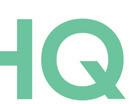
About HandsHQ
HandsHQ is the leading safety software trusted by more than 2000 companies to keep teams safe and compliant. Our purpose is to help organisations be safer and ahead of the competition with our easy-to-use software.
Get a free trial at bit.ly/HandsHQRAMS or visit us at Handshq.com
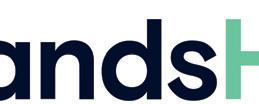
IOSH MAGAZINE 69
T H E EVIDENCE

EXPLORE THE LATEST RESEARCH
TOPIC: Inclusive workplaces


TITLE: Inclusion at work 2022: benchmarking information and recommendations to support inclusive people practice
PUBLISHED BY: CIPD/Reed



SUMMARY: Just 30% of employers say their leaders are completely committed to an inclusive and diverse workforce. This report provides an overview of what UK employers are doing to improve inclusion and diversity and the measures found to be effective. It makes seven recommendations to help people professionals reenergise their approach.

READ REPORT AT: bit.ly/CIPD-inclusion-at-work
TOPIC: Mental health
TITLE: Healthcare workers’ mental health in pandemic times: the predict role of psychosocial risks



PUBLISHED BY: Safety and Health at Work
SUMMARY: This Portuguese study assessed psychosocial risk factors and mental health.
The Depression, Anxiety and Stress Scale was used, while psychosocial risks were assessed through the Health and Work Survey. The study concluded that support network development in the work environment is needed
Up to speed













to prevent emotional stress and promote psychological wellbeing, and that more research is essential.
READ REPORT AT: bit.ly/SHW-pandemicmental-health
TOPIC: Telework and wellbeing
TITLE: Telework quality and employee wellbeing: lessons learned from the COVID-19 pandemic in Italy
PUBLISHED BY: New Technology, Work and Employment








SUMMARY: This study identifies high- and lowquality telework profiles that show how demographic, occupational and procedural characteristics are associated with positive or negative experiences. It suggests
organisations consider the quality of telework to adopt ways of working that foster wellbeing.









READ SUMMARY AT: bit.ly/NTWE-telework-quality [Full report is available to subscribers.]






TOPIC: Returning to work
TITLE: Return to work for workers with post-COVID conditions
PUBLISHED BY: Safety and Health at Work
SUMMARY: This editorial examines the issues people who have had COVID-19 face when returning to work and offers guidance. It considers difficulties in defining the disease and post-COVID conditions, risk factors for developing long COVID, how
returning to work can be an effective rehabilitation tool, the need to conduct a clinical history and an appropriate medical examination, the multidisciplinary approach required, and possible mental health implications.
READ REPORT AT: bit.ly/SHW-RtW-post-Covid
TOPIC: Automation

TITLE: Occupational safety and health with technological developments in livestock farms: a literature review
PUBLISHED BY: International Journal of Environmental Research and Public Health












SUMMARY: This US paper identifies new technology uses in agriculture. It found 624 articles on crops and harvesting and 80 on livestock farming related to robotics and automated systems. For livestock farming, most (78%) related to dairy farms, with 56% indicating they used robotics routinely. It showed gaps in how technology has been evaluated to show benefits or hazards to workers.
READ REPORT AT: bit.ly/IJERPH-agricultureand-technology
We round up some of the latest research and reports relevant to OSH professionals.
ILLUSTRATION: IKON IMAGES MARCH/APRIL 2023 | IOSHMAGAZINE.COM 70
Research: in depth
TITLE
The Musculoskeletal (MSK) Health Toolkit for employers and further education institutions
REPORT TYPE
Guide for employers on how to support adolescents and young adults to a better future
PUBLISHED BY
The Society of Occupational Medicine (SOM), the British Society for Rheumatology and the Office for Health Improvement and Disparities, 2022
BACKGROUND/AIMS
This guidance was developed by clinical experts, patient representative groups and college and university representatives, along with adolescents (aged 16 to 19) and young people (aged 19 to 25). Its main aims are to help employers and further education (FE) institutions understand the part they play in preventing MSK conditions, and set out how employers and FE institutions can support young people with chronic MSK conditions to realise their potential, thrive and remain in work or education.
KEY POINTS
Many MSK conditions are preventable if risk factors are identified early and interventions to reduce risk are implemented at work, at home and in the wider environment – which makes a good business argument for addressing the issues. Inactive people are at increased risk of MSK diseases. It is vital to support young people with MSK conditions to manage pain early and try to prevent future problems, including at work and in FE.
The guidance presents the following figures:
• 2.8 million people under 35 in the UK live with an MSK condition – a large number of whom should be entering employment.
• Depression is four times more common in people with chronic pain than those without.
• 68% of those with an MSK condition say fatigue impacts daily activities (28% say significantly).

THE EVIDENCE DEEP DIVE ILLUSTRATION: IKON IMAGES
We take a look at three recent papers to see how their findings can inform OSH.
IOSH MAGAZINE 71
Encouraging students to exercise could help treat their MSK disorders
It states that good health behaviour in young people is key to future health outcomes and sets out what employers or FE institutions can do to help prevent MSK conditions:
• Prevent workplace accidents and injuries through better health and safety procedures and risk management.
• Design offices and FE institutions with positive infrastructure – such as secure bike racks and stand-up desks.
• Encourage students or staff to increase physical activity through wellbeing programmes or funding equipment, such as bikes.
• Provide healthy food or information about nutrition to help people make better choices.
• Encourage employees and students to stop smoking and reduce alcohol consumption, perhaps with related incentives.
• Normalise conversations about, and support for, mental health – particularly around identifying and reducing stress.
• Ensure employees or students are consulted on health and wellbeing programmes and, where possible, make them reflect on the feedback garnered.
• Signpost to relevant networks dealing with counselling and mental health.
• Create general awareness about the prevention of MSK conditions and other health problems.
• Support employees and students to manage their condition in order to reduce the impact.
The guide outlines four core steps to management:
• Understand the MSK condition – recognise the impact.
• Maintain MSK health – provide accommodations as needed to manage health.
• Knowledge and training
– especially for frontline workers.
• Going further – be an ambassador for good MSK health.
Additional guidance is offered on employment considerations and how to manage work placements for FE institutions.
SOM’S TAKEAWAY
‘Many of us will be concerned with young people’s posture as they stoop over their phone or sit “unsuitably” on their laptop. This can lead to MSK conditions. Mental health problems are the greatest causes of work loss and are often interrelated. Ongoing MSK problems can also be associated with depression and/or stress, leading to increased absence from school, work or college.
‘If you work with young people, do share this MSK health toolkit with organisations in which they work. Leaders and managers need to create an environment – whether that be university, school or the workplace – that prevents MSK conditions from developing and allows people who are living with MSK conditions to meet their full potential. This toolkit is vital for employers and educators to consider.’
Nick Pahl, chief executive officer at the Society of Occupational Medicine
IMPLICATIONS FOR PRACTICE –IOSH’S TAKE
Obviously there is already a huge amount of information already out there about MSKs, but this is a valuable piece of research and guidance for our members.
In parts, it follows on from the six types of sedentary worker, and considerations such as office design (see page 71 of the January/February issue of IOSH magazine).
For the full guidance document, go to bit.ly/SOM-MSK-toolkit
TITLE
Wellbeing through workplace health promotion interventions by European enterprises
PUBLICATION
Safety Science
BACKGROUND/AIMS
The objective of this study was to look at wellbeing and compare European enterprises in relation to workplace health promotion interventions (WHPI).
METHOD AND FINDINGS
An exploratory and descriptive study was carried out. More than 45,000 organisations were interviewed. Results suggest differences between countries in terms of the intensity and type of WHPI. The reasons include a captive audience, the ability to follow up on the effectiveness of interventions longitudinally, the follow-up of workers and a supportive environment. All are important to creating a successful health promotion programme and may well positively impact occupational health status.
CONCLUSIONS
Factors that could help explain the differences between countries could be, on one hand, sociocultural context (different rates of addictions, sedentary lifestyles or problems of obesity) and, on the other, work environment. The literature lacks the long-term exploration to demonstrate the impact of promotional activities.
THE EVIDENCE RESEARCH MARCH/APRIL 2023 | IOSHMAGAZINE.COM 72
It opens the option for future research and the need to explore the role of non-health professionals, such as the safety practitioner, in health promotion activities.
The number of OSH professionals interviewed (a quarter of the respondents) clearly reiterates their importance in health promotion. Less than 9% of the organisations represented were large in size, again reiterating the need to address OSH in SMEs.
IMPLICATIONS FOR PRACTICE –
IOSH’S TAKE
We really like this one – especially when you consider this area was the base of IOSH’s Catch the Wave campaign.
This research has the potential to really influence OSH professionals in driving much-needed change; not just implementing something and leaving the workers to it. It’s more of a conversation. For example: ‘We’ve installed this machine to help you – what are your thoughts? How could we improve things even more for you?’
To read the study in full, go to bit.ly/SS-wellbeing-promotion
TITLE
What might best practice look like for managing good sleep practice for night workers at work?




REPORT TYPE
Guide for employers
PUBLISHED BY Society of Occupational Medicine (SOM), 2022






BACKGROUND/AIMS

Providing relevant information about night shift work and best practice. Insights are given to high-risk groups on best practice activities.
KEY POINTS
Following risk assessment, avoid night work where possible if workers have:
1. Diabetes
2. Heart/circulatory disorders
3. Stomach intestinal disorders
4. Conditions that are worse at night
5. Medical conditions requiring a strict timetable
6. Factors affecting fitness for night work, such as poor night vision.
Best practice
1. Introduce and implement a health and wellbeing policy with an effective risk assessment.









2. Choice for night-time workers. When night shifts are introduced without choice, a quarter of workers can leave that job role.
3. Suggested best pattern: two to three nights on, two to three nights off
4. Management training in managing shift patterns.
5. Education on how to sleep better.
6. Access to support, such as sleep monitors and sleep masks.
7. Employers must offer workers a free health assessment before they become a night worker.
SOM’S TAKEAWAY
‘With so many resources available, SOM saw a gap in guidance for employers on best practice as there appeared to be common confusion around the definition of night workers and the employer’s legal obligations to offer initial and regular health assessments for all night workers. The scope could not extend beyond a summary of best practice, which includes the suggested best pattern of two to three nights on followed by two to three nights off.’
Christine Poulter, lead author
IMPLICATIONS FOR PRACTICE –IOSH’S TAKE

This guidance has strong links to the estimates of the work-related burden of disease and injury report (WHO and ILO, 2021). Having this best practice guidance could be an invaluable support in managing the health implications of shift or night work.
For the full guidance document, go to bit.ly/SOM-good-sleep-practice
ILLUSTRATION: IKON IMAGES IOSH MAGAZINE 73
Further research could explore the role of OSH professionals in health promotion
Fu could the ro profe healt
PEAT BOG SAFETY A big push on
these remote locations close to our works,’ says Stephanie Coyle, Adman’s safety, health, environment and quality manager.
Peatland contains fewer solids per cubic yard than milk, but ‘most of the time you’d never know by looking,’ adds Stephanie. The water is not always apparent, which can catch out the inexperienced. ‘It’s possible to sink deeply into a peat bog, and most related fatalities are caused by a combination of stress, panic, exhaustion and hypothermia, not by being sucked under,’ Stephanie says. ‘Waving your arms and legs about does not get you out – it may pull you further under.’
The judges praised the initiative as a practical response to a very real health and safety issue in the workplace, adding that the entry demonstrated innovation throughout and pointed to a lasting legacy.
Apioneering approach to rescuing people from peat bogs has shown how health and safety learning can prevent workers – and the public – from getting into trouble.
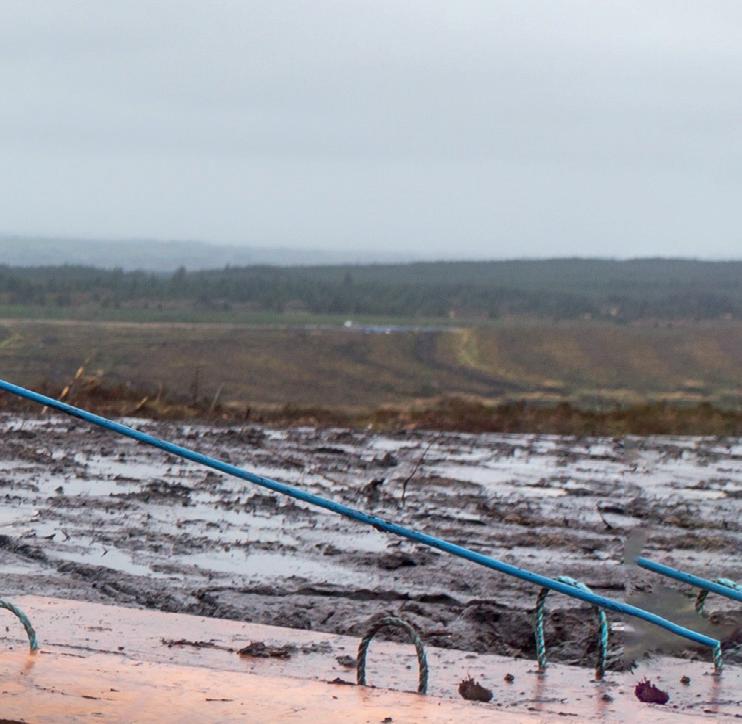




Omagh-based Adman Civil Projects Ltd, a specialist civil engineering contractor, claimed first prize at the Safety Groups UK (SGUK) Awards for Innovation, in November, for its development of a peat-and-bog land emergency rescue and drill plan. The awards recognise innovative work to raise the standards of health and safety.
The company, which operates mainly in the electrical infrastructure and renewable energy sectors, regularly works close to peat bog lands as wind turbines are often located on hills, in areas of natural beauty or close to nature walks.



The plan was developed after the senior management team identified – via risk analysis and research – the need for enhanced information, knowledge sharing and practice drills for peat bog rescue across the wind energy communities.
Peatland covers about 10% of the UK land area – nearly three million hectares – and can be anything from a few centimetres to an average maximum depth of six metres (20ft) (International Union for Conservation of Nature, 2023).

‘We always have safety exclusion zones in place within work perimeters. But the importance of expanding our knowledge and sharing it among communities and the wider industry really came to the forefront during the COVID-19 pandemic, when our site teams began to flag the presence of more members of the public out walking and climbing in
As well as the innovation prize, Adman was also highly commended for the SGUK Development Through Education Award for its holistic approach to education and development, winning praise for the way it engaged workers and the wider community, including rescue services, and provided a strong model to follow.
Sonomatic RAIS claimed second place in the innovation category for its magnetic laser cleaning and inspection crawler, with judges praising its technical response to risks related to the entry of vessels for cleaning and inspection.
Craigie High School in Dundee, Scotland, was highly commended for innovation for its ‘Watch your back’ video on back injuries. The school’s project also claimed first prize in the Development Through Education category.


More information on the free-to-enter SGUK Awards can be found at safetygroupsuk.org.uk/awards. Entries for all awards opened on 1 February 2023.



To see references for this article, visit ioshmagazine.com/SGUK-Adman

PHOTOGRAPHY: ADMAN THE LAST WORD PROOF POSITIVE
Adman Civil Projects’ new emergency rescue plan has claimed top prize for innovation at the SGUK awards. We find out why it’s so important.
MARCH/APRIL 2023 | IOSHMAGAZINE.COM 74
WORDS SALLY HALES



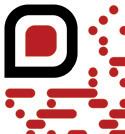



sales@cirrusresearch.com www.cirrusresearch.com +44 1723 891655 Let’s work together to prevent the damage noise causes to people’s hearing Download your free eBook today: bit.ly/CirrusIOSH23 We make measuring and monitoring noise easier, helping you to keep people safe from the dangers of excessive exposure with instruments such as the helps you make with equipment that’s compliant with Enjoy peace of mind that you will always have access to support
“It’s been a very informative and transformative journey for me!”
“Excellent value for money, brilliant service.”
“Our Company chose HSQE to provide industry training services on the strength of a recommendation from a client. I am very pleased that we took their advice as the course content and customer support has “A very interesting course and super helpful tutors!”

We have an in-house team of IEMA & IOSH-approved tutors

Our courses are 100% online & can be started immediately
Our courses work on PCs, tablets & smartphones
Our customer support team are available 7 days a week
You get a free dashboard to monitor course completions
We’re rated 4.8 / 5 on reviews.co.uk & as ‘outstanding’ by IOSH

Approved training provider 980 Scan the QR code for more information Approved training centre Approved training provider 980 IOSH, IEMA,
online
RoSPA, IATP & CPD approved / assured courses 100%
























































































































































































































































































































































































































































































































































































































 WORDS KIMI CHADDAH
WORDS KIMI CHADDAH






















 Paul Crilly, Managing Director NJC (Not Just Cleaning Ltd)
Paul Crilly, Managing Director NJC (Not Just Cleaning Ltd)
































































































































